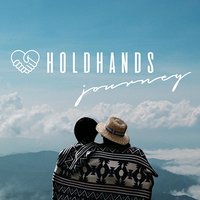Hello, it's been a long time since I've been traveling and writing reviews. Life has been quite busy due to the ongoing Covid-19 pandemic. There have been many uncertainties and changes during this time. However, it's hard to give up on traveling, especially when I'm working hard and need a break to clear my head. This trip took a lot of thought because I was traveling alone, which meant no one to share expenses with and no ability to drive. Everything had limitations, including budget, transportation, and time. For these reasons, this trip ended up being to **Sukhothai Province**.
Trip Summary
Duration: 2 days 1 night (excluding travel days)
Travel Dates: September 27-28, 2020
Destinations:
- Day 1: Wat Traphang Thong and Morning Market, Sukhothai Historical Park, Wat Si Chum, and Ban Na Ton Chan Homestay
- Day 2: Huai Ton Hai Viewpoint
Number of Travelers: 1 person
Transportation: Tour bus and minibus
Cost: 3,017 Baht
Notes:
- This review is based on the reviewer's personal expenses.
- The photos in this post were taken with an iPhone SE and Sony a6000 and edited using VSCO and LR.
Things to do before traveling
For this trip, we stayed at a homestay in Ban Na Ton Chan, Si Satchanalai District, Sukhothai Province. Once you have set your travel dates, it is recommended that you book your homestay as soon as possible. This is because the Ban Na Ton Chan homestay group only has about 29 houses. Even though we booked two weeks in advance, all the houses were full. This meant that we had to reduce our trip to 1 night and 2 days. You can contact the homestay to book your accommodation, view photos of the homestay, read the accommodation rules, and see the activity schedule at Facebook: Ban Na Ton Chan Homestay, Sukhothai Province https://web.facebook.com/HomeStayBannaTonChan?_rdc=1&_rdr
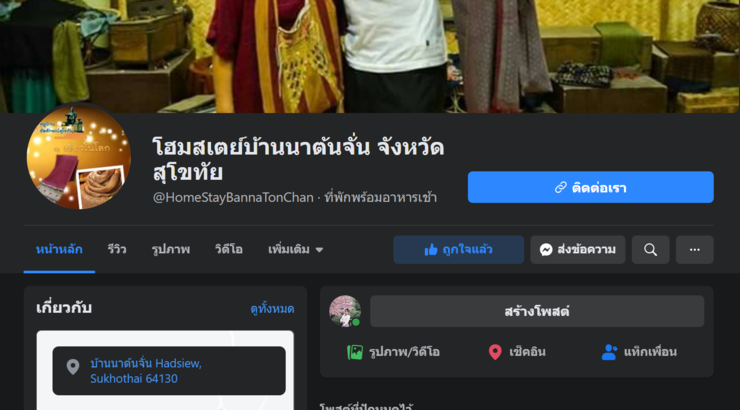
For our bus transportation, we chose the Transport Co., Ltd. (BKS) because their buses pass through Sukhothai Historical Park, also known as the Old Town or Muang Kao (note that there are multiple bus stops, so be sure to check carefully). In the morning, we plan to participate in the alms offering ceremony at Saphan Boon Bridge at Wat Traphang Thong and then cycle around the historical park. The BKS bus schedule is therefore suitable for our plan, with the 10:00 PM bus arriving at the stop in front of Wat Traphang Thong around 5:00 AM. Another advantage is that tickets can be booked online and paid for at 7-Eleven stores, with an additional service charge of 20 baht. We called the BKS Call Center to inquire about boarding at Rangsit Bus Terminal, and the staff informed us that if passengers wish to board at Rangsit, they should call the Call Center after completing payment. However, there are not many bus schedules available, so it is advisable to book in advance. We traveled on a Saturday night, and all seats were full. You can check the bus schedule at the following link: https://booking.busticket.in.th/index.php

DAY 1: Alms Giving at Saphan Boon
We boarded the tour bus at Mo Chit Bus Terminal. Remember, after paying for the bus ticket at 7-Eleven, keep the receipt safe as you will need it to get your ticket at the counter. The staff will tell you which platform the bus is parked at. If this is your first time taking a tour bus here, it's best to arrive a little early as there are many platforms. This will also give you time to stock up on food and take care of any personal needs. However, if you don't have time to buy snacks, don't worry, there are beautiful staff members on the bus who will distribute snack boxes, instant coffee with hot water, and a bottle of drinking water. Warning! Please have drinking water ready when eating the bread.

The bus stopped at a rest stop for passengers to have dinner. Passengers could use the coupons attached to their tickets to exchange for food. However, we felt it was too late for a heavy meal, so we continued to sleep. A staff member brought drinks for passengers who did not get off the bus. There were about 2-3 drinks to choose from. We chose green tea with grape flavor.
We then slept on and off as passengers got on and off the bus. At 5:00 AM, we arrived at the Sukhothai Historical Park stop, or the old town in front of Wat Traphang Thong, next to the Wat Traphang Thong fresh market. It was not dark or deserted. There was a 7-Eleven nearby and a morning market. At the end of the market, there was a bathroom that charged about 2-3 baht. The bathroom was clean and had a sink for washing your face and brushing your teeth.
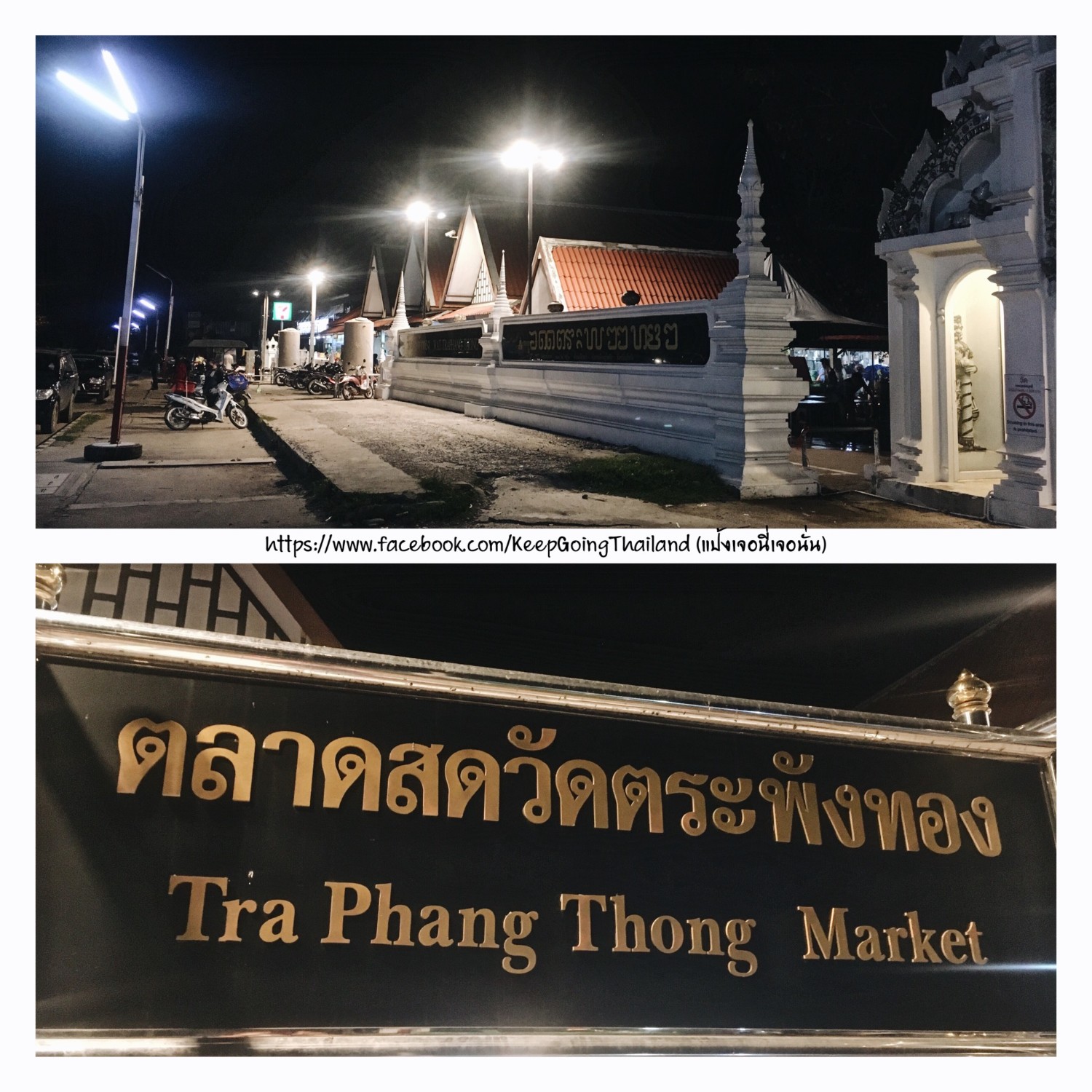
We bought a set of offerings at the market for 35 baht each. The kind vendor allowed us to leave our belongings at her shop, reminding us to take all valuables with us. We then walked to the wooden bridge in front of Wat Trapang Thong and waited there. We were the first to arrive before dawn, as the vendor told us that the monks would start their alms round at around six o'clock. While waiting, we took photos. The morning air was pleasant, and the atmosphere was peaceful, with a hint of eeriness as no one else was around. Initially, we wanted to grab some food at the market, but we were afraid of missing the monks, so we decided to wait quietly by the bridge. We were excited about making merit on our own, but also worried about making mistakes and incurring sin instead.
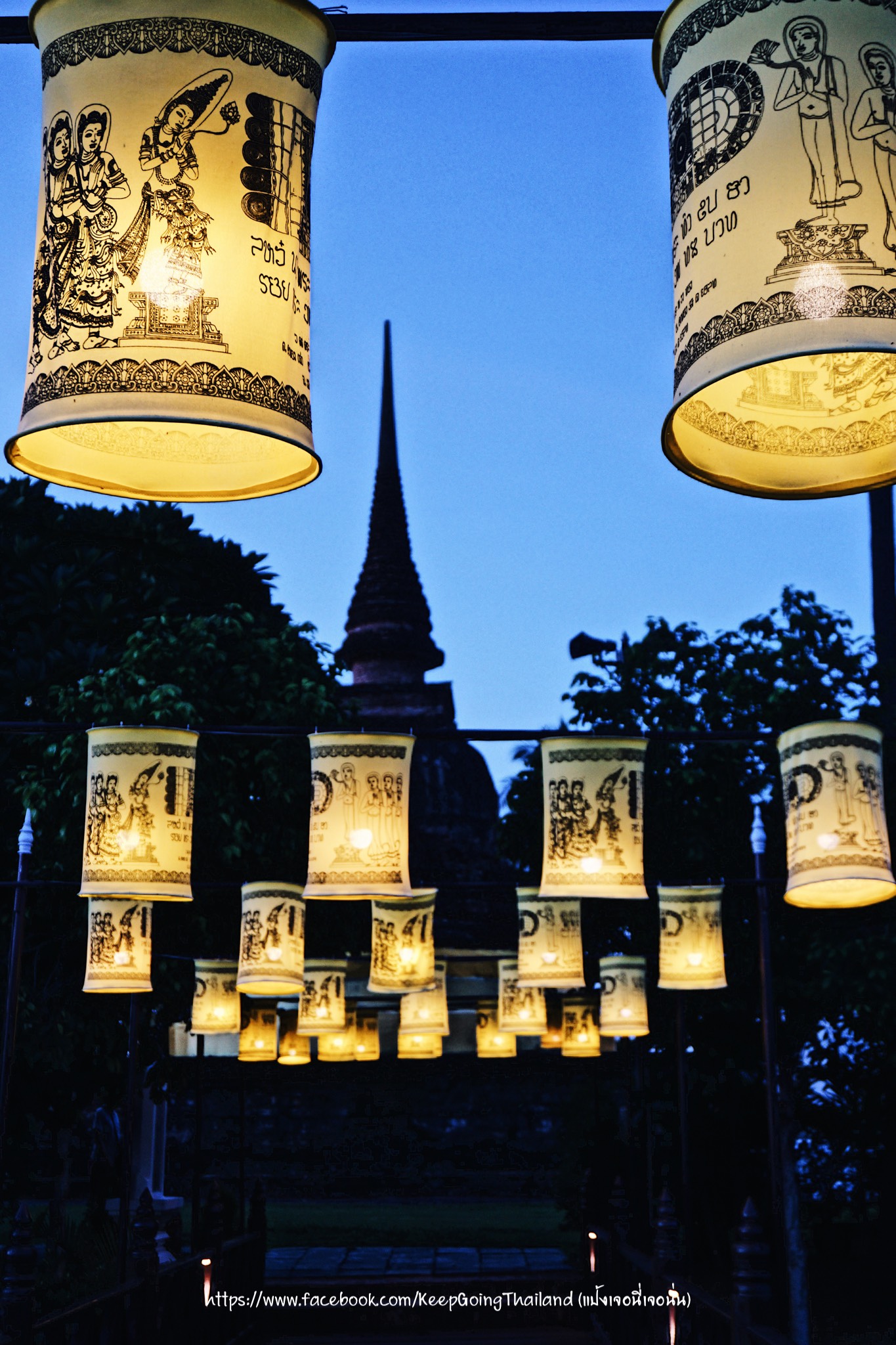

The sky began to brighten. The temple had laid out mats and arranged offering bowls for people to place their offerings. You can choose your seat freely. If you are interested in taking photos, we recommend the entrance to the bridge, which will give you the angle shown in the picture below. As it was a Sunday morning, the bridge was overflowing with people waiting to make merit. Everyone was dressed to impress in northern Thai attire, wearing beautiful Thai silk.
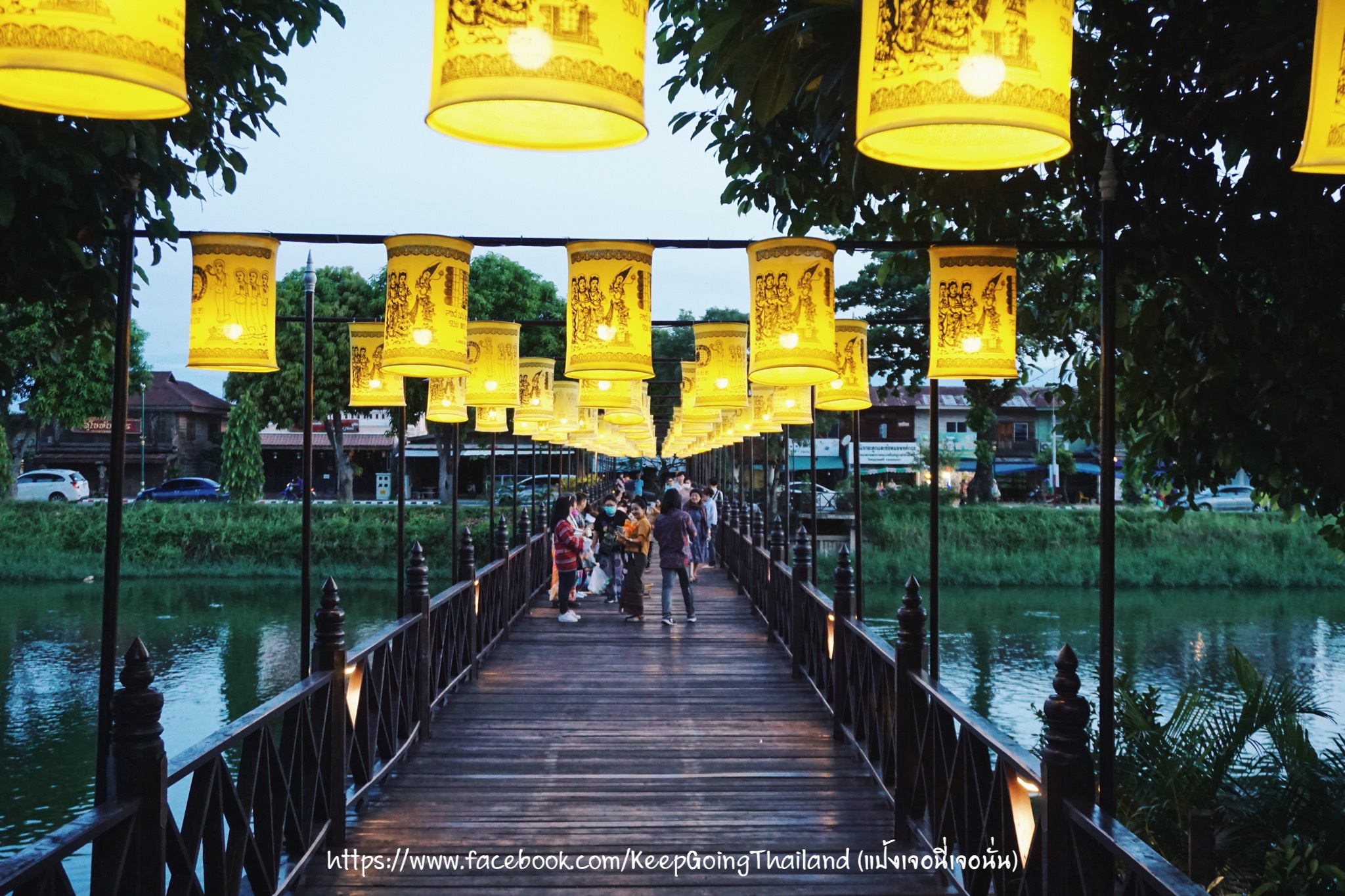
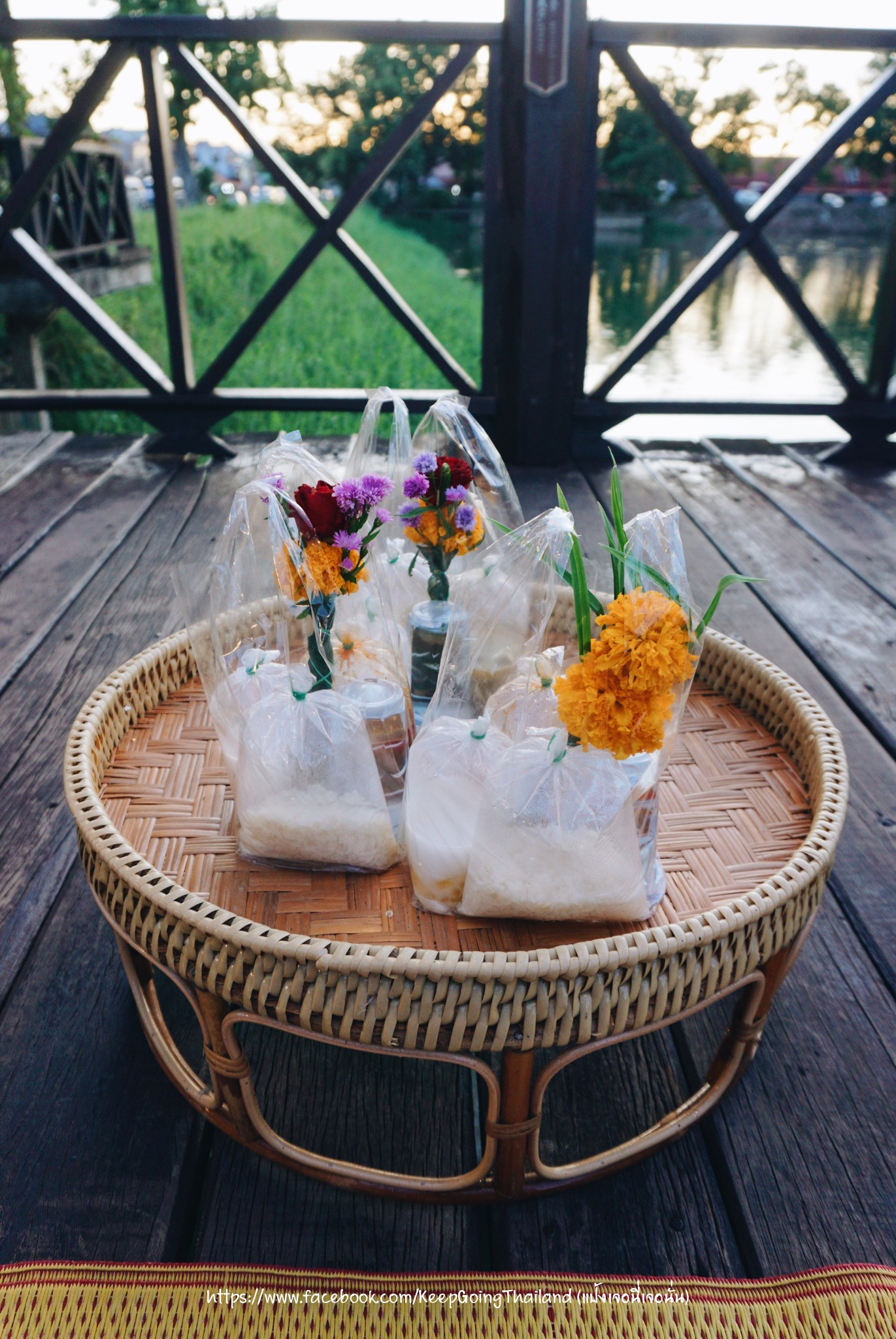
Around 6:50 AM, the monks came down to receive alms. The market vendors said that today was a bit later than usual. "Yes! I've been waiting since before dawn," I laughed. But it's good to come early because you can choose a good spot and take beautiful pictures. The morning atmosphere and the sound of chanting made my mind peaceful. Most people came in groups. The lady sitting next to me asked if I was alone and offered to take my picture. She also asked where I was from and showed me how to offer alms. This morning's merit-making was perfect and exciting, a true dawn of happiness...
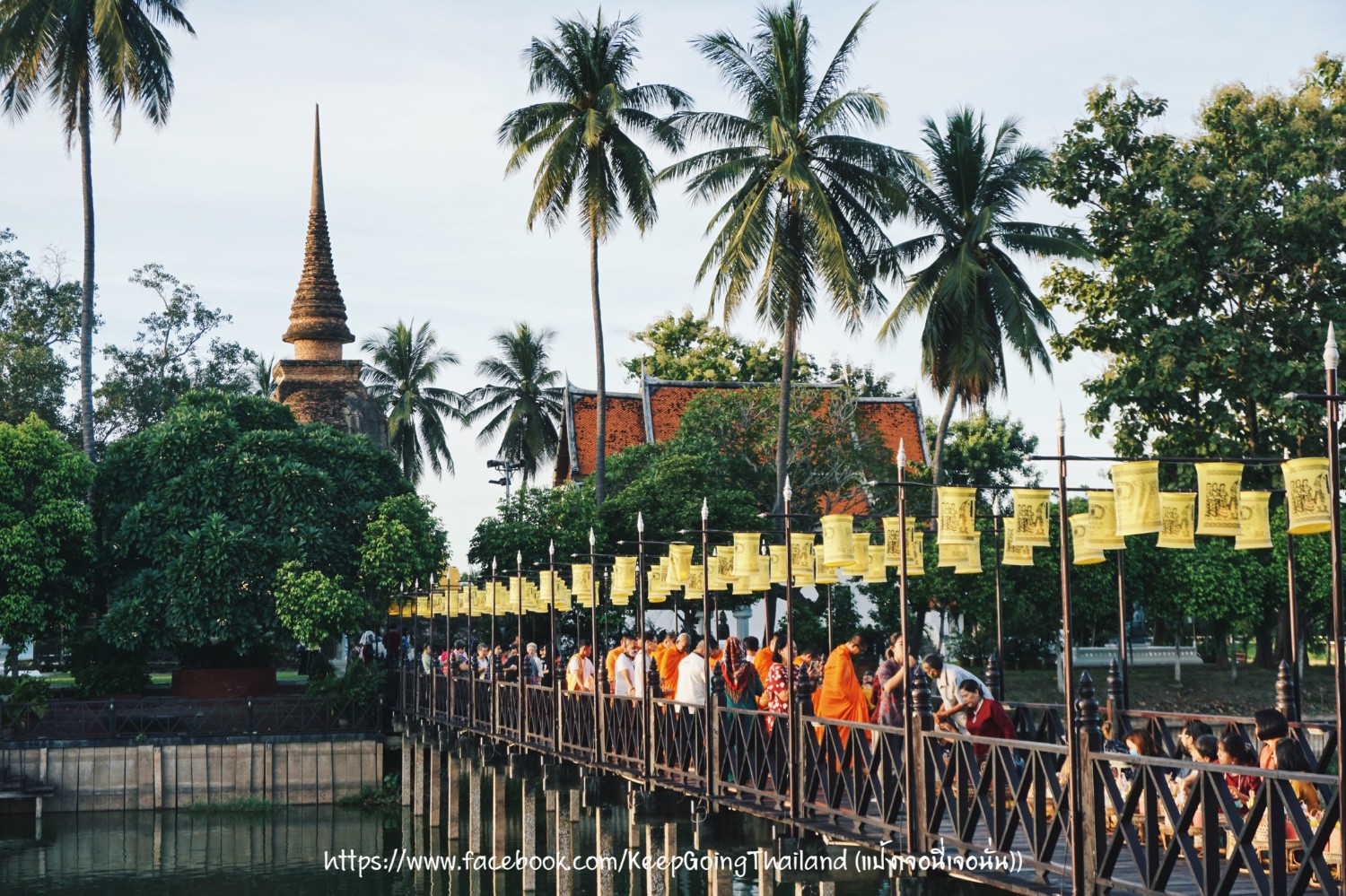
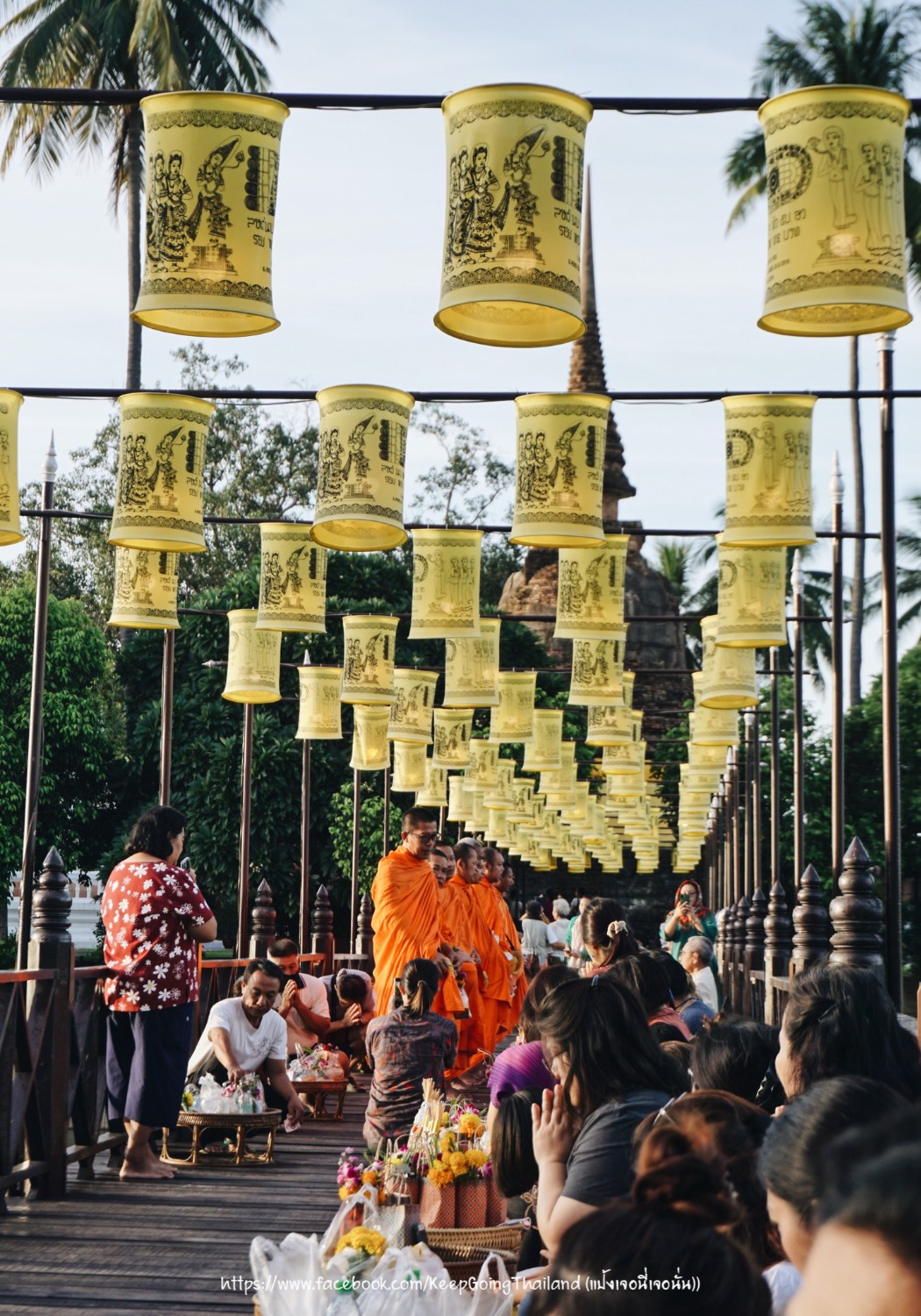
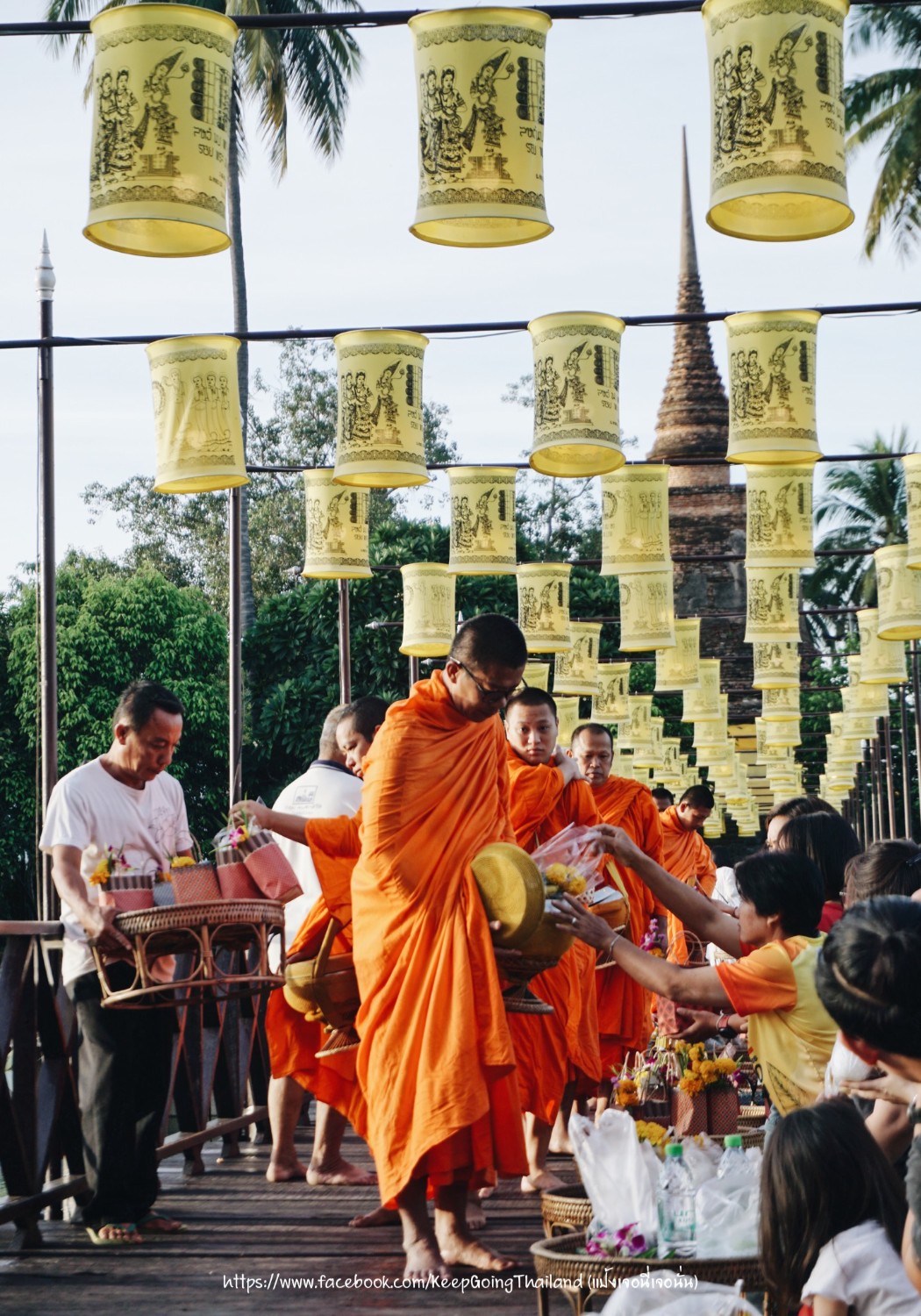
After offering alms, we entered the temple to pay respects to the Buddha. With our hearts full, we decided to fill our stomachs as well. We returned to the market for breakfast and picked up our belongings that we had left with the religious clothing store.
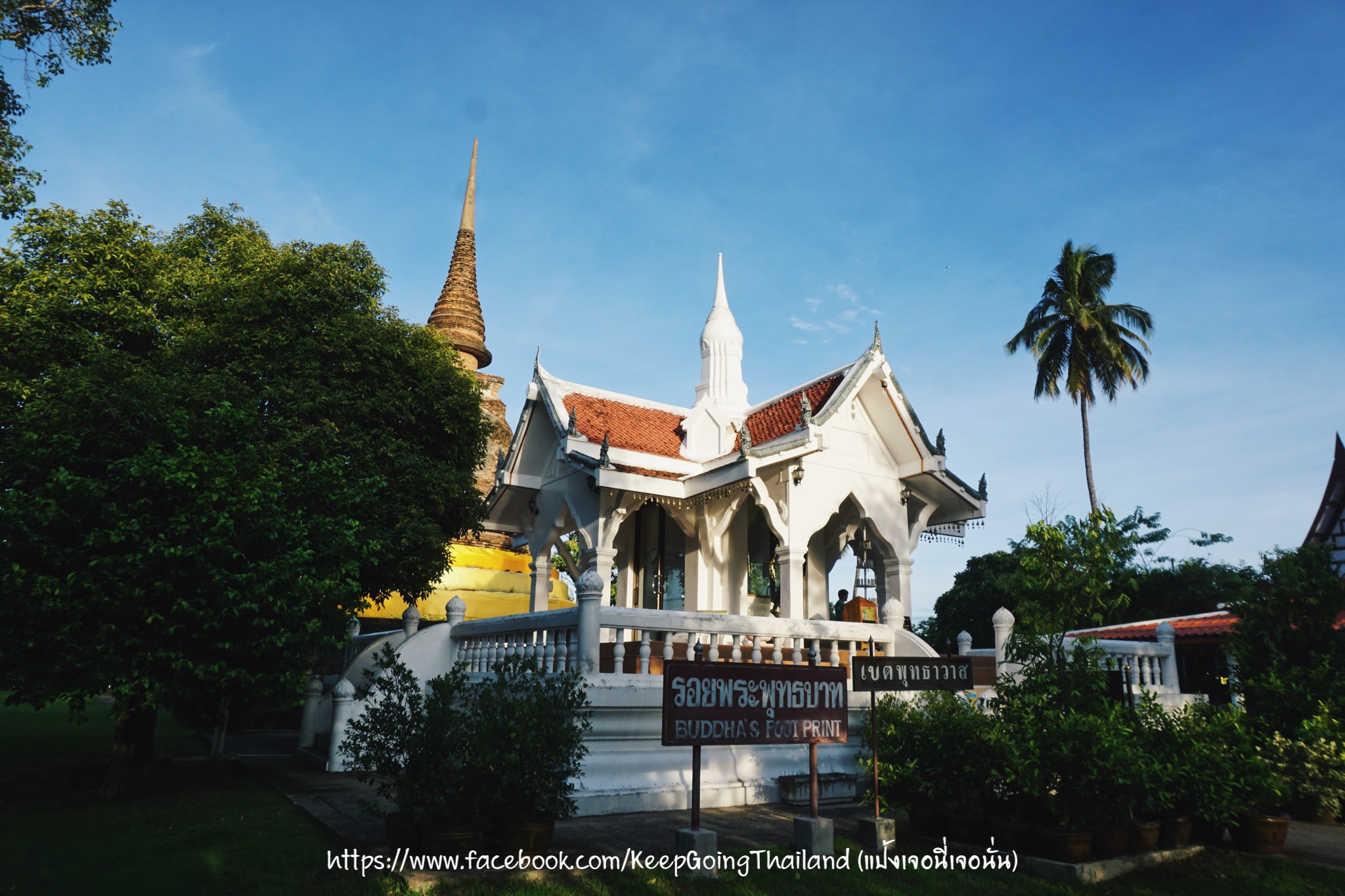
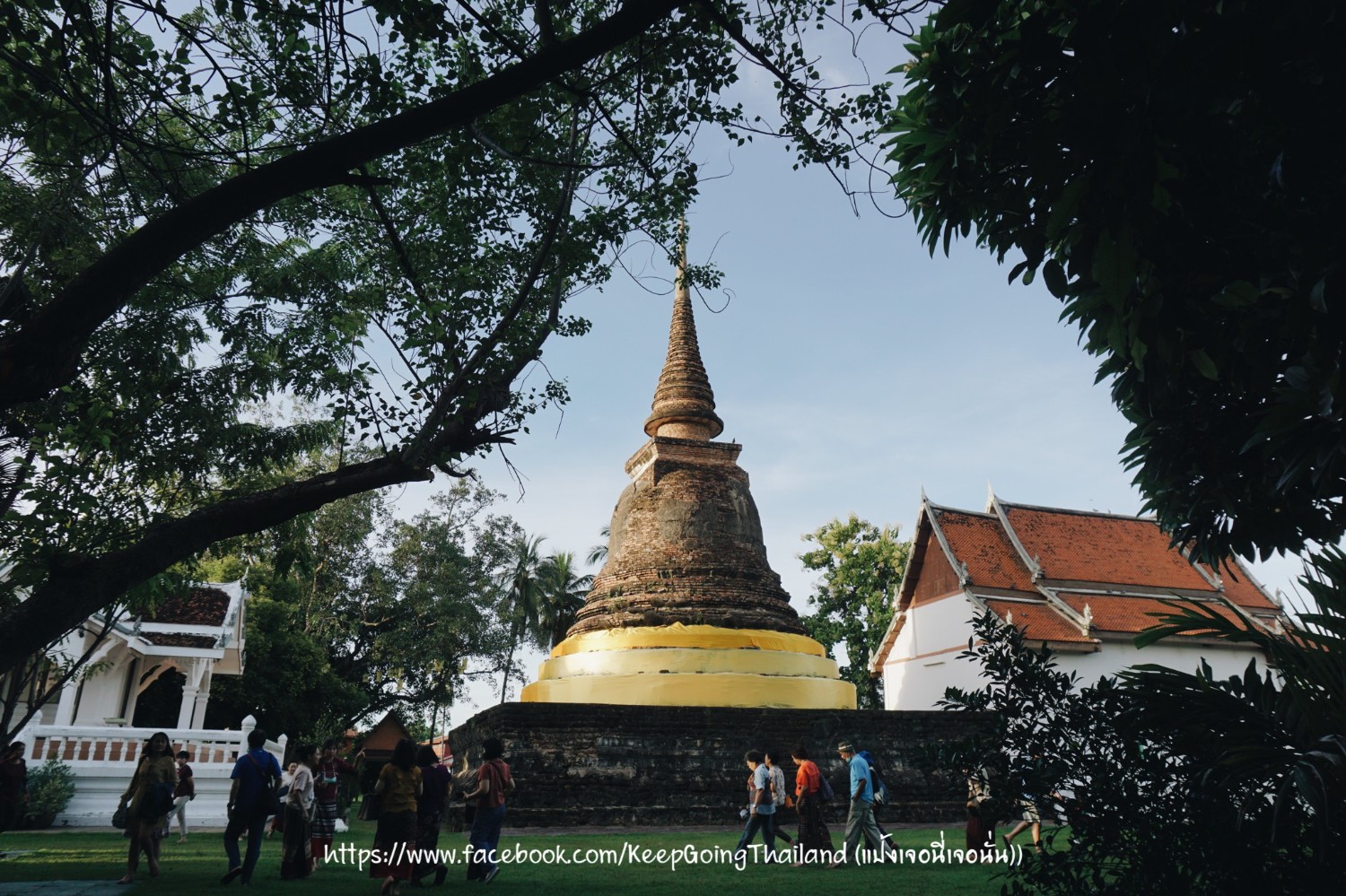
Across from the shop where we left our bags, there was a traditional coffee shop with "pa thong ko" (deep-fried dough sticks). There were a few seats available, so we decided to have coffee and a snack before continuing our journey. Worried that we wouldn't be full, we bought a 10 baht sticky rice package. There were many options to choose from. Our breakfast cost a total of 28 baht: 10 baht for sticky rice, 3 baht for "pa thong ko" (1 baht each), 15 baht for coffee, and free hot tea.

The first problem we encountered was realizing that we had left our power bank on the tour bus. With our phone battery down to single digits, we contacted the bus terminal. After waiting for a while with only 1% battery left, we were informed that we would have to return to Bangkok to retrieve it from the bus driver. Our plan to find a Sukhothai noodle shop to satisfy our hunger was immediately dashed, as we had barely done any research. Instead of using Google Maps for information and navigation that morning, we had to rely on a paper map from the bicycle rental shop, road signs, and asking for directions along the way...
DAY 2: Biking around Sukhothai Historical Park
According to the directions we received, the historical park was not far from the market. Facing the market, we walked to the right, passing Wat Traphang Thong for about 450 meters. We then saw the sign for the historical park. Across the street, there were bicycle rental shops lined up along the roadside. We rented a bicycle from OR Shop, which had a variety of bicycles for rent. The owner recommended a bicycle that was suitable for us, a Dutch-style bicycle that cost 30 baht. We provided our ID card and were able to ride it for most of the day until the shop closed. The shop provided a paper map and explained the route. If we had specific places in mind, we could tell them, and they would recommend a cycling route. As for us, we just asked to go to Wat Si Chum. We were quite anxious about not having Google Maps in this situation. We were able to leave our luggage at the bicycle rental shop.
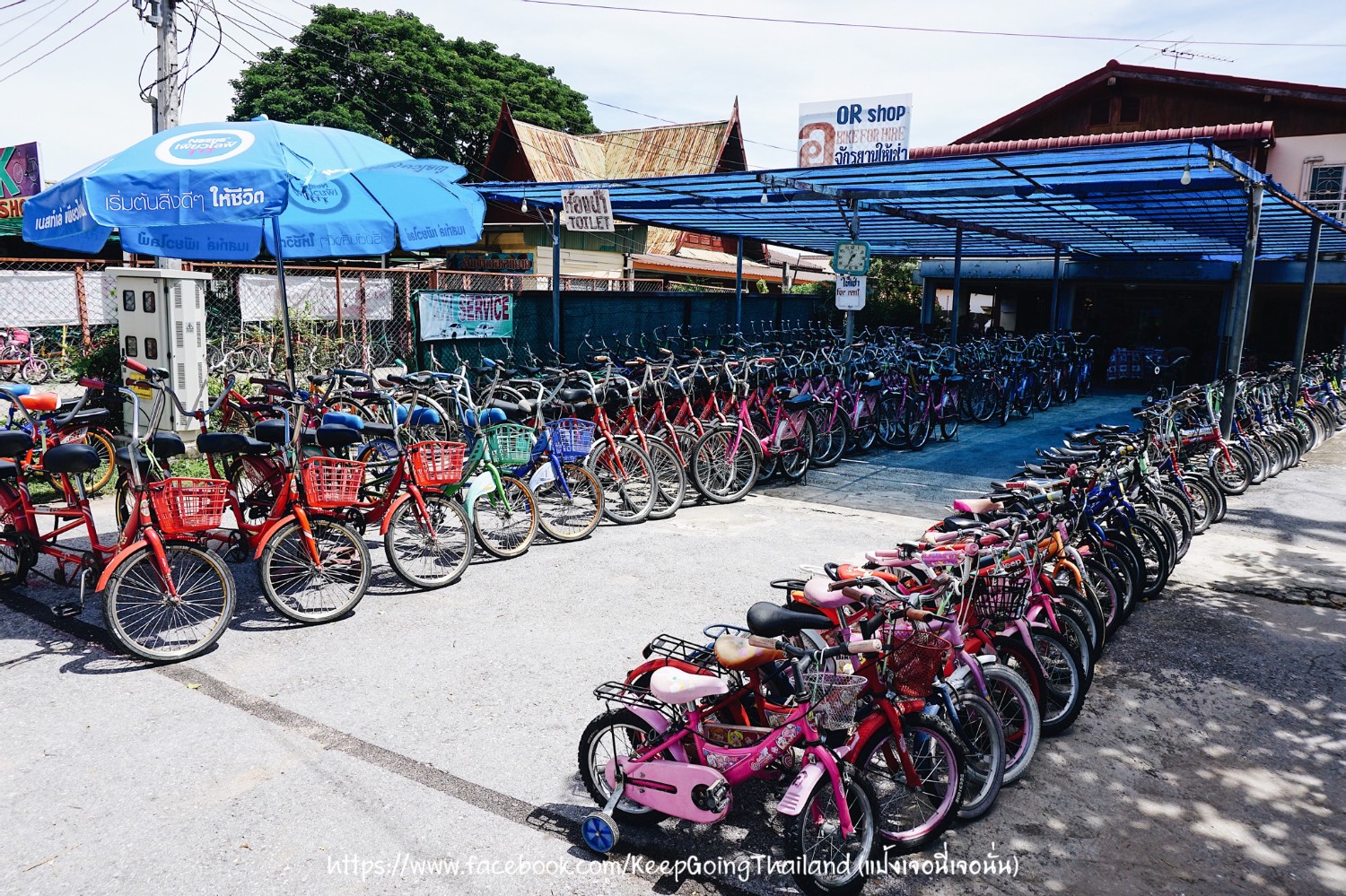
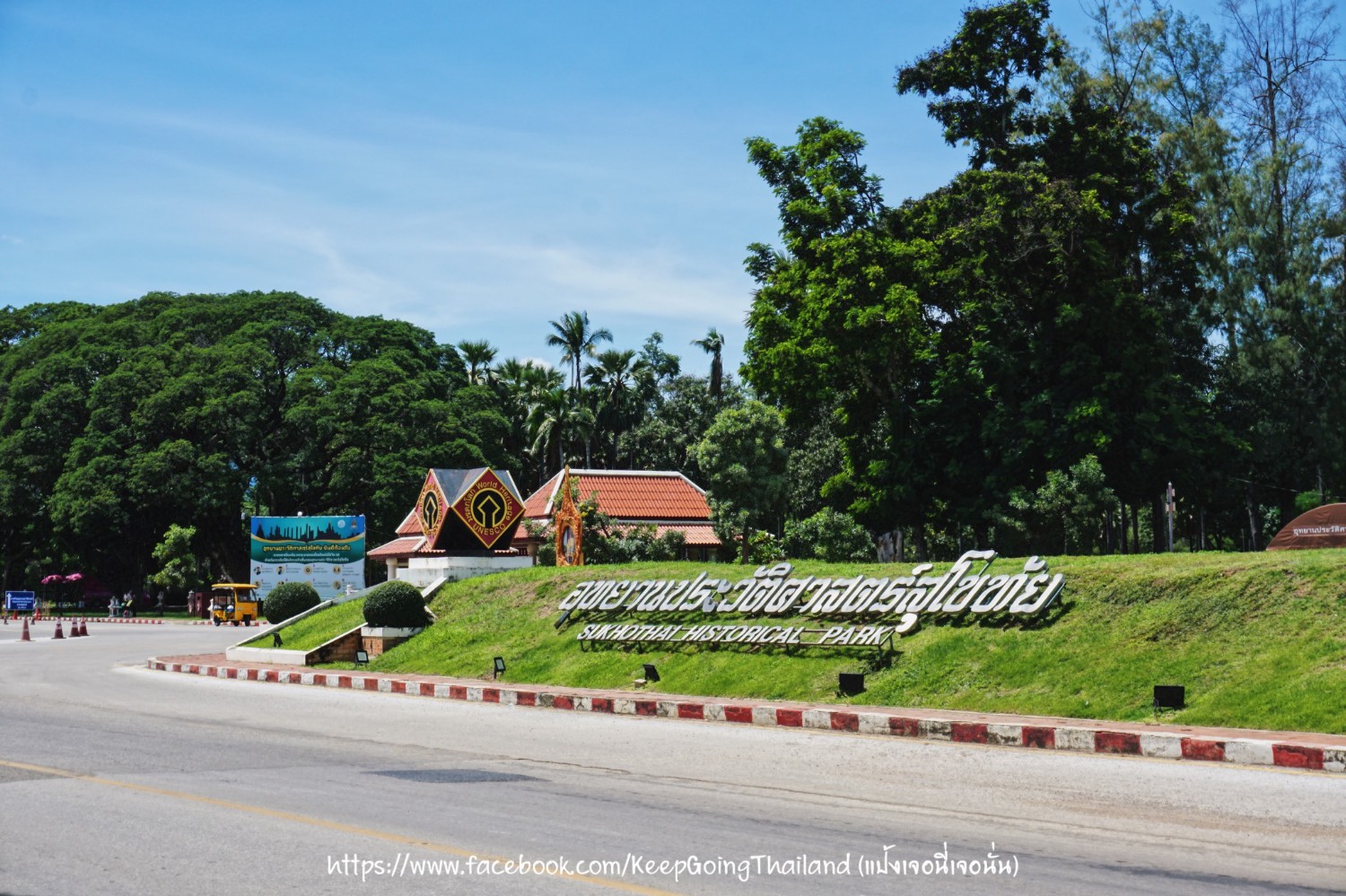
You can then cycle to the ticket booth in front of the park.
Morning Admission Rates
- Thai citizens: 20 baht
- Foreigners: 100 baht
- Bicycles: 10 baht

The rented bicycle looked like this. We knew we were going to ride a bicycle in the plan, but we ended up wearing a dress. Let me tell you, "don't try it." You have to ride a bicycle with one hand, and the other hand has to hold the skirt to prevent it from being exposed. It is very dangerous to ride and it is very bad for your image.
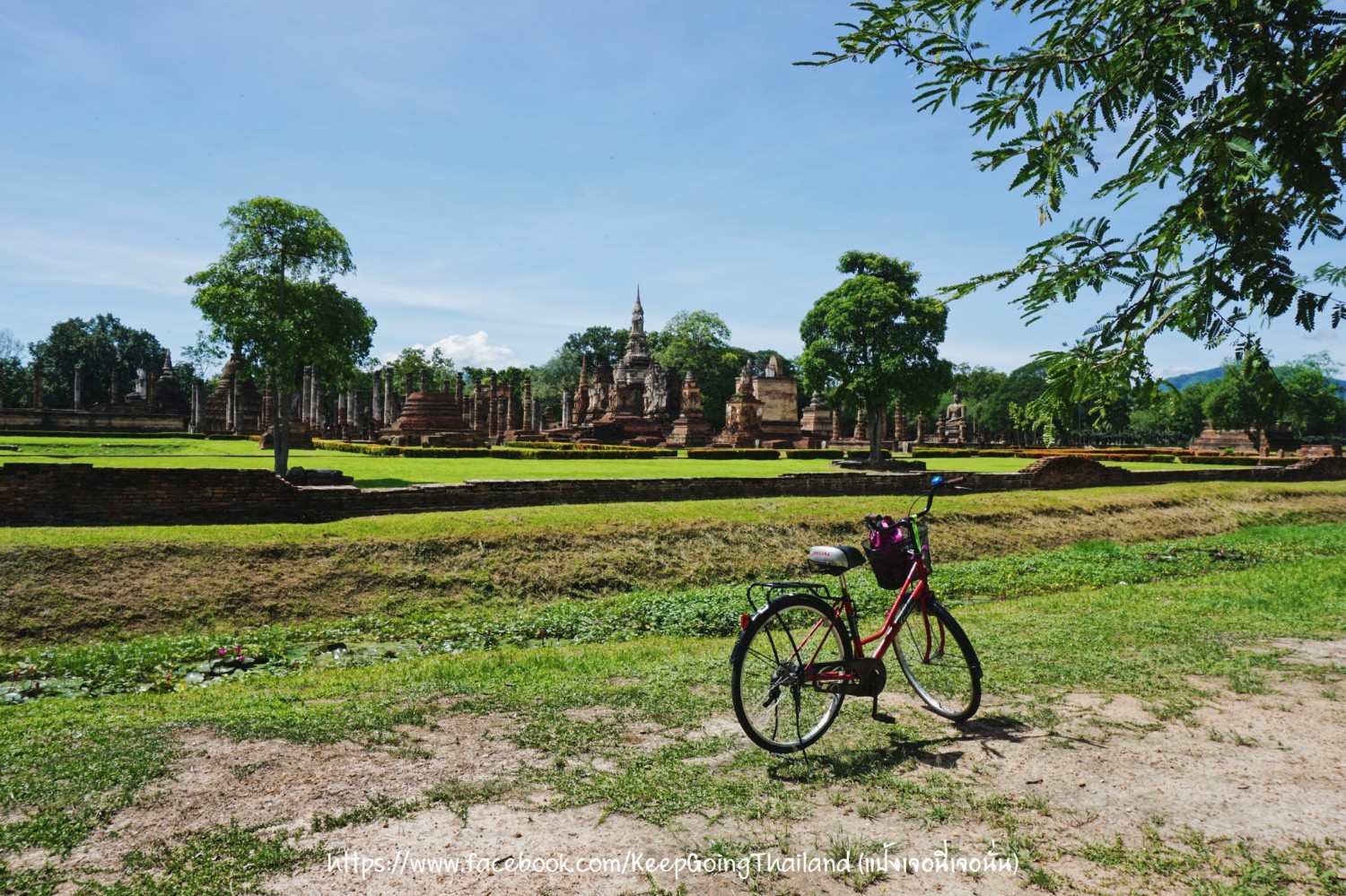
For those who prefer not to cycle, a comfortable option is to explore the historical park by golf cart. These carts, which can accommodate 6-8 passengers, are available for rent at the entrance for 450 baht per hour. Visitors can choose to drive themselves or opt for a driver service.

Sukhothai Historical Park is a significant historical site in Thailand and is listed as a UNESCO World Heritage Site.
The first recommended spot to visit is the Monument of King Ramkhamhaeng, as sitting to pay respects on the ground is less hot in the morning. This advice comes from the owner of the bicycle rental shop. Flowers, incense, candles, lamp oil, and drinks are available for purchase near the monument. Bringing water in a basket on the front of your bike is highly recommended.

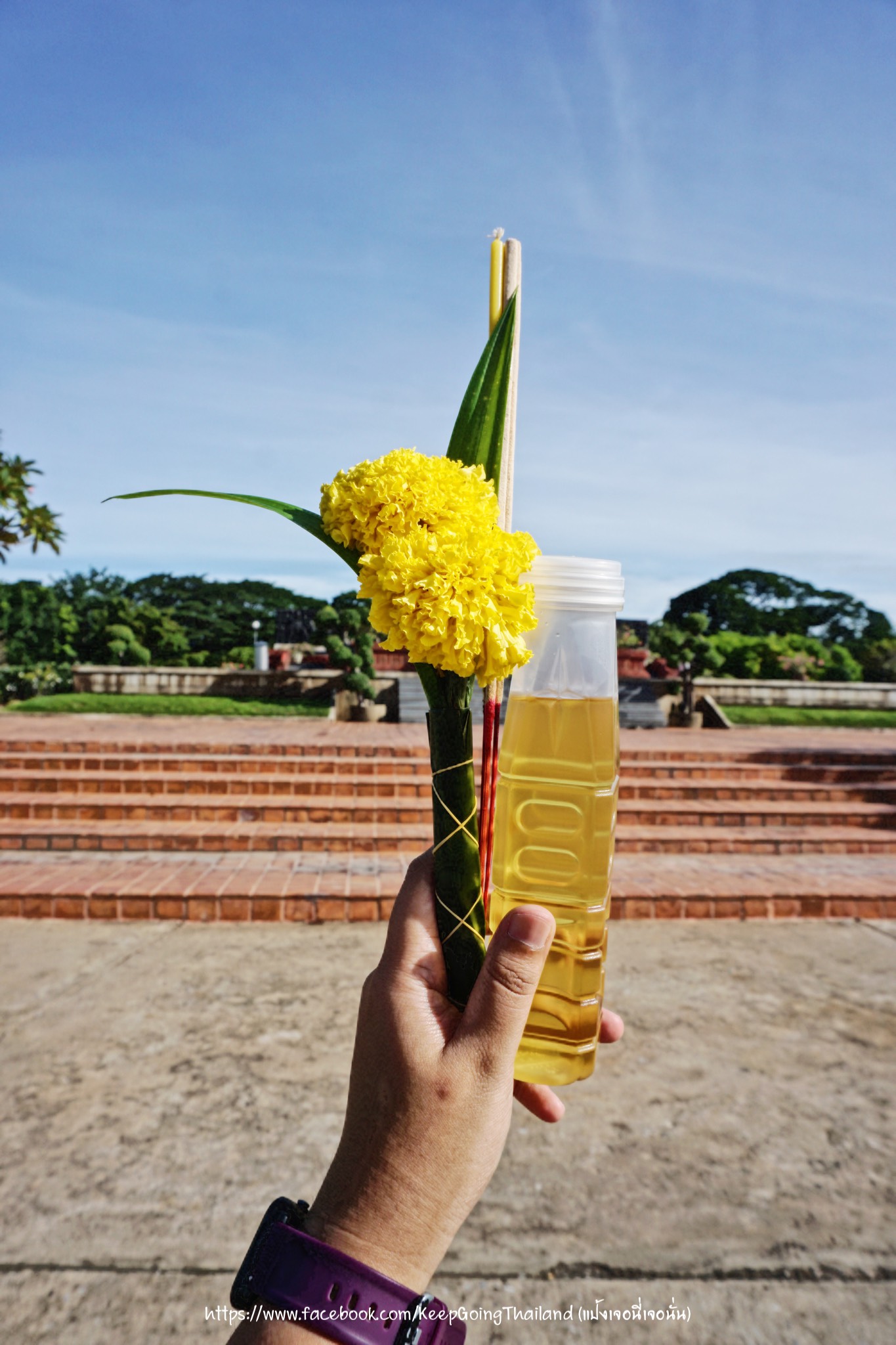
Wat Mahathat, built during the reign of King Sri Indraditya, boasts a distinctive bell-shaped stupa, a hallmark of Sukhothai art. This authentic Thai temple, situated in the heart of the city, held immense significance in the Sukhothai Kingdom. We spent far longer than anticipated exploring and photographing this magnificent structure. Initially, we planned to dedicate only 15 minutes to our visit, but we ended up lingering for over 30 minutes. Based on our observations, it appears to be the largest temple in the area. Unable to resist, we captured a memorable photograph of ourselves at this historic site. We typically use a camera mounted on a tripod and controlled remotely via a Wi-Fi connection to our mobile phone. However, when our phone battery died, we resorted to setting the timer and sprinting into position. This inevitably led to some awkward moments when we encountered other visitors. This is one of the challenges of solo travel. Please refrain from climbing on the ancient structures during your visit.

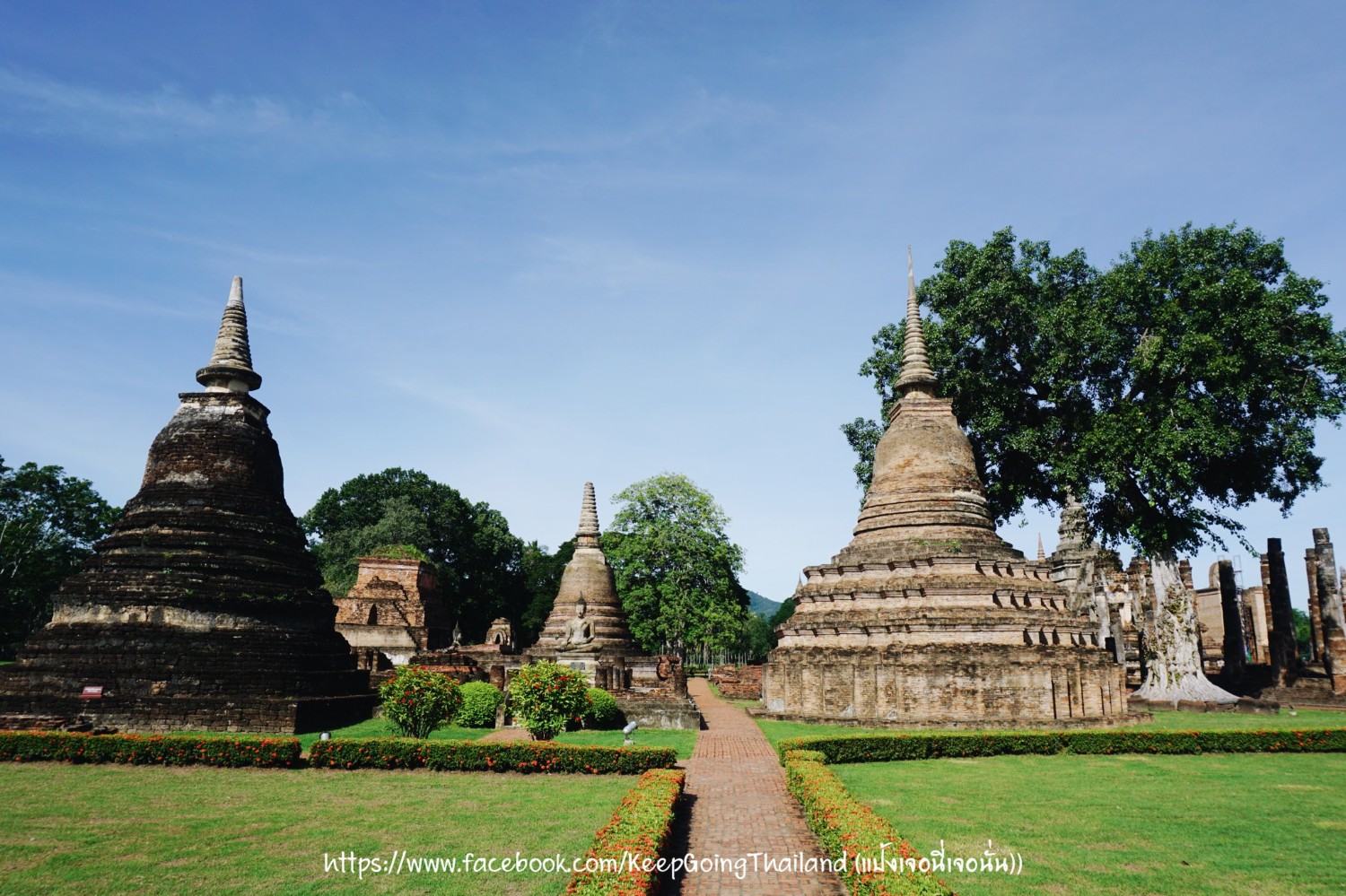
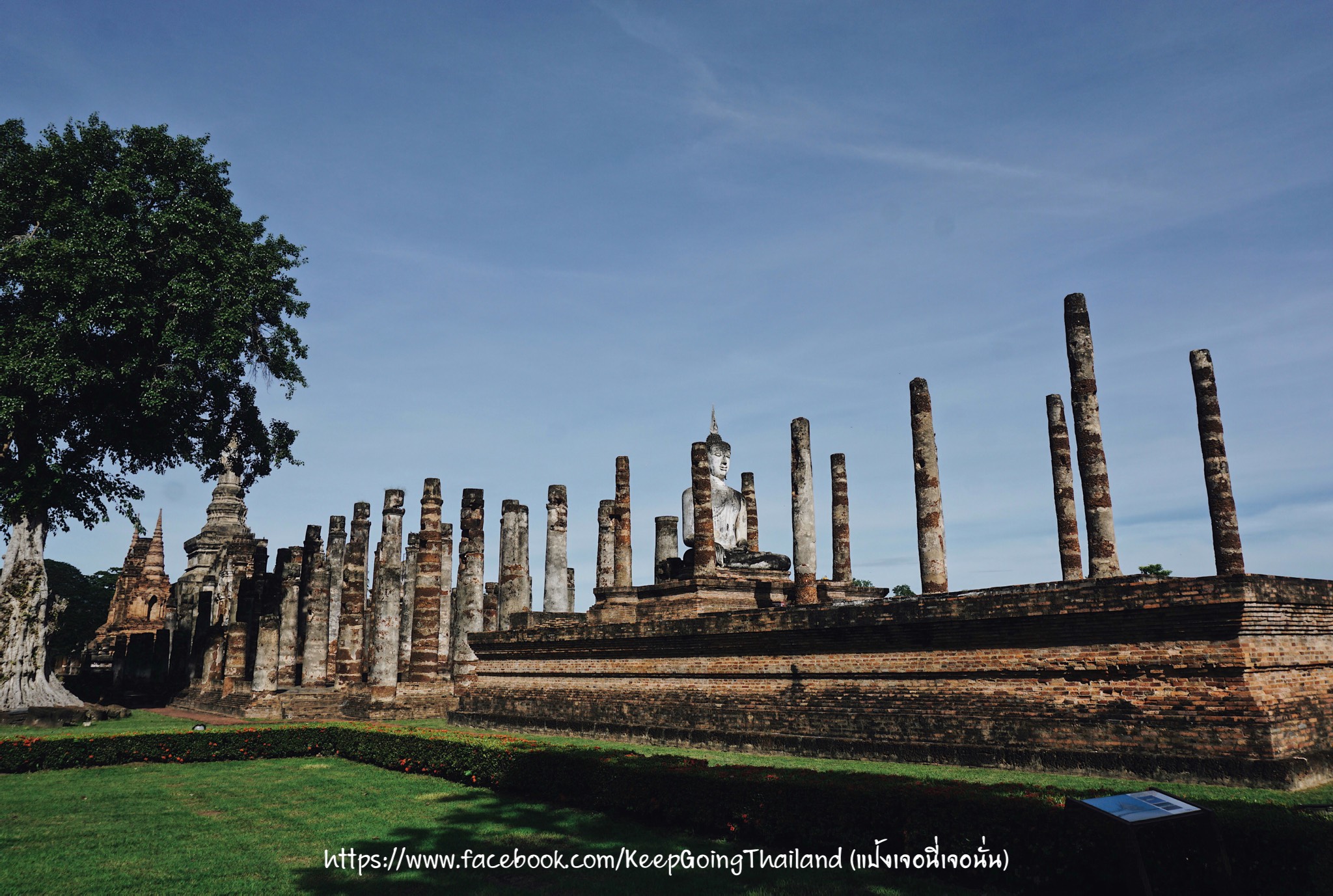
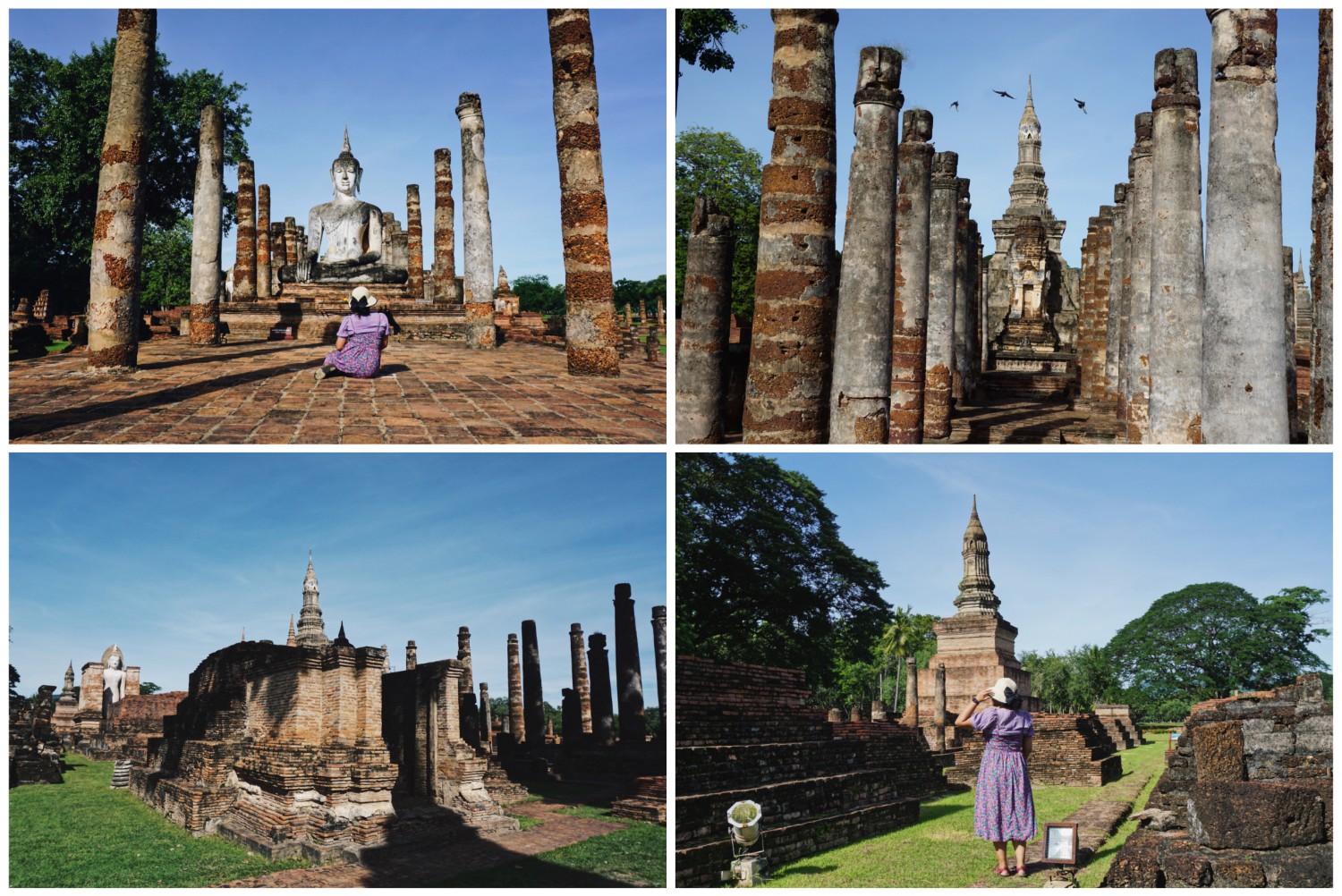
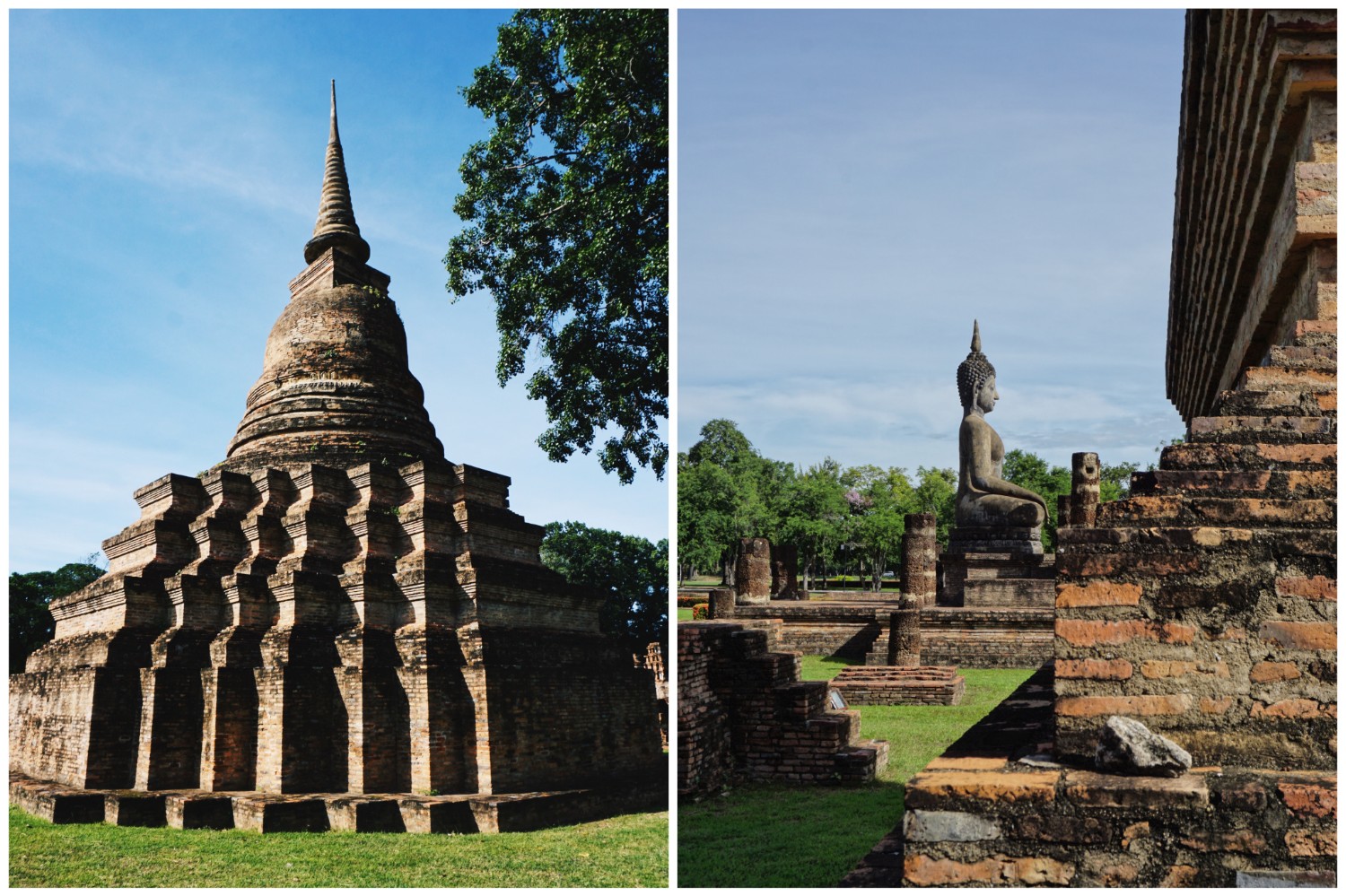
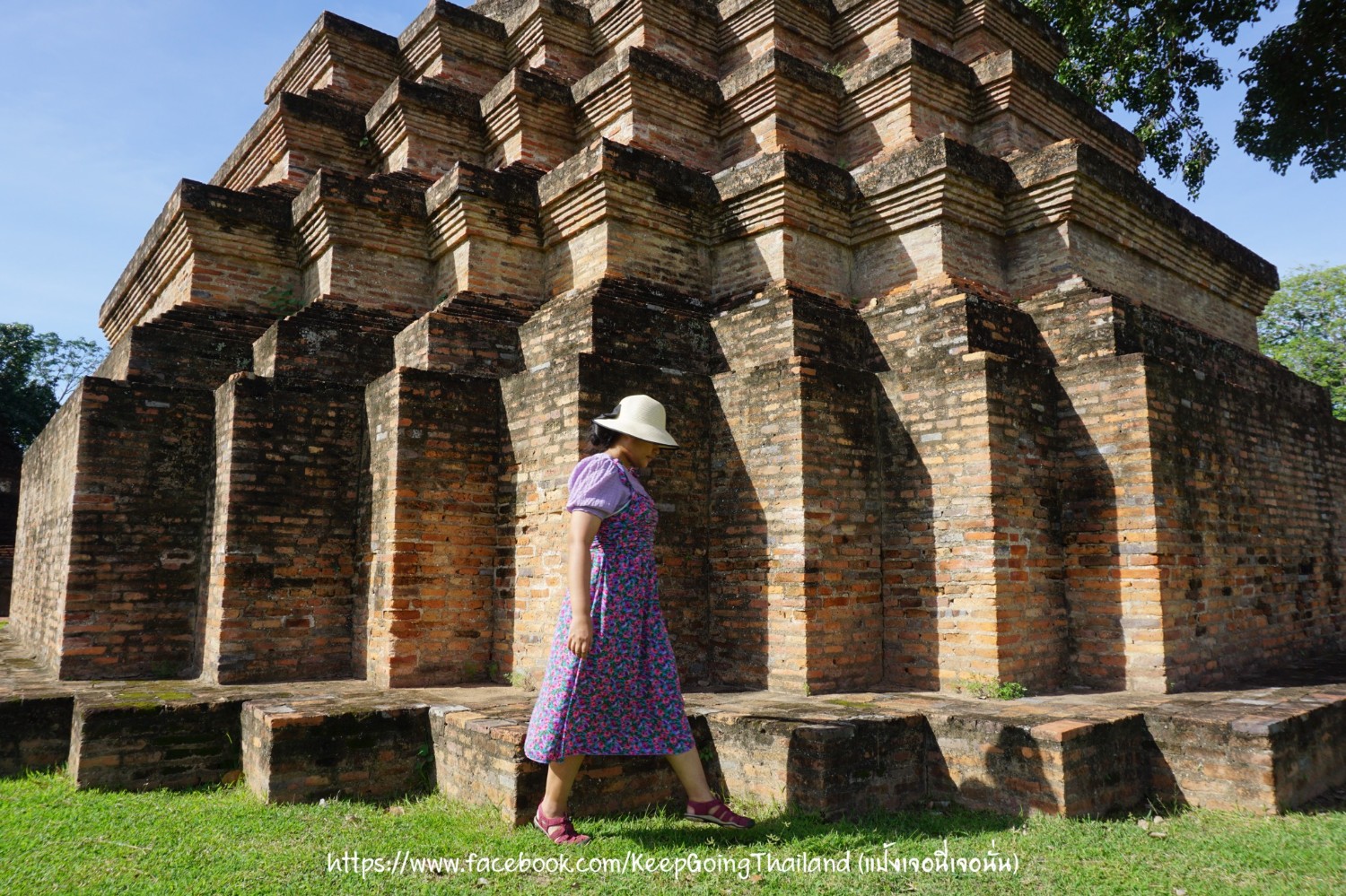
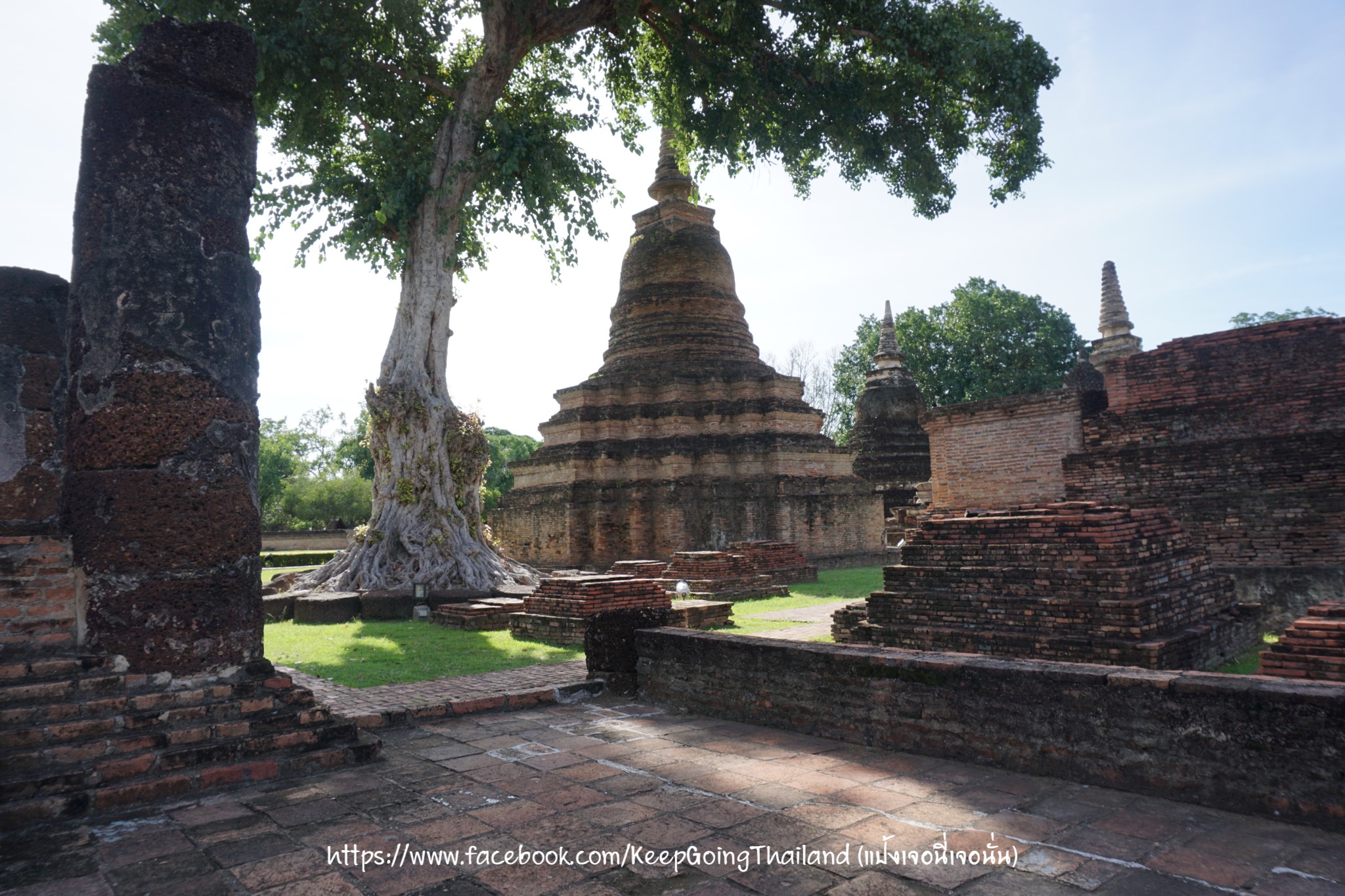
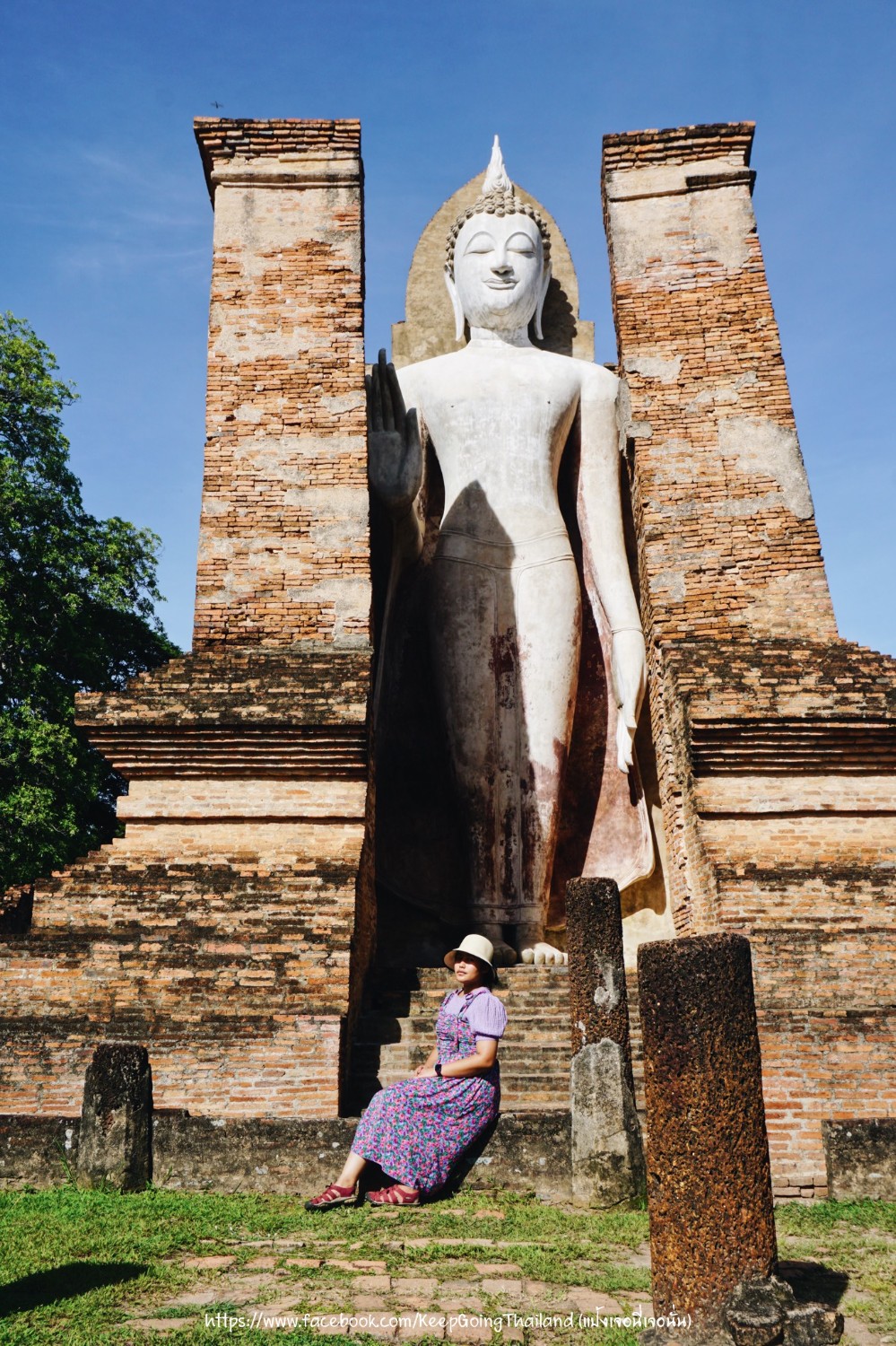
Wat Si Swai, located south of Wat Maha That, features three prangs. We believe they resemble the three-spired prang in Lopburi, which seems likely considering the Lopburi artistic style of Wat Si Swai's prangs, influenced by Khmer art.
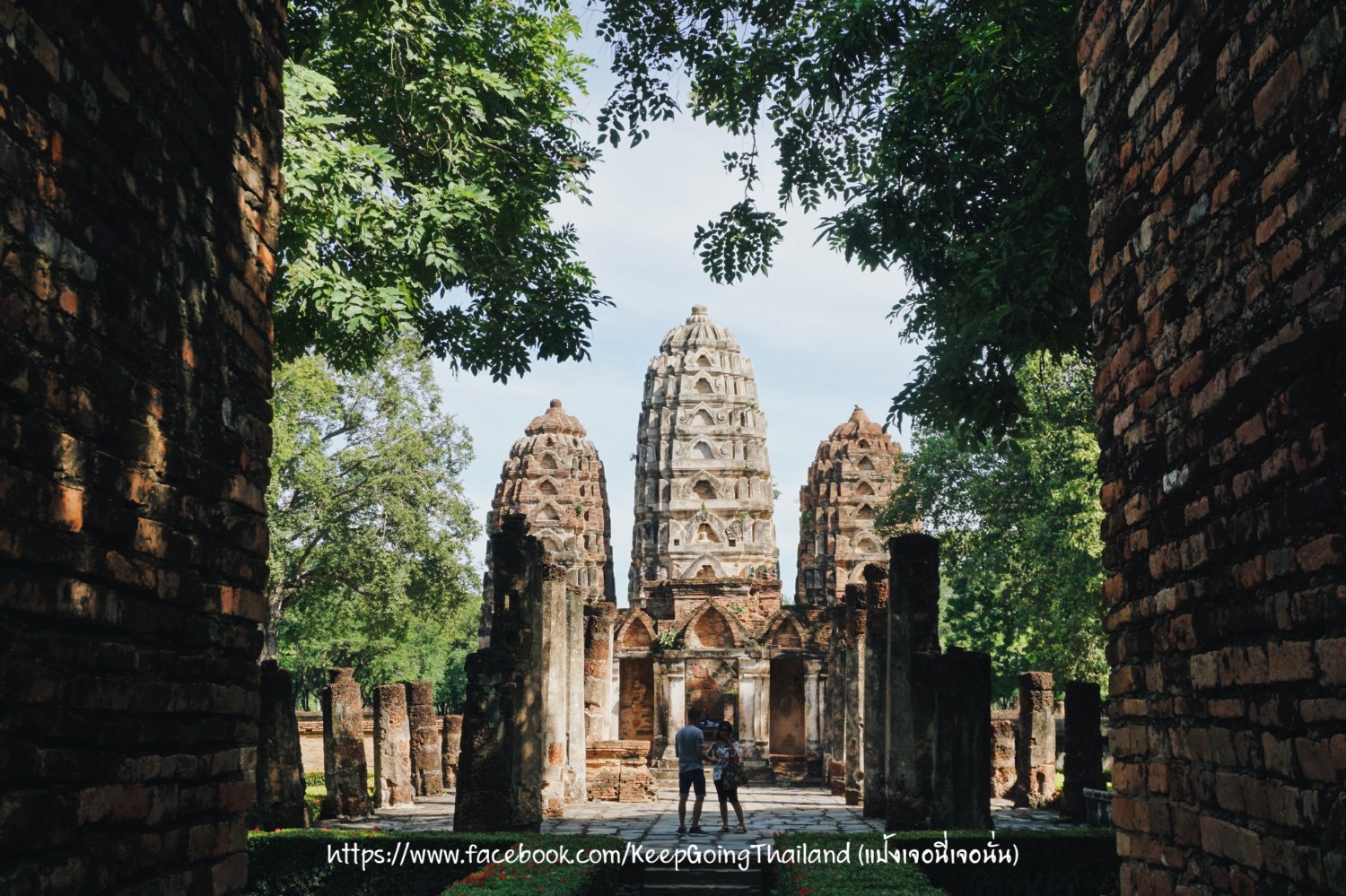
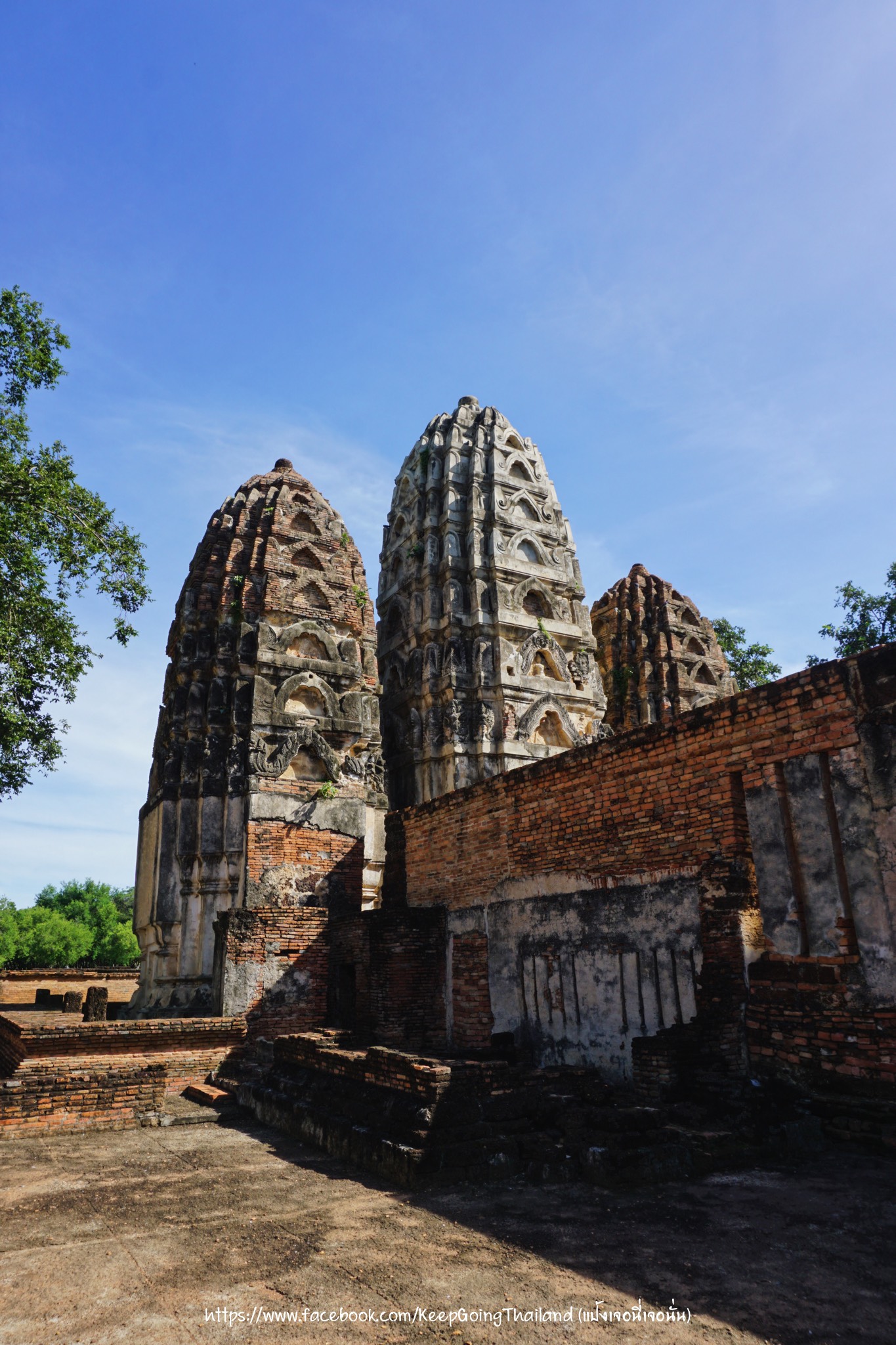
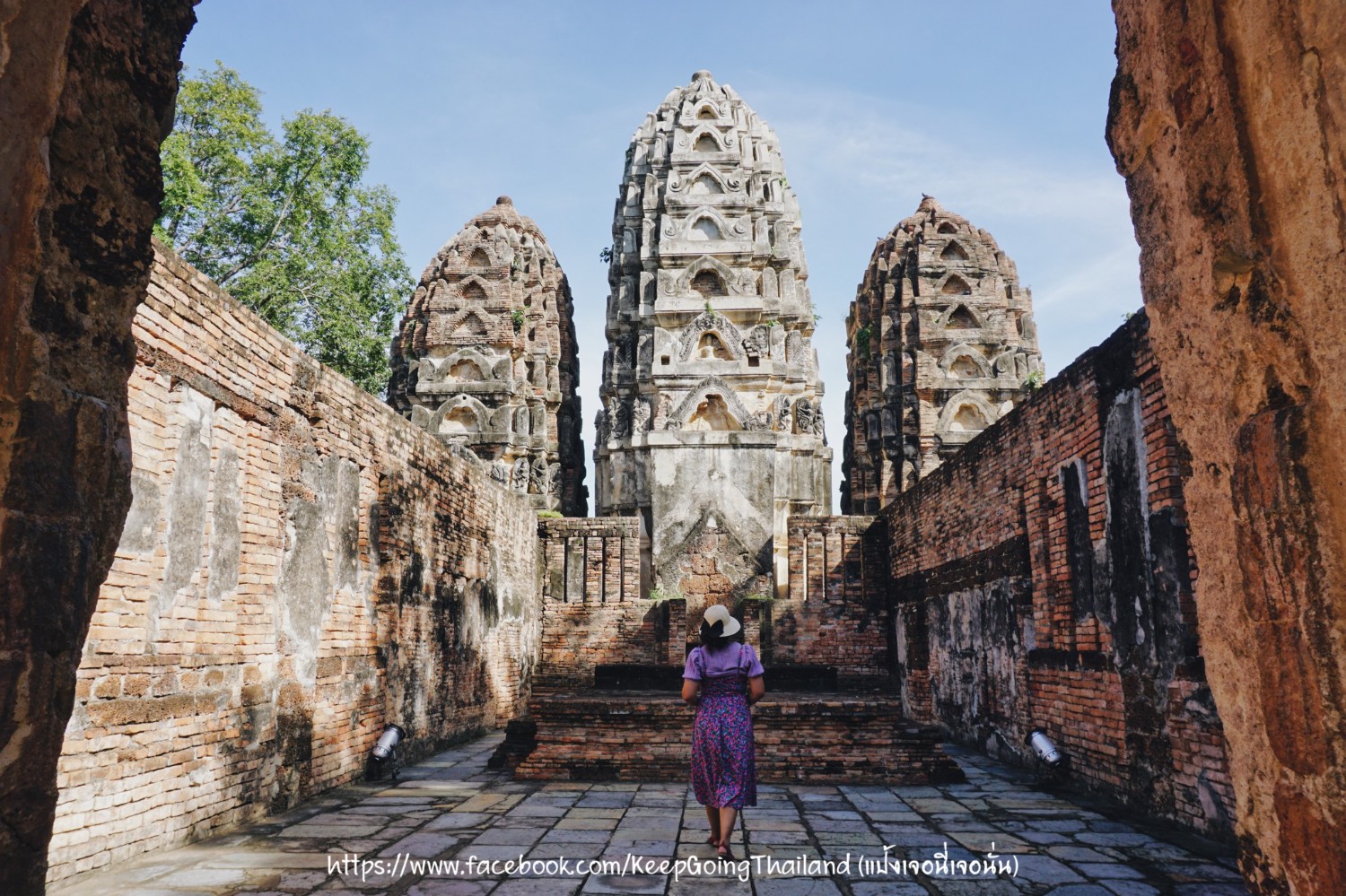
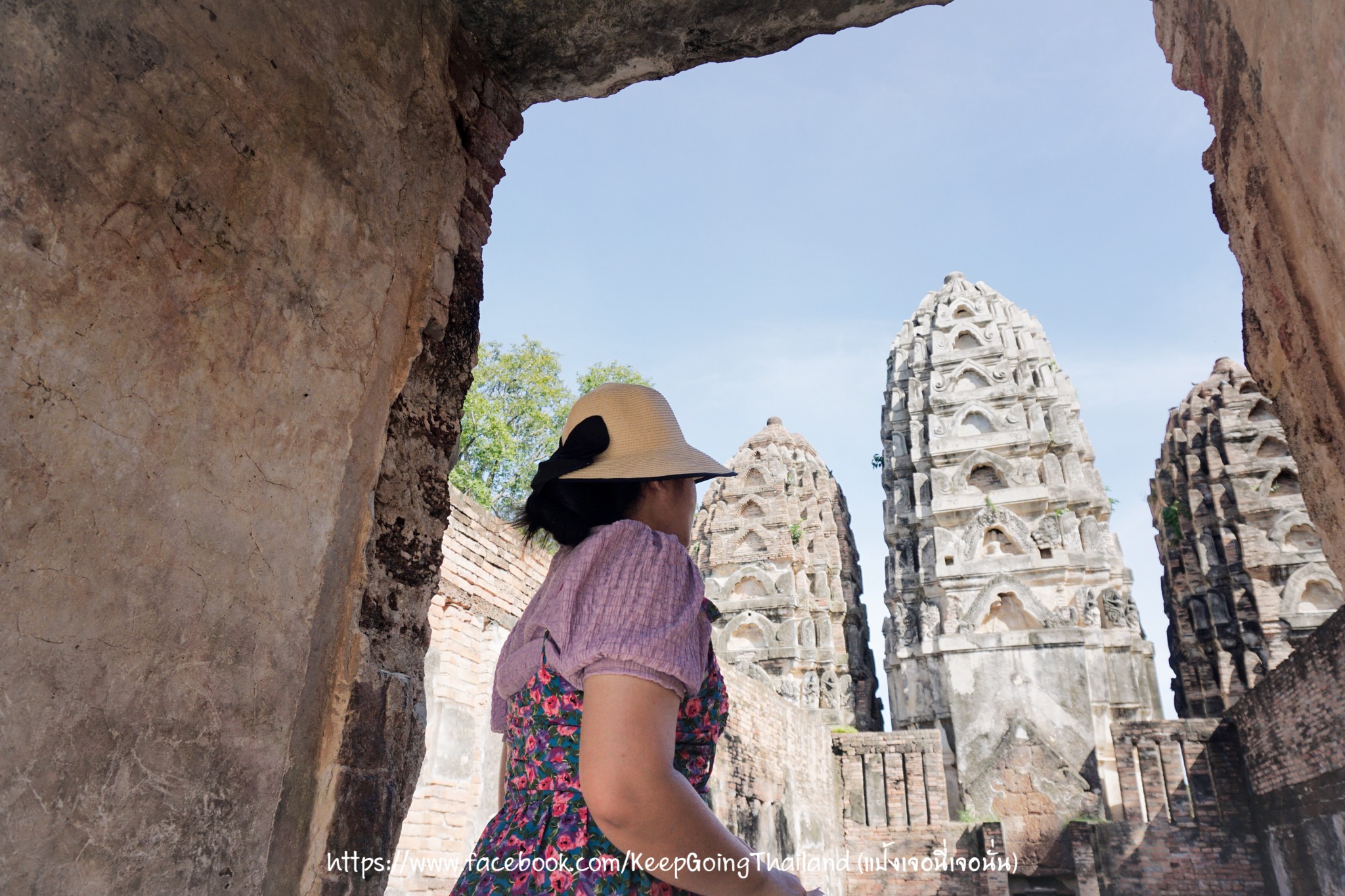
The bike path is excellent, but be cautious of golf carts. The route is shaded, but as it approaches ten in the morning, the sun becomes intense and the weather starts to heat up.
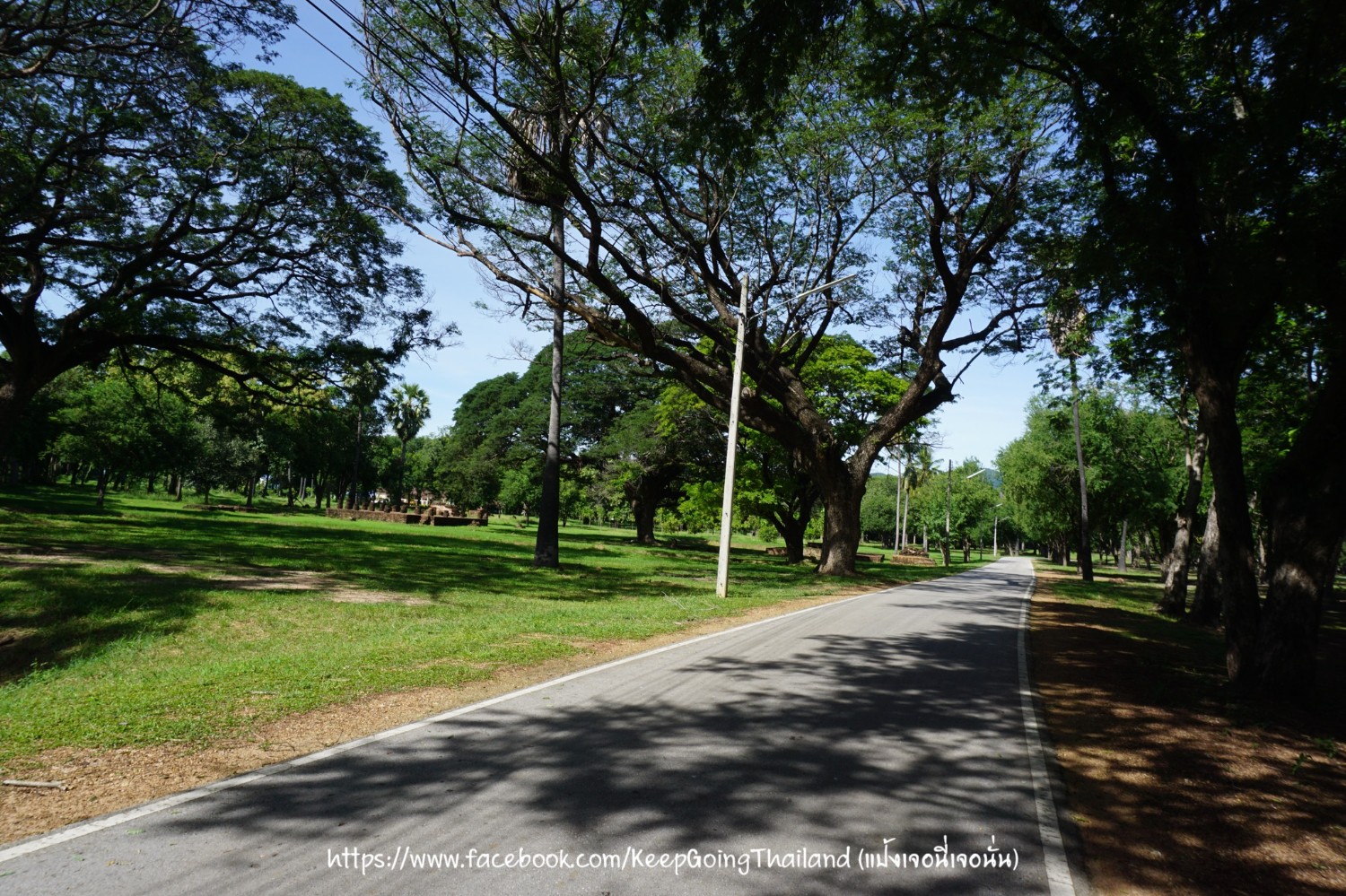
Wat Traphang Ngoen is located to the west of Wat Mahathat, next to a pond. The word "traphang" is a Khmer word meaning "pond" or "marsh". I decided to see the ancient sites within the old city walls only and will cycle to Wat Sri Chum, which is about 1.8 kilometers away.
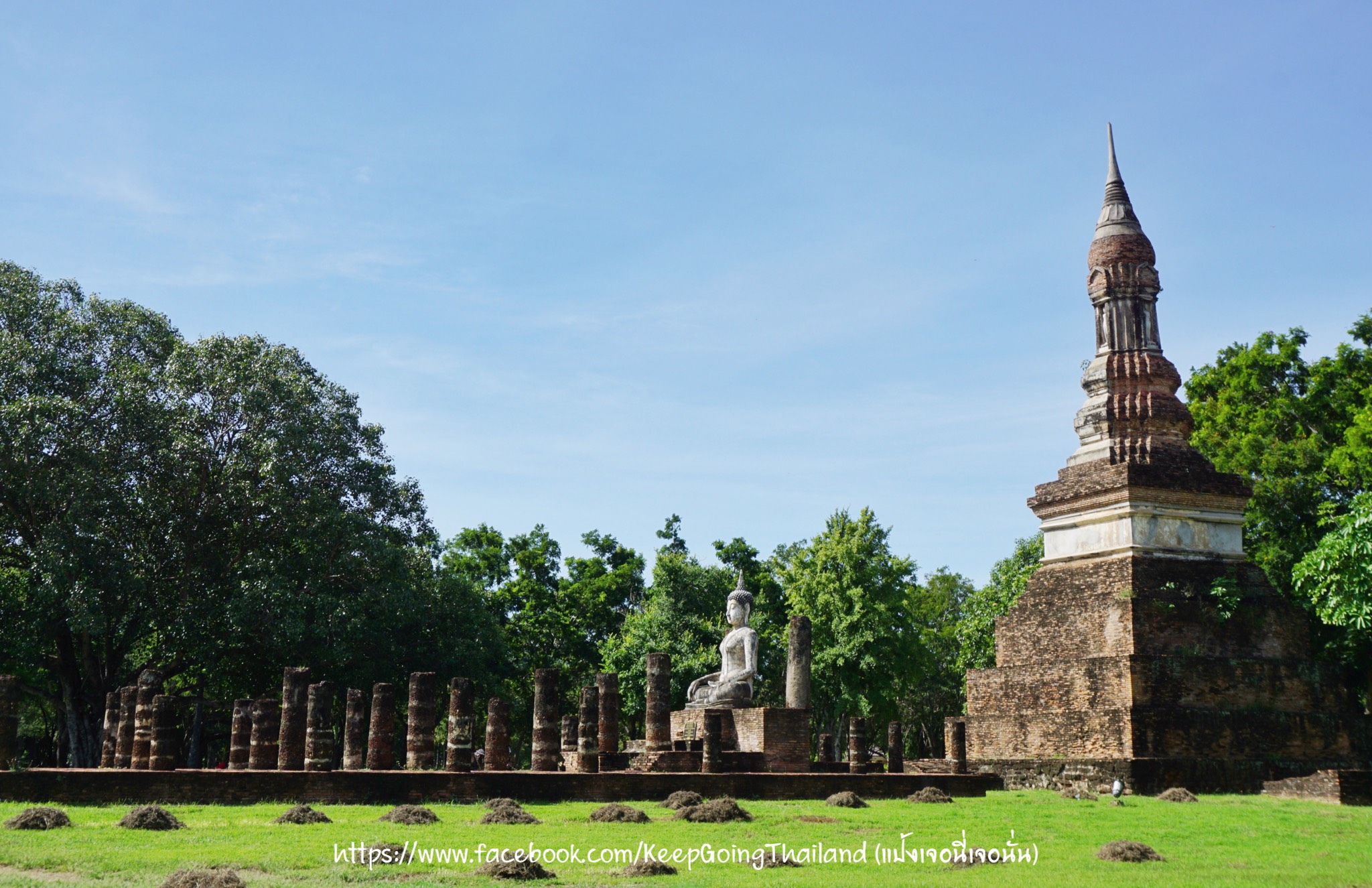
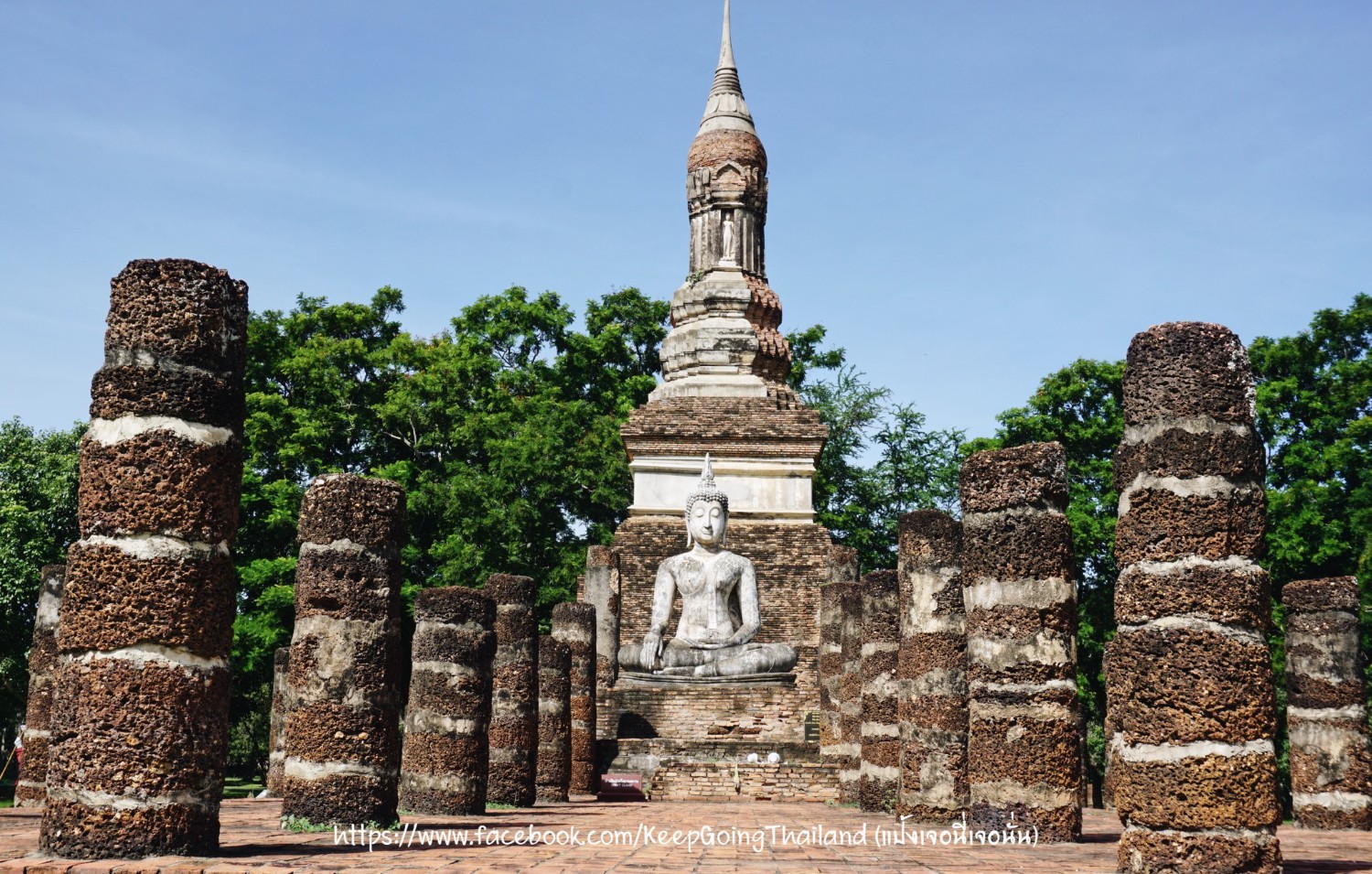
Wat Si Chum: A Temple with a Talking Buddha
Riding our bikes out through the Si Chum Gate, we found ourselves on Highway 12. Traffic was heavy, so we had to be careful as we crossed the road to turn into the alley beside the Khwan Siri restaurant. Upon reaching Wat Si Chum, we paid the 20 baht entrance fee. We were drawn to this temple because of the legend of the talking Buddha statue. Since we were already in Sukhothai, we wanted to see it for ourselves.
The temple houses a large Buddha statue in the Mara-Vijaya posture, known as "Phra Achana." The legend of the talking Buddha originated with King Naresuan, who sought to boost the morale of his troops. He instructed a soldier to climb behind the statue and speak to the soldiers, inspiring them to fight. This event gave rise to the legend of the talking Buddha.
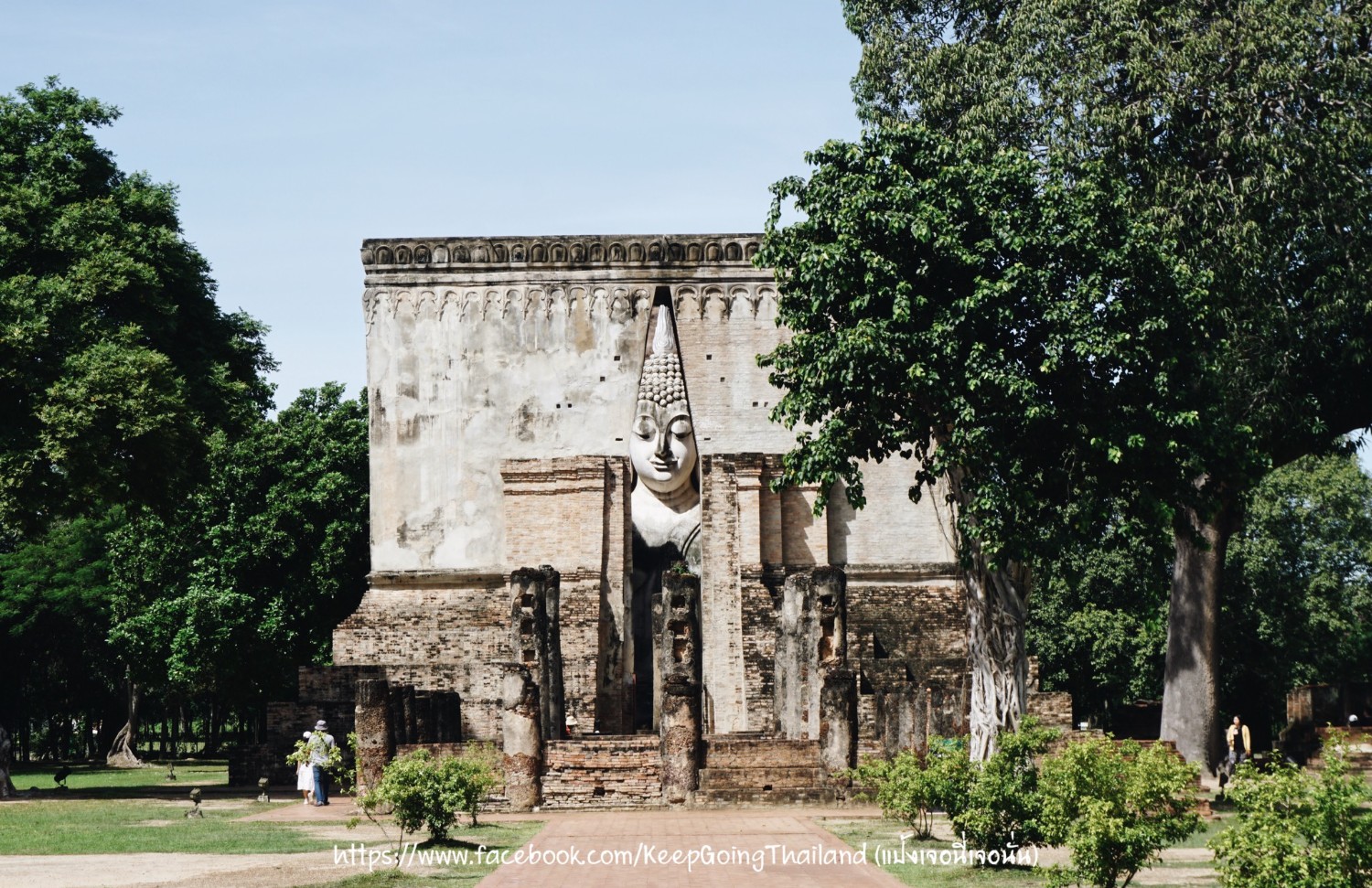
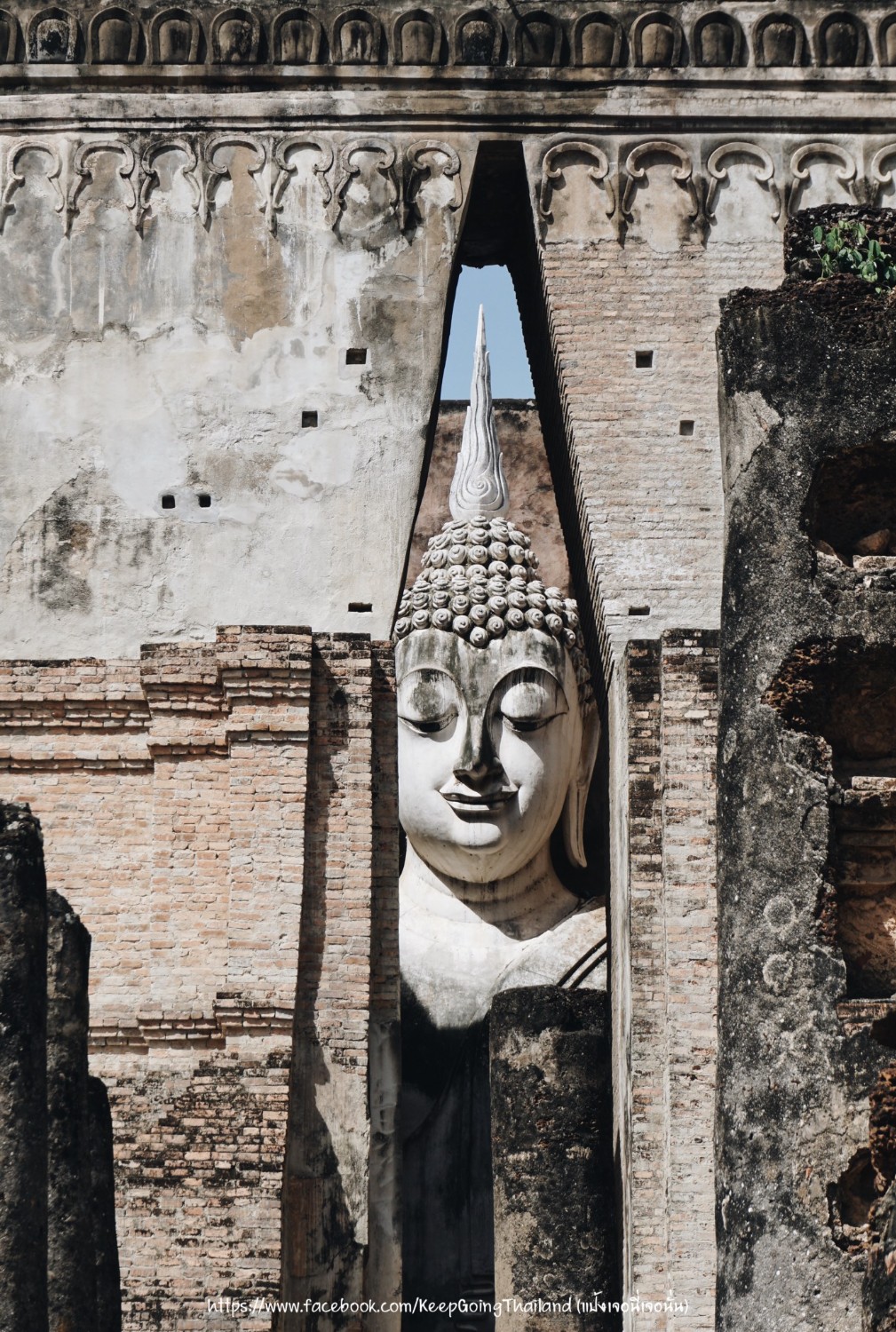
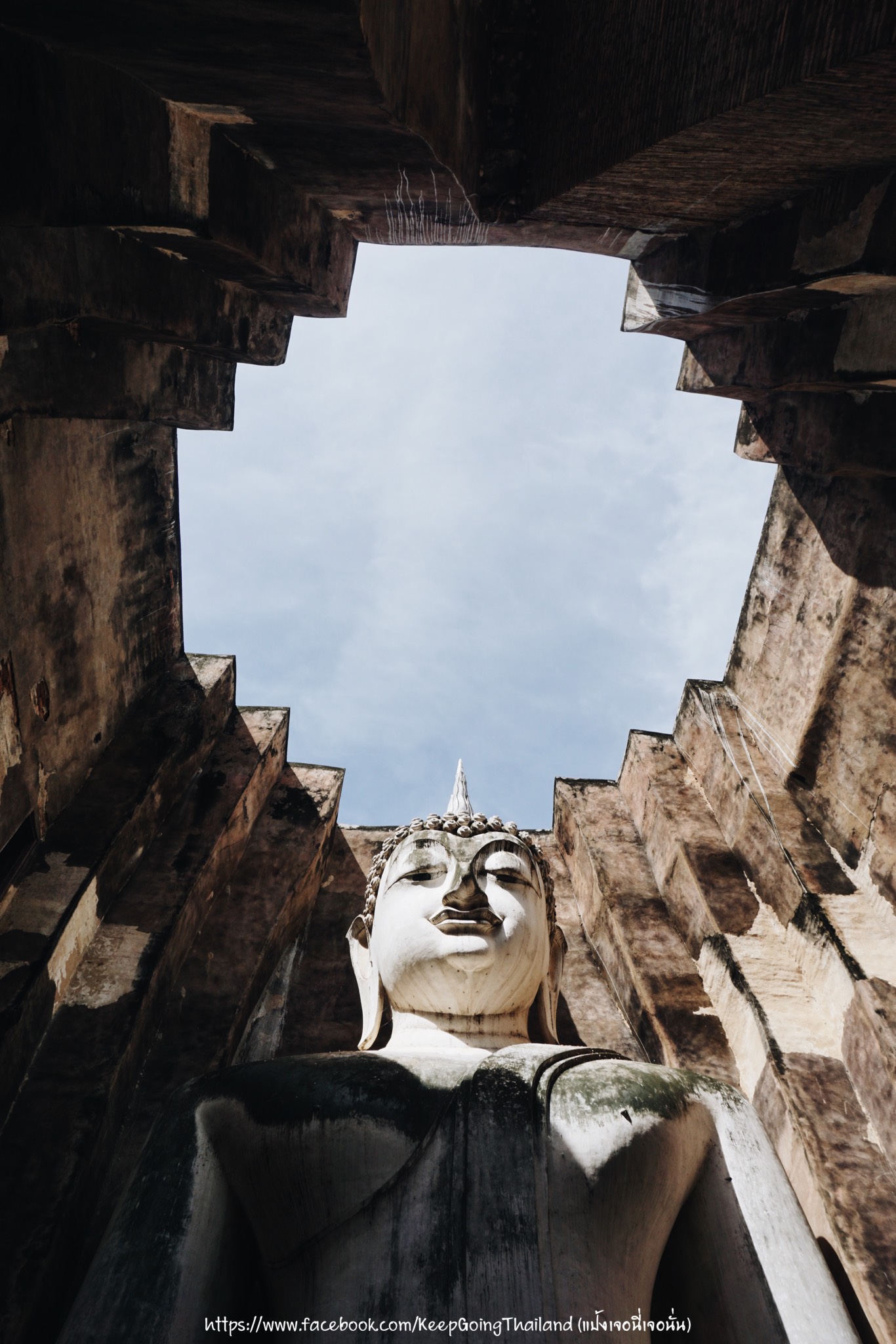
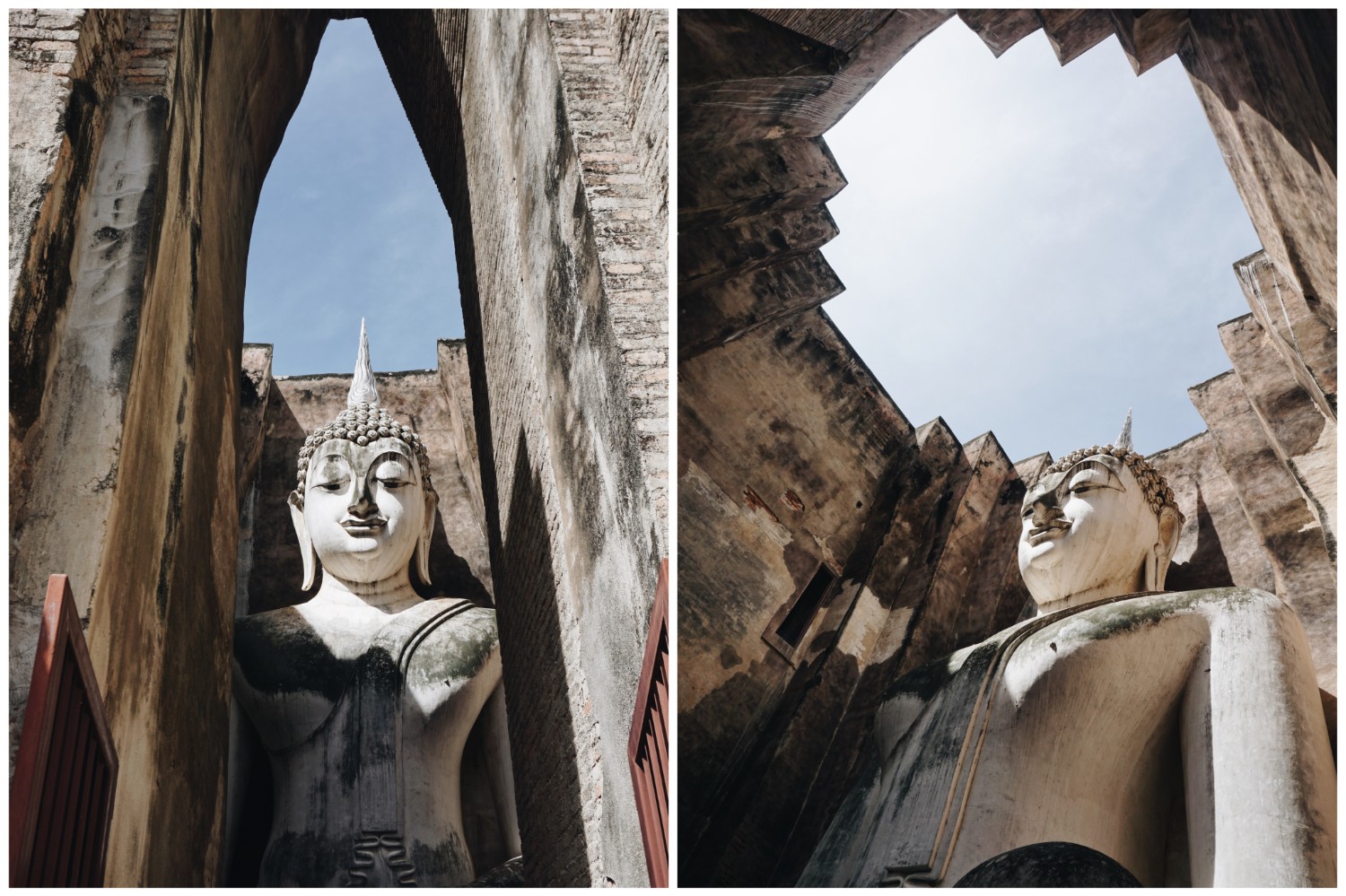
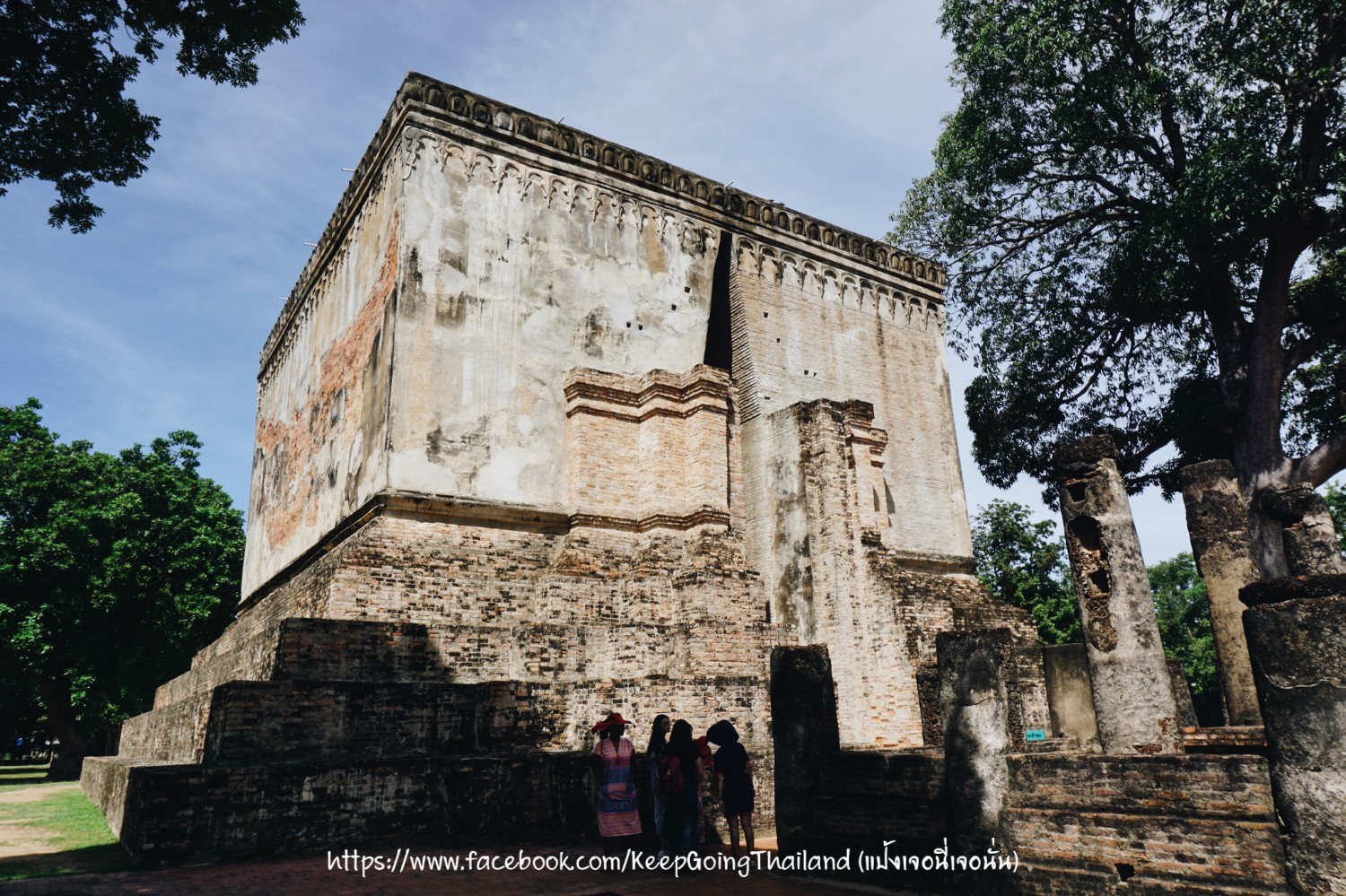
We returned from Wat Si Chum via the same route and returned the bicycles to the shop. The shop had several restrooms available, so we used them to wash our faces and change our clothes (our cycling clothes were soaked with sweat). The service was free, and the shop owner also gave us some travel advice. We were informed that the double-decker pickup trucks that used to run to the bus terminal were no longer frequently available. Instead, we were advised to take a minibus or van to Phitsanulok, which we could flag down in front of the bike rental shop. The owner was very kind and, knowing that we were new to the area, stayed with us until we got to the Sukhothai bus terminal. The van fare was 20 baht (to be sure, we confirmed with the driver that we would be dropped off at the Sukhothai bus terminal).
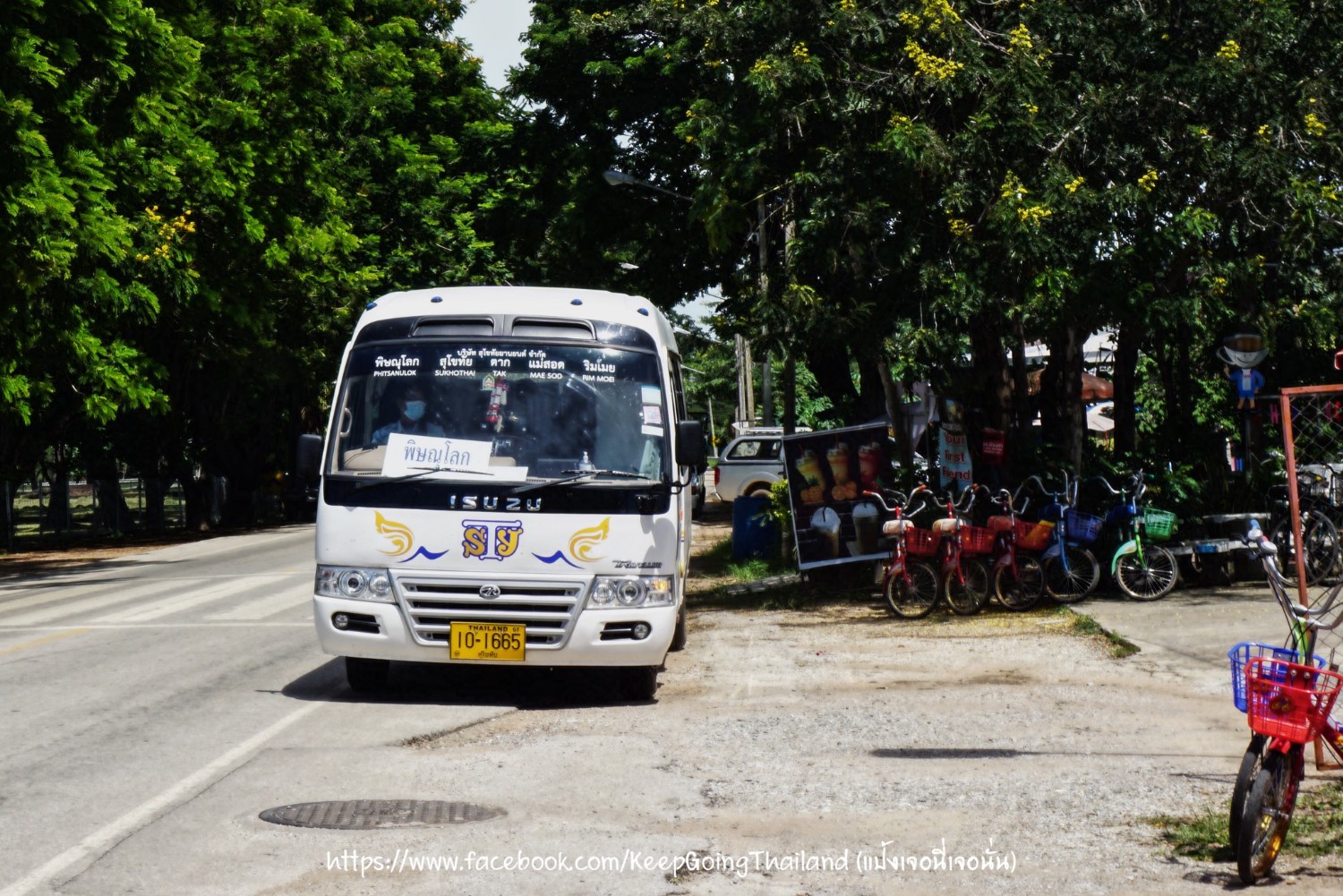
DAY 1: Check-in at Baan Na Ton Chan Homestay
Upon arrival at the bus terminal, purchase a ticket to Si Satchanalai district. Inform the ticket seller that your destination is Baan Na Ton Chan and request notification upon arrival. The staff will inform you which platform your air-conditioned bus (pictured below) will arrive at. The fare is 49 baht, and the journey takes approximately 1 hour and 15 minutes.

The driver dropped us off at the motorbike taxi stand at Haad Sai Khao beach and even called a motorbike taxi driver to take us to Na Ton Chan village. If you are traveling with a group, it is more convenient and economical to arrange for the accommodation to send a car to pick you up. However, as I was traveling alone, I had to take a motorbike taxi. The fare was 160 baht for a distance of about 17 kilometers. I asked for the driver's number so that he could pick me up on the way back. The nearest bus stop is the Haad Sai Khao bus stand. Due to the COVID-19 pandemic, the bus schedule has been updated. The bus back to Bangkok that I needed to catch departs at 9:30 AM, which means I had to check out of my accommodation and rush to catch the bus. The driver understood and arranged to pick me up at 8:15 AM.
Tourists arriving at Na Ton Chan village need to go to the community center to be picked up by their host. The community center is a place where handicrafts made by local people are sold, and there is a restaurant called Khao Pib Lom Yak. The restaurant offers a large bowl of Khao Pib, various types of Khao Pib, and Khao Pwan in different flavors. Khao Pib is a local dish of Na Ton Chan village. The method of steaming the dough is similar to that of Khao Kriab Pa Mong. Once the dough is cooked, glass noodles and vegetables are added. The dough is then folded to wrap the filling inside and served with soup. We ordered the Khao Pib Lom Yak and Khao Pwan with mixed vegetables. Overall, we thought it tasted similar to suki without dipping sauce. We got a large piece of pork bone with meat. As for the Khao Pwan with vegetables, we liked the Khao Pwan with chili the most.


Across the street is a shop selling sarongs and northern Thai outfits. If you haven't brought an outfit for taking photos, you can stop by and buy one.
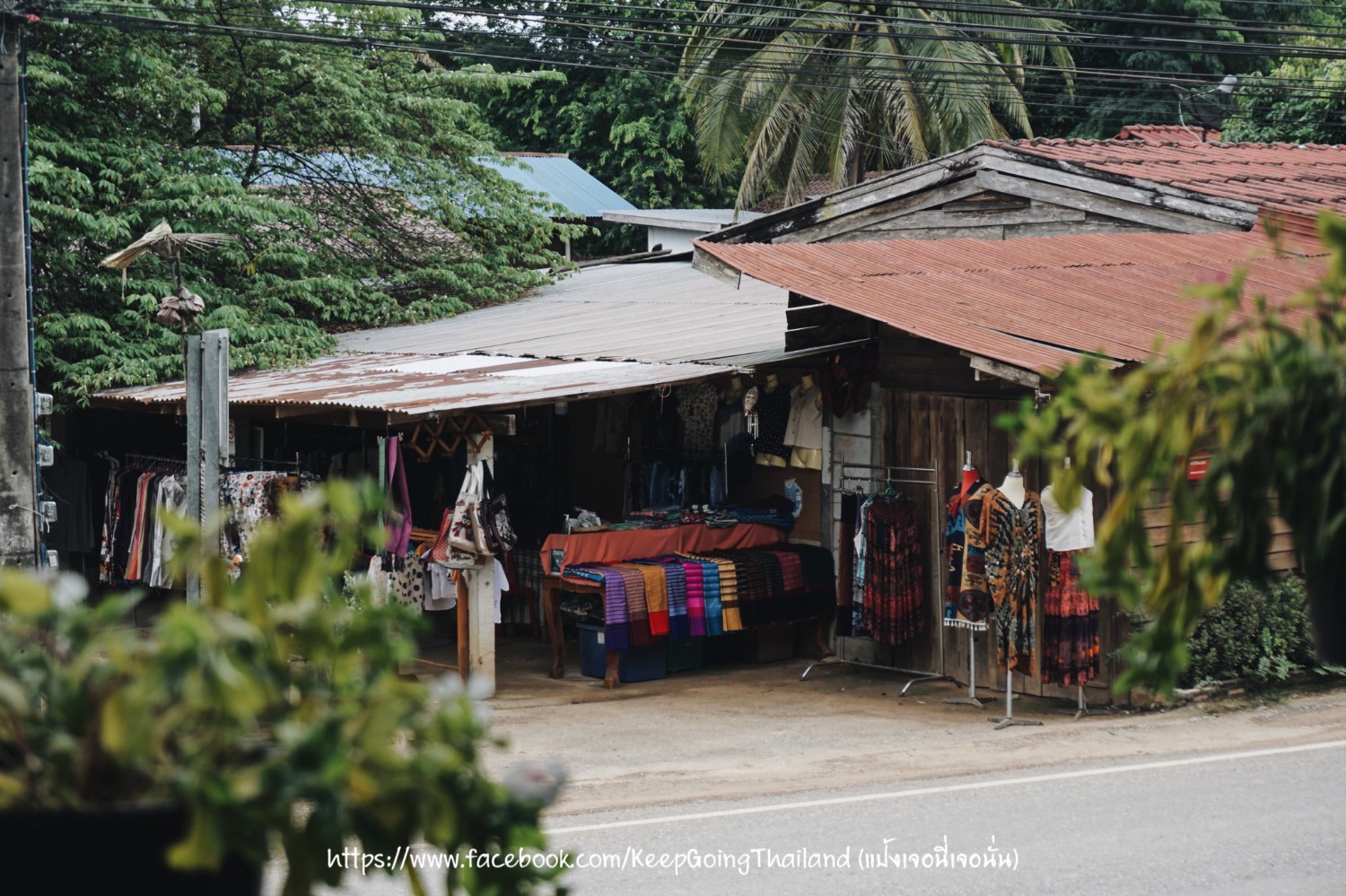
Two-Day, One-Night Trip to Ban Na Ton Chan
Day 1
- 3:00 PM: Arrival at the community center and check-in to your accommodation.
- 4:30 PM: Bike ride through the fields to watch the sunset at the bridge.
- 6:30 PM: Dinner.
Day 2
- 6:30 AM: Choose between offering alms to monks in front of your house or watching the sunrise at Huai Ton Hai (due to overlapping times).
- 7:30 AM: Breakfast.
- 8:30 AM: Bike ride to observe traditional weaving techniques under houses.
- Activities:
- Witness the creation of "Bar No" dolls at Baan Tawong.
- Sample seasonal fruits.
- Observe the mud-dyeing process.
- View products made from mud-dyed fabric.
- 11:30 AM: Learn and try making "Khao Peep," a local dish.
- (Note: Activities may be adjusted depending on the departure time of your bus. In this case, the evening bike tour through the village will take place on the first day after arrival.)
Accommodation Rates
- 600 THB per person, 250 THB for children under 5 years old, 700 THB for foreigners.
- This price includes dinner, breakfast, one night's accommodation, and activities with a local guide.
- Air-conditioned rooms are available for an additional 300 THB per room.
- For more information, please visit the homestay's Facebook page.
Special Thanks
We would like to express our gratitude to the Ban Na Ton Chan Homestay Facebook page for providing the information above.
Personal Experience
We stayed at Baan Mae Chanthra, a small house within the larger Baan Chanthra homestay owned by Tum and Phong. We traveled solo for this trip, and the homestay center arranged for us to stay here. Several days before our arrival, Tum called us to inquire about our travel plans, whether we were traveling alone, and what activities we were interested in. They also provided us with comprehensive travel information.
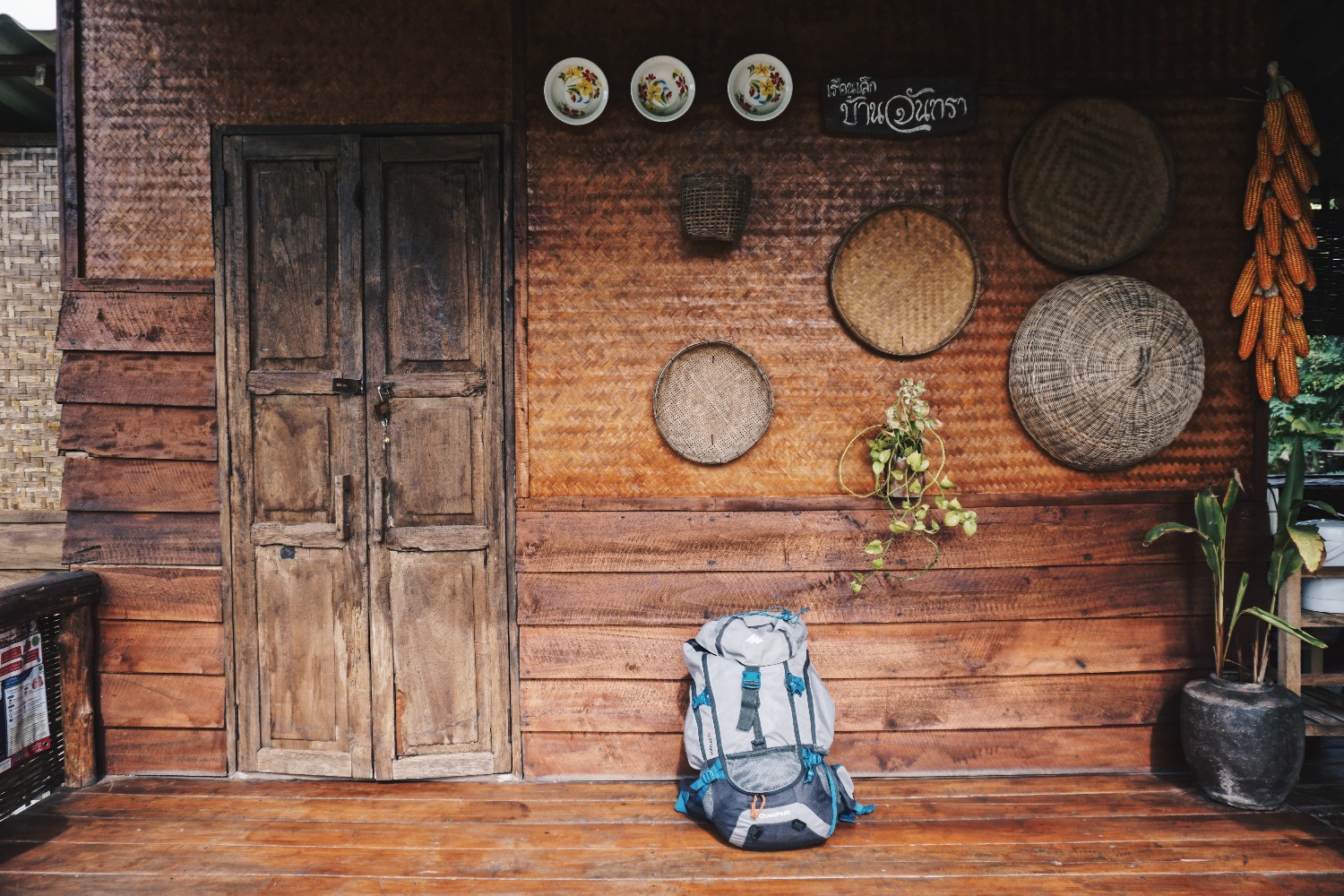
Baan Mae Janthara offers two homestays. If you come with a large group, you will stay in the larger house. If you come alone, you will stay in the smaller house. The house is separate and private, with an en-suite bathroom with a hot water heater, a fan room, towels, pillows, bed sheets, clean mosquito nets, and fragrant bedding. The room has an extension cord. The living area has a TV, drinking water, a hot water kettle, coffee, and ice. We like the hammock corner in front of the house. During this time, you can lie down and enjoy the beautiful view of the green rice fields, which is pleasing to the eye and good for the heart.

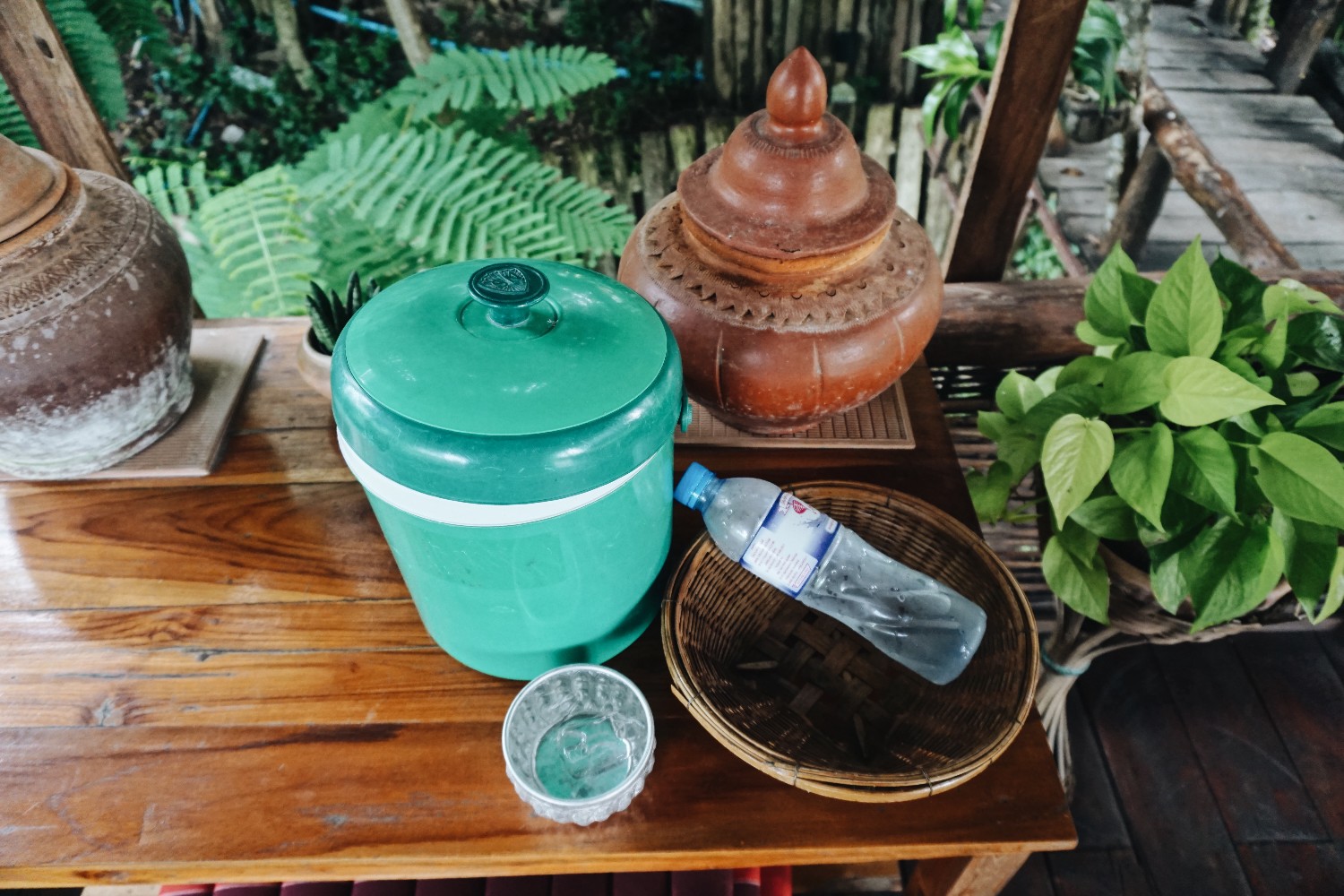

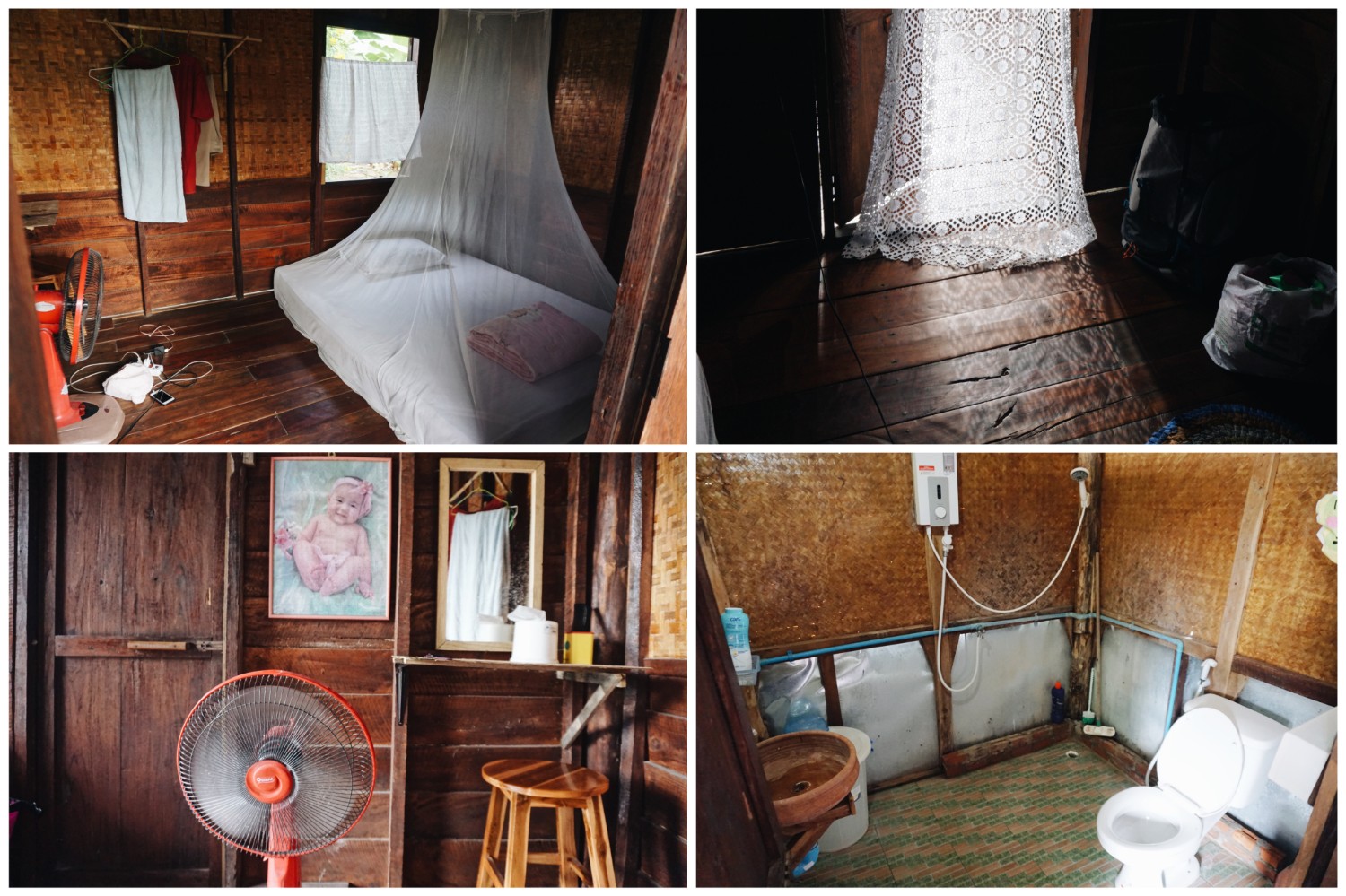
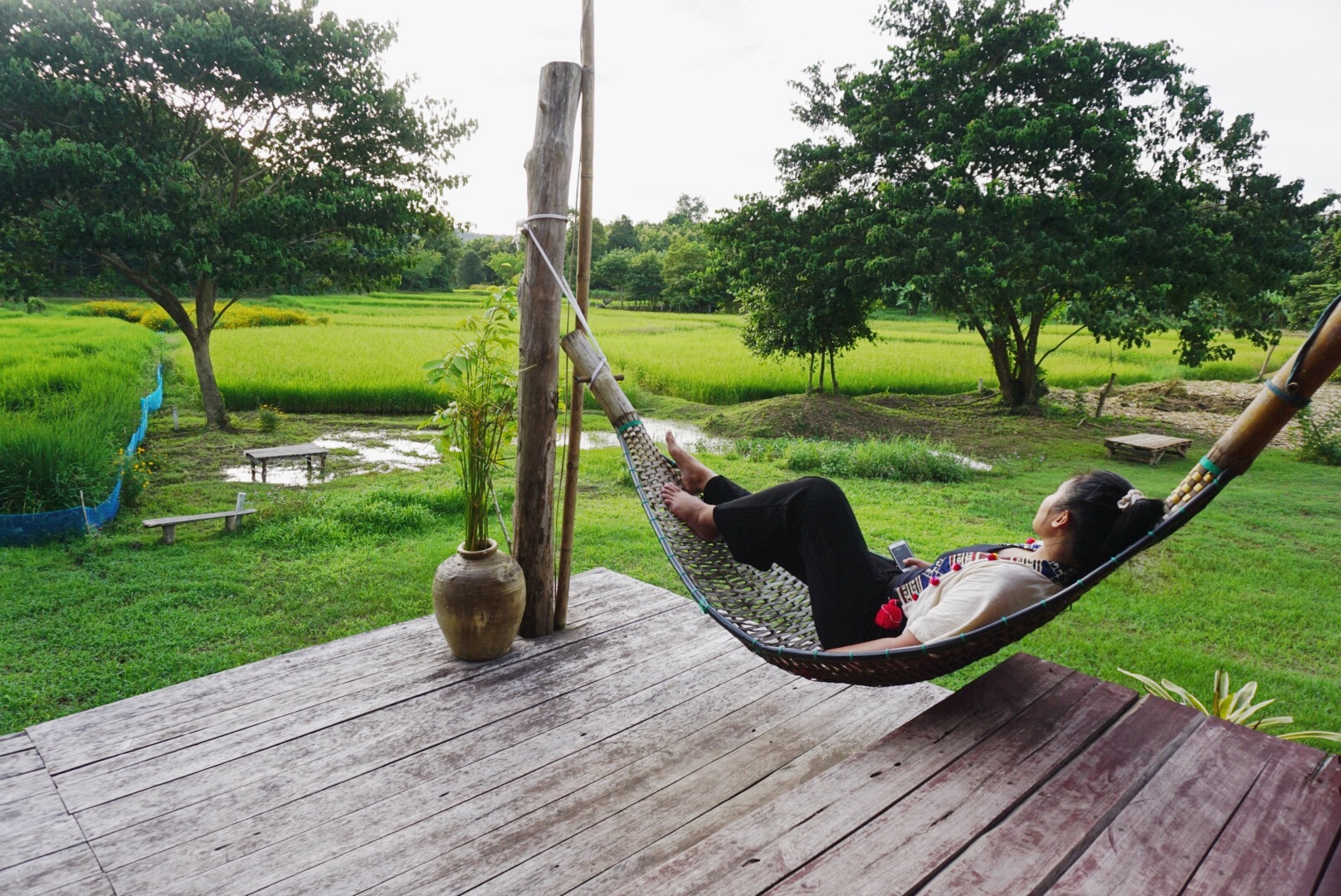
DAY 1: Cycling through the community of Ban Na Ton Chan, admiring the rice fields and the sunset
After Tum dropped us off at our accommodation, we arranged for a local guide to take us on a bike tour of the village at 4 pm. The bike rental fee was 30 baht, and the guide's service was free, but we bought snacks for him as a token of appreciation. Our first stop was to see how the "Bar Nor" dolls are made at the house of Ta Wong. This is a local wisdom that Ta Wong invented, but he has since passed away. The "Bar Nor" dolls are wooden carvings of people performing gymnastic exercises. The guide told us that in the past, people did not drink milk, and if they wanted to grow tall, they had to hang on a bar. The "Bar Nor" dolls are therefore a way of recreating the lifestyle of people in the past as a toy. By squeezing the end of the stick, the doll will move into different positions, including some difficult ones. The guide said that you need to practice playing it often to be able to do it. The benefit of playing with the "Bar Nor" doll is that it can be used to exercise your hands. If you are interested, you can order one and it will be delivered to you later by post.
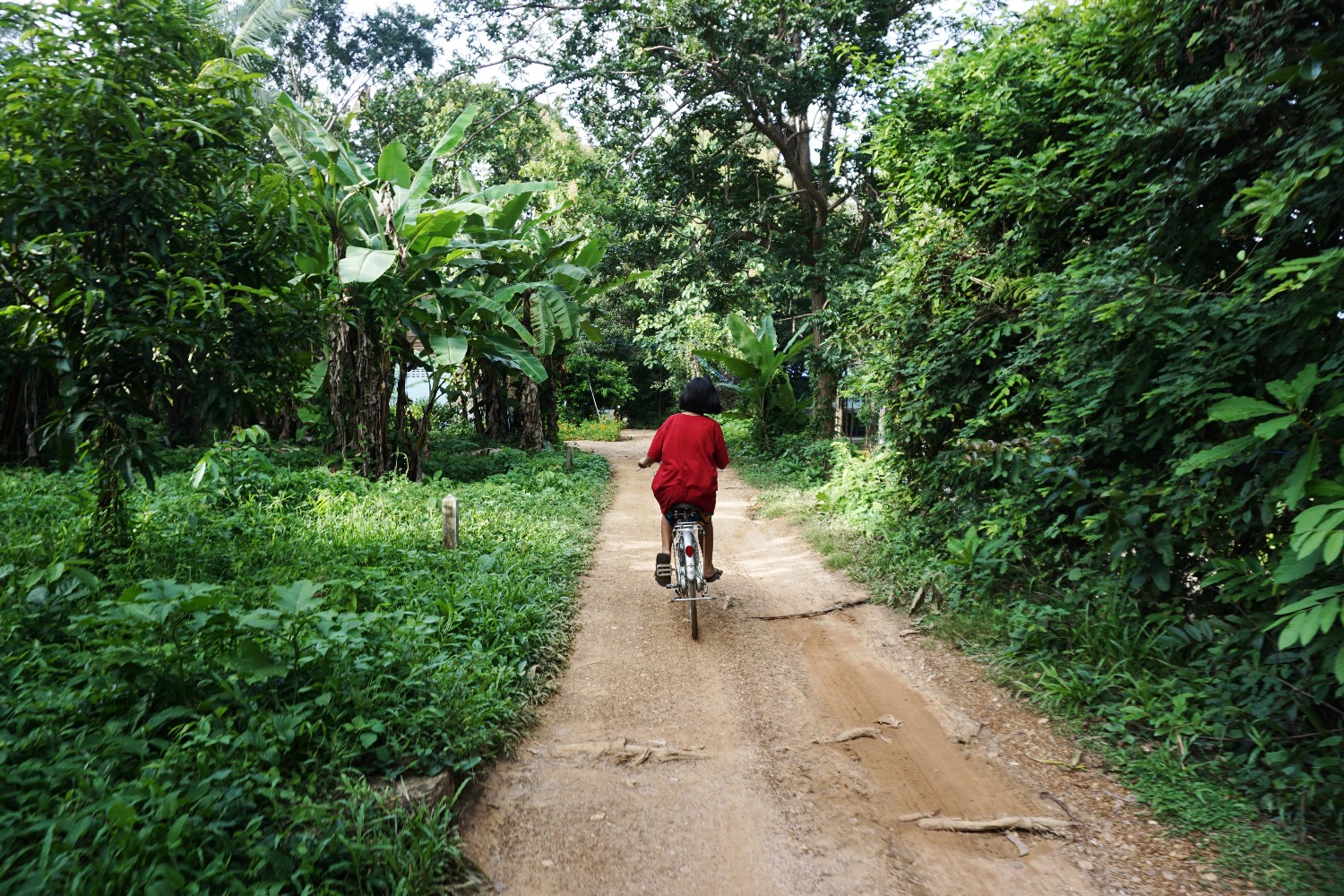
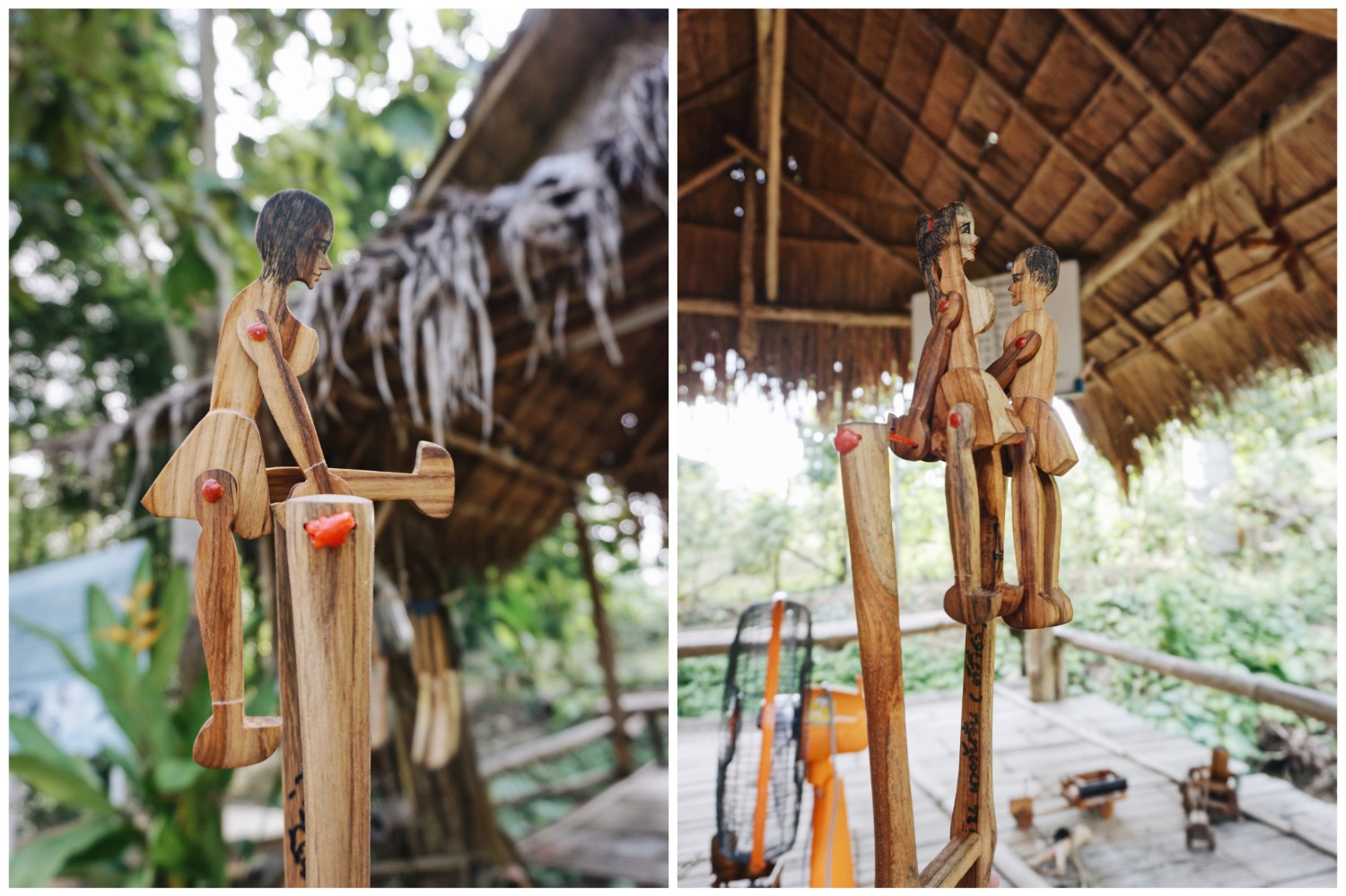
The tour guide led us to the Achi Homestay, a model homestay where we could take photos and explore the area around the front of the house and under the stilts. The upper floor is reserved as a private space for tourists staying in this particular house. We noticed that each house has its own unique charm, with some offering views of rice fields and others being treehouses. However, all houses maintain the same standard and have received the same certifications. This variety in accommodation is what makes us want to return and stay in other homestays. If you have already visited, you can inform the center during your next booking that you would like to stay in a different house. They will then arrange it for you.
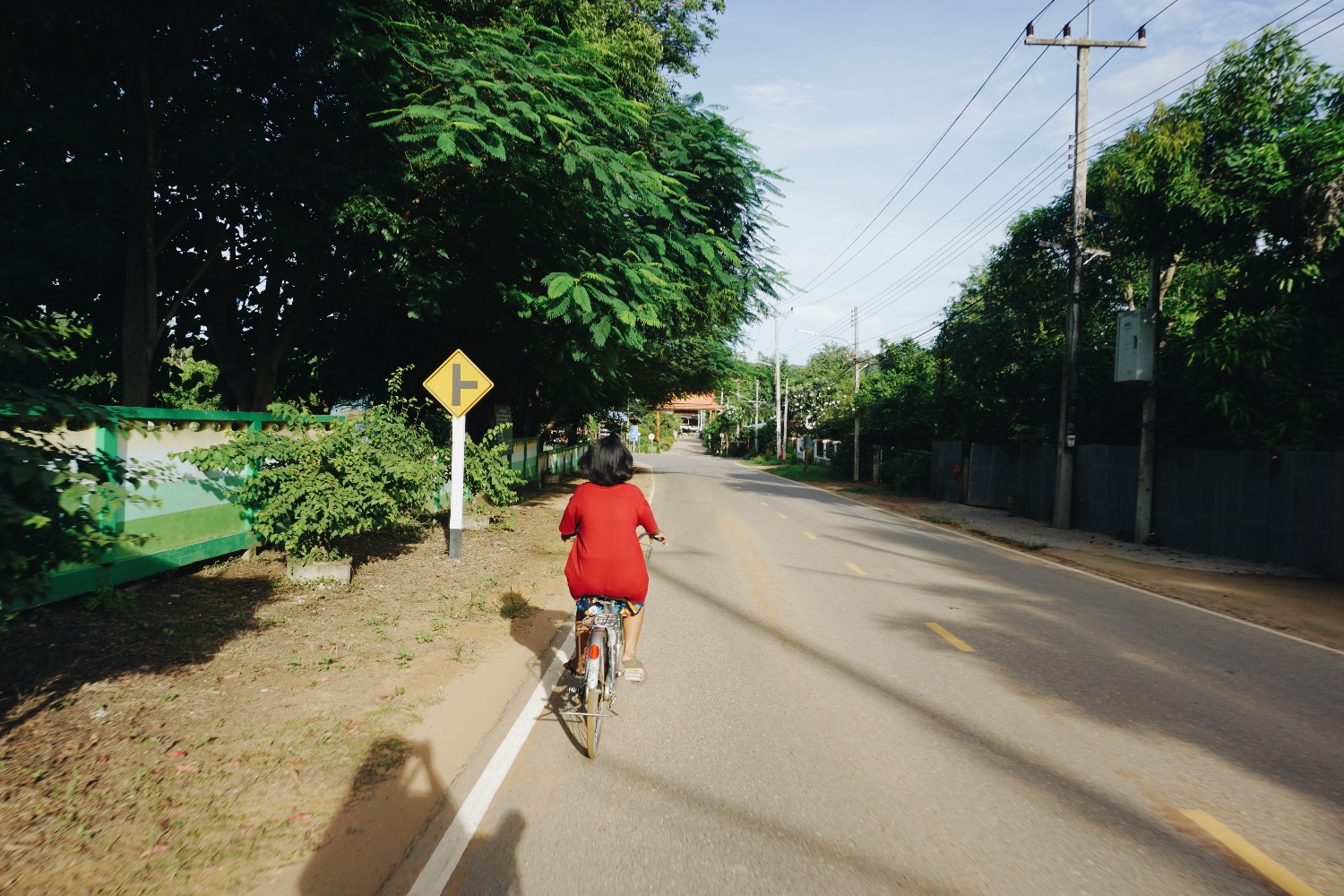
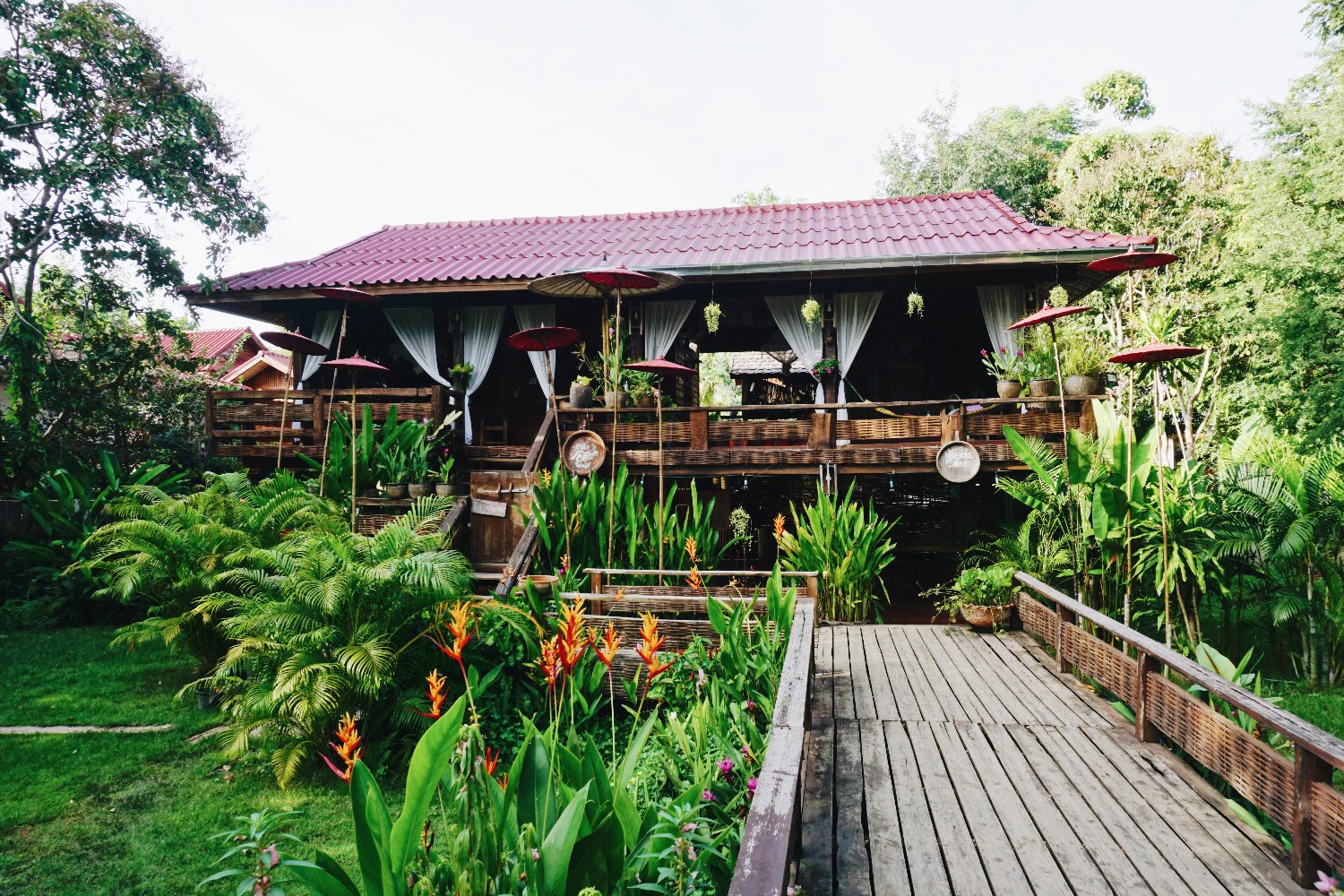
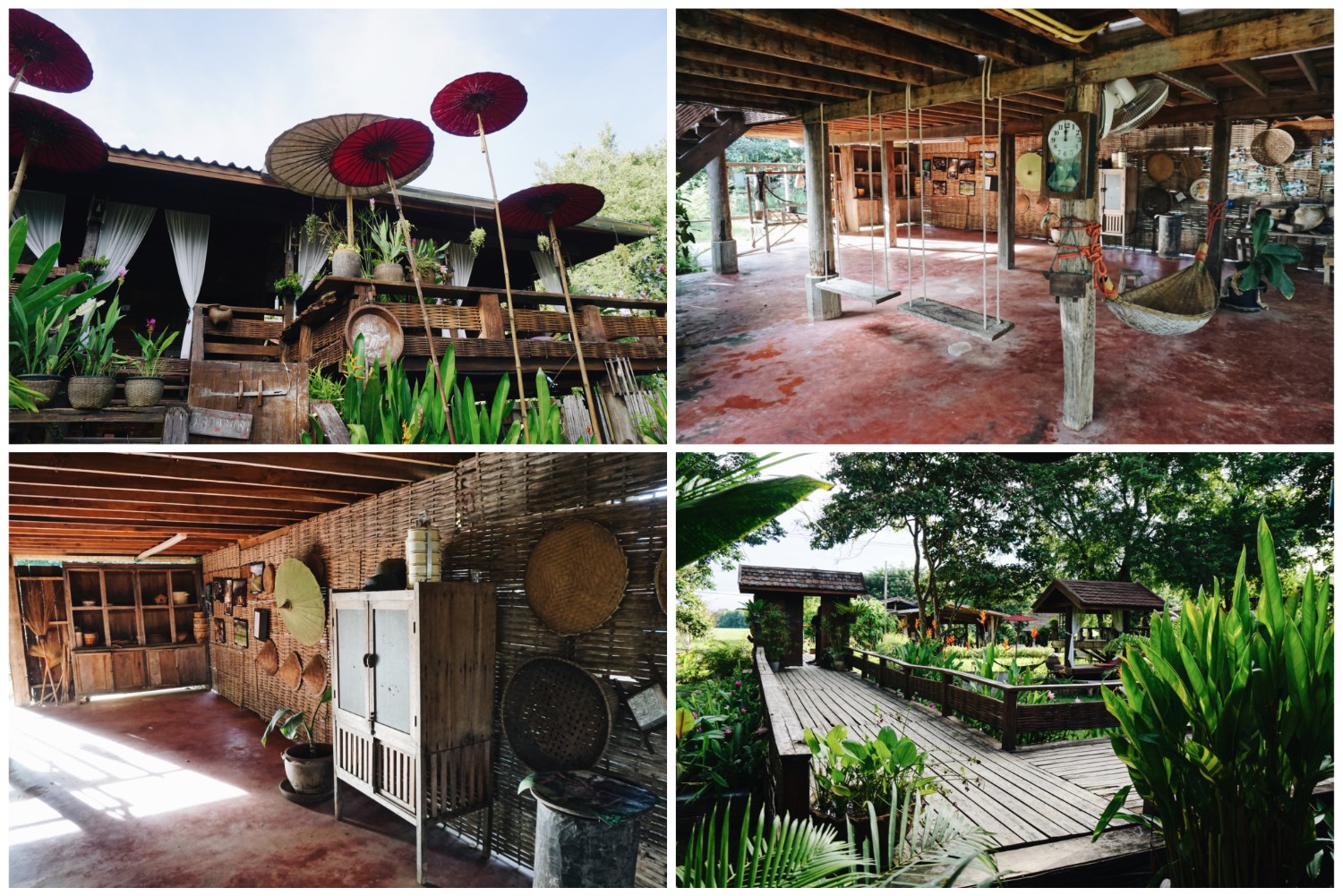
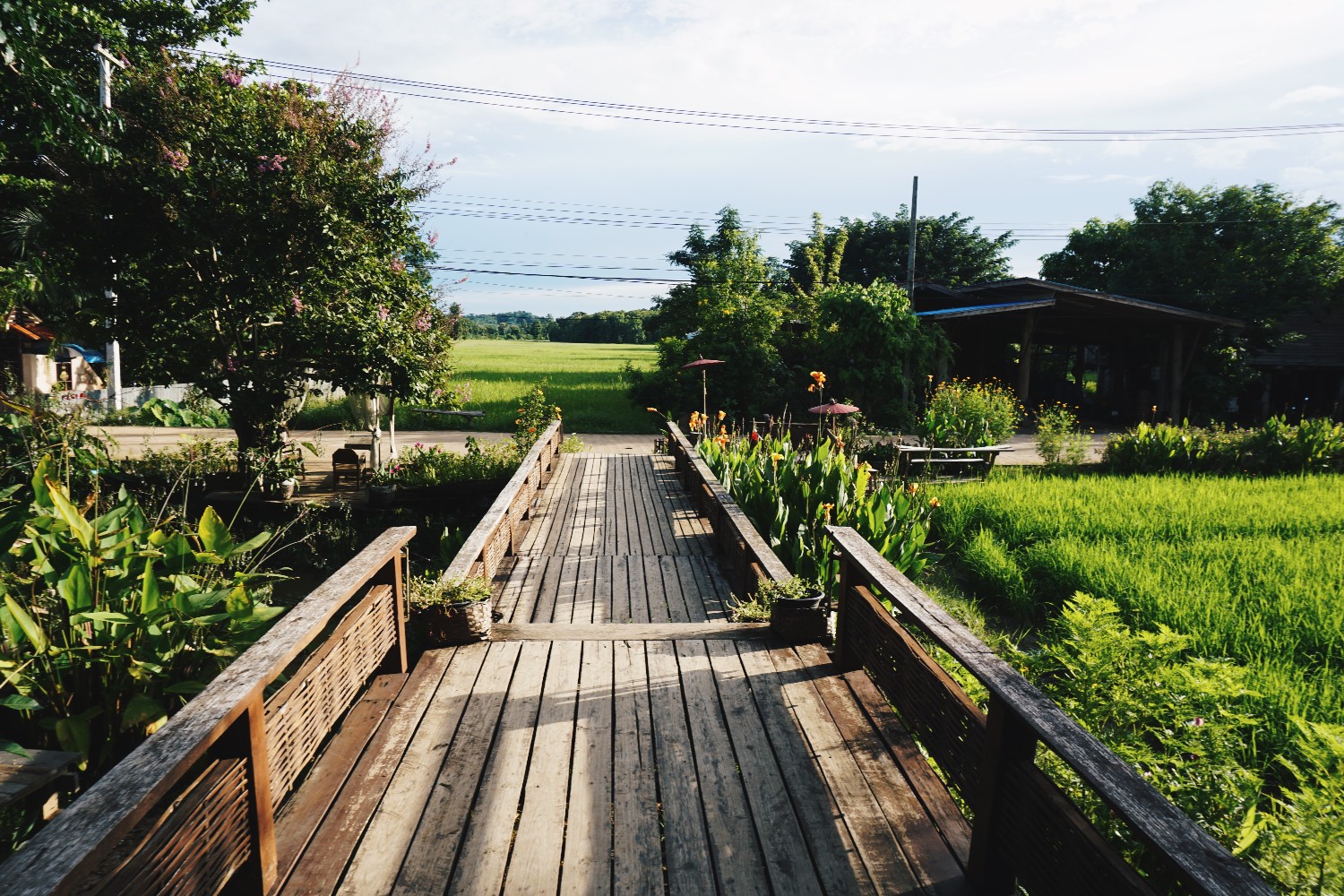
Continuing on to the weaving under the house, the guide demonstrated weaving for us. We can actually try weaving ourselves, with the pattern code written down for us to follow. It seems easy, right? In reality, it's very difficult for beginners because the hands and feet don't cooperate. The freshly woven fabric can be purchased for around one hundred baht. However, if it is fermented in mud, a traditional wisdom that makes the fabric soft using natural methods, the price will be as high as several thousand baht. Anyone interested in buying mud-fermented fabric or other community products can purchase them at the community center's shop.
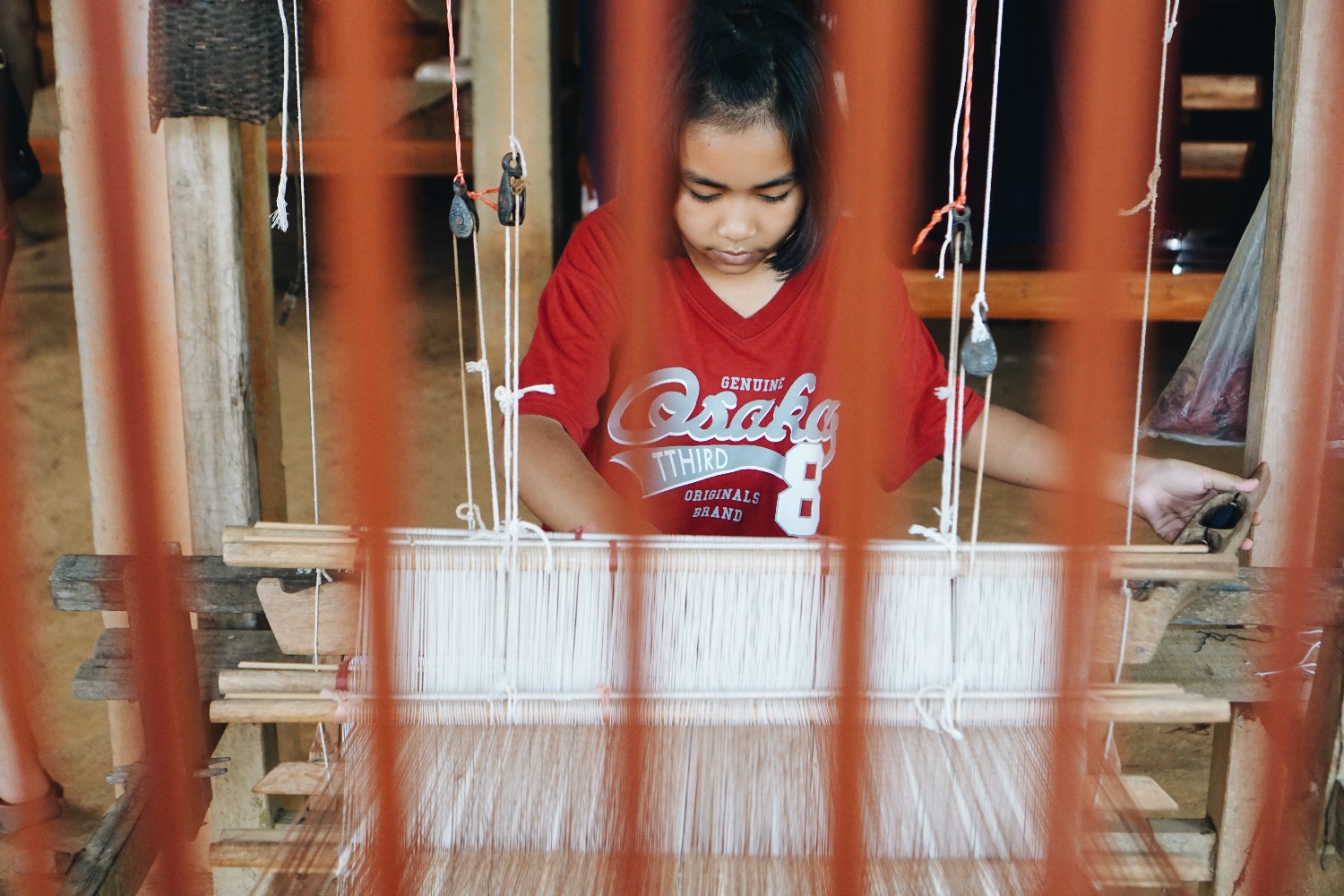
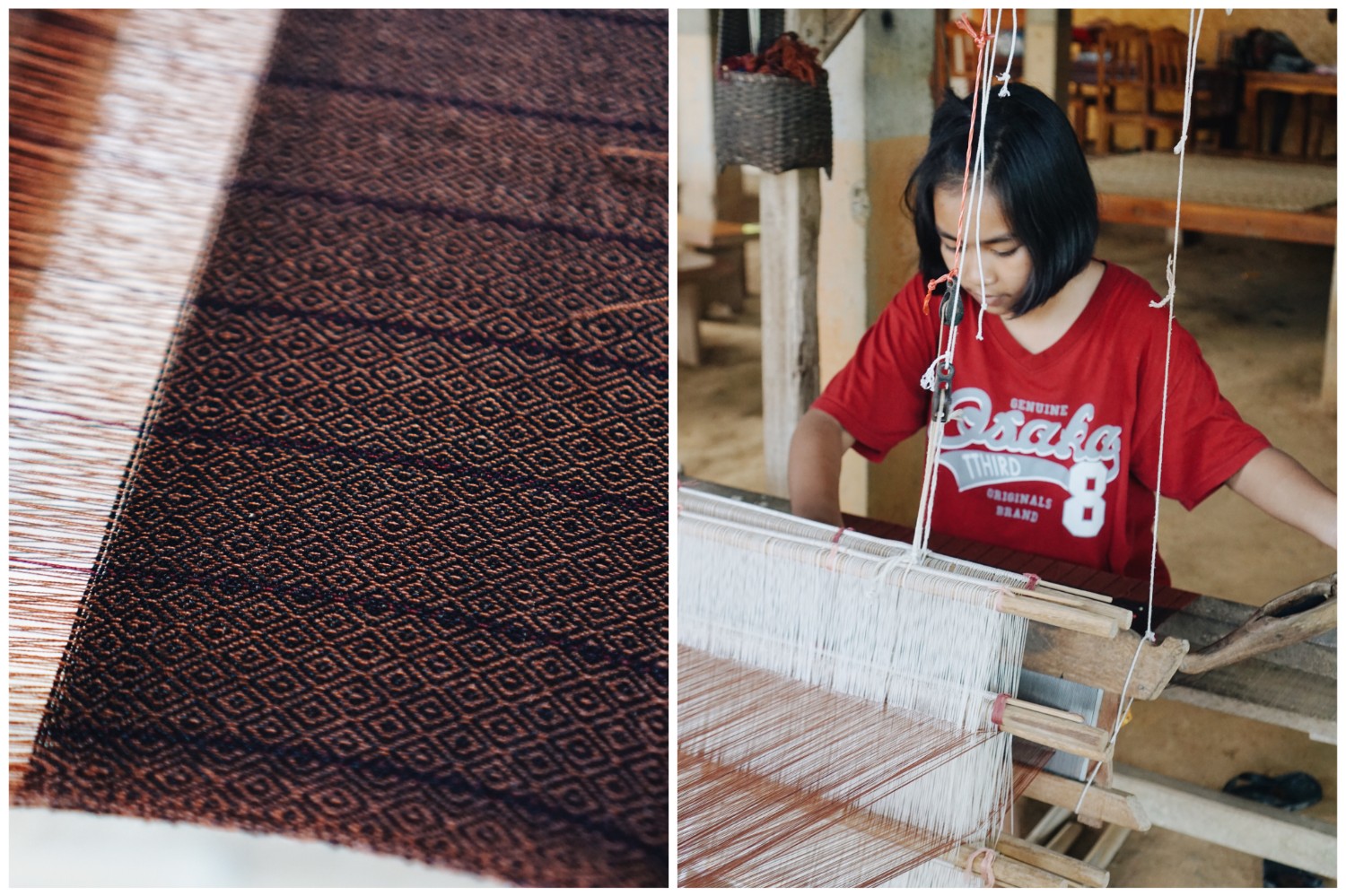
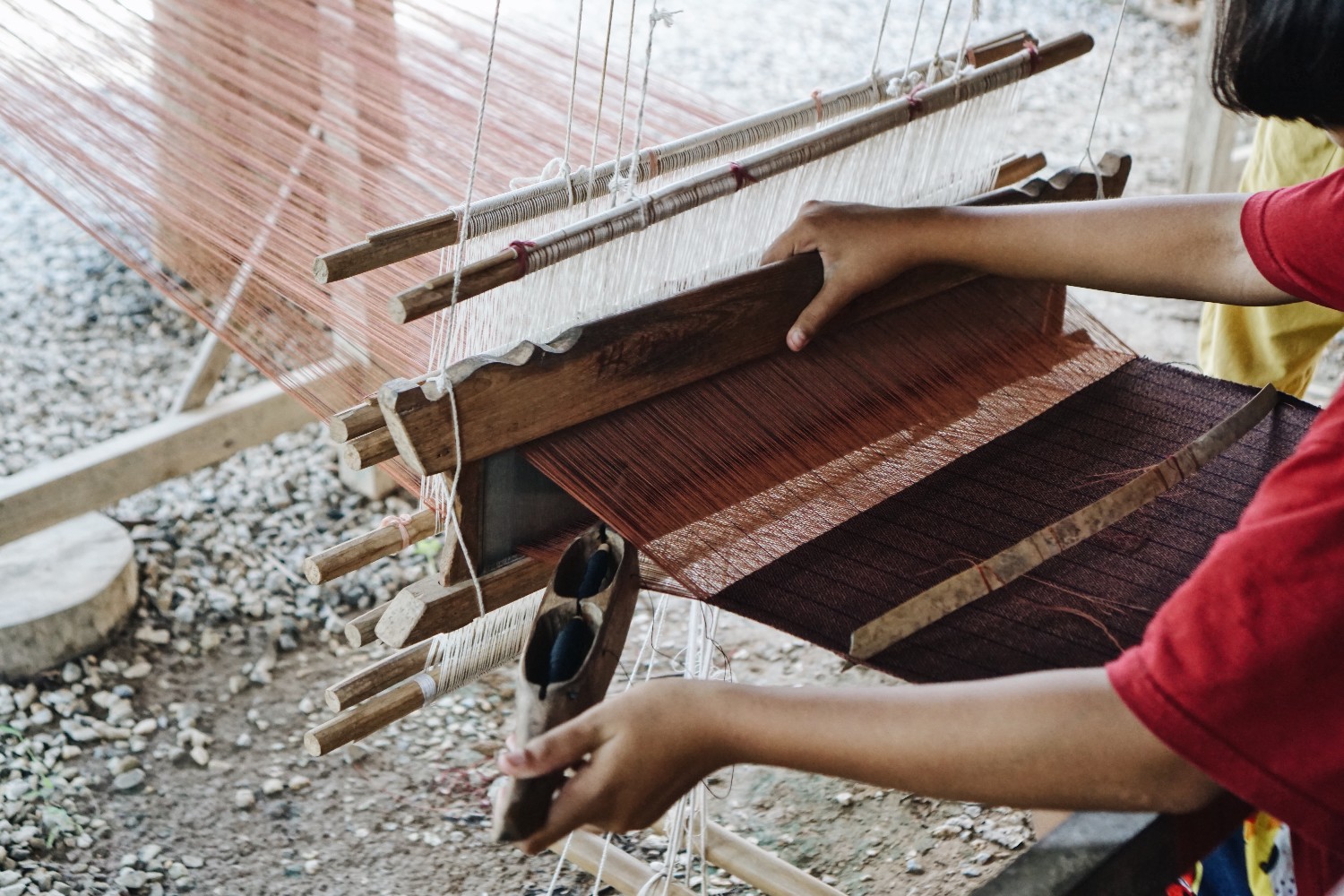
A Tranquil Escape: Exploring the Rice Fields and Cosmos Flowers
Our cycling tour through the village culminated at the bridge connecting the rice fields. A short walk led us to a vast expanse of verdant rice paddies and a vibrant field of yellow cosmos flowers, a sight that soothed both the eyes and the soul. A small pavilion offered respite from the sun, which was casting its golden rays across the landscape as the sun began its descent.
For those who wish to linger and witness the sunset, a hat and umbrella are recommended for protection from the sun and can also serve as photographic props. Having captured numerous photographs, we decided to call it a day, as the lack of sleep from the previous night and our early morning adventures had left us yearning for our pillows and beds.
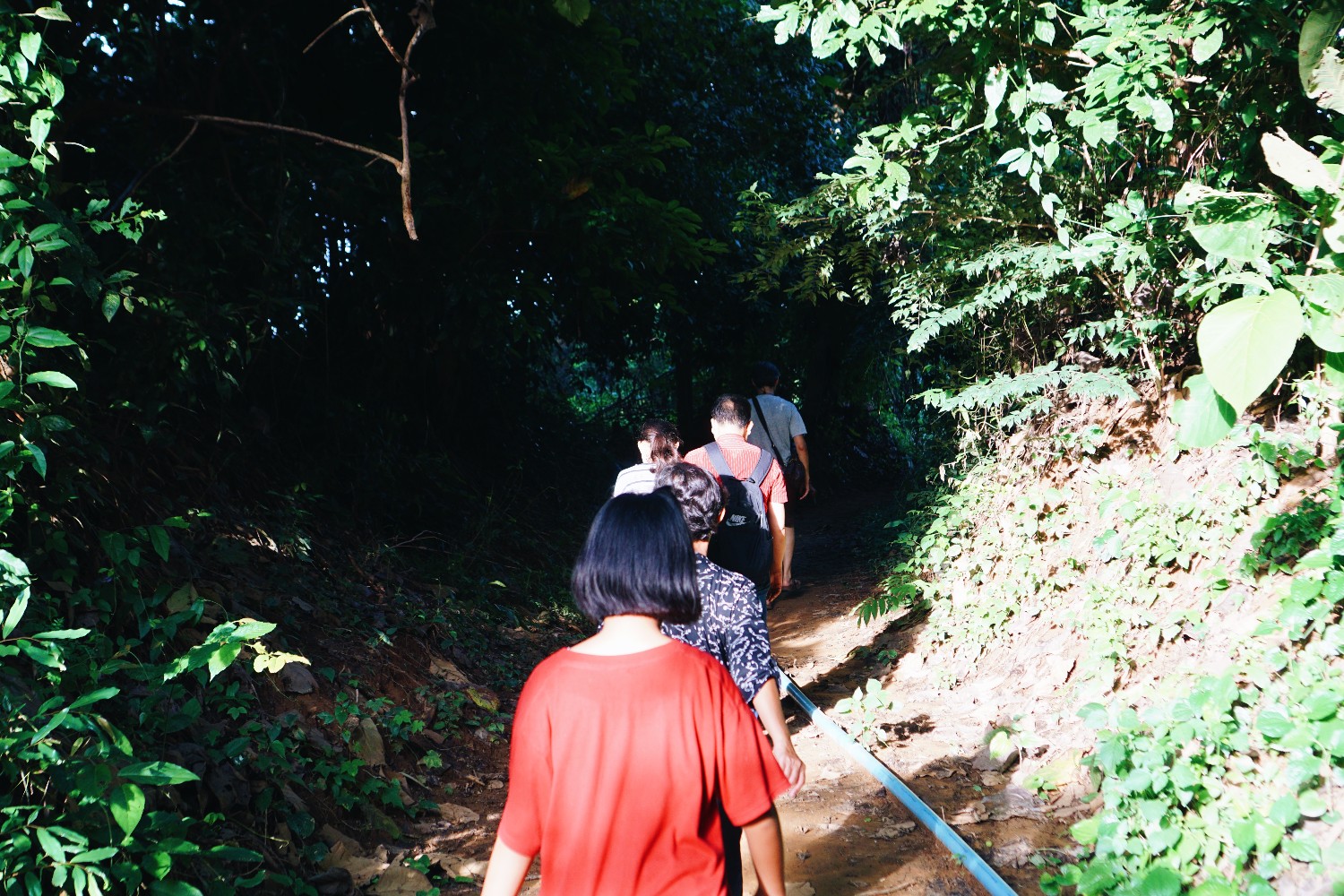
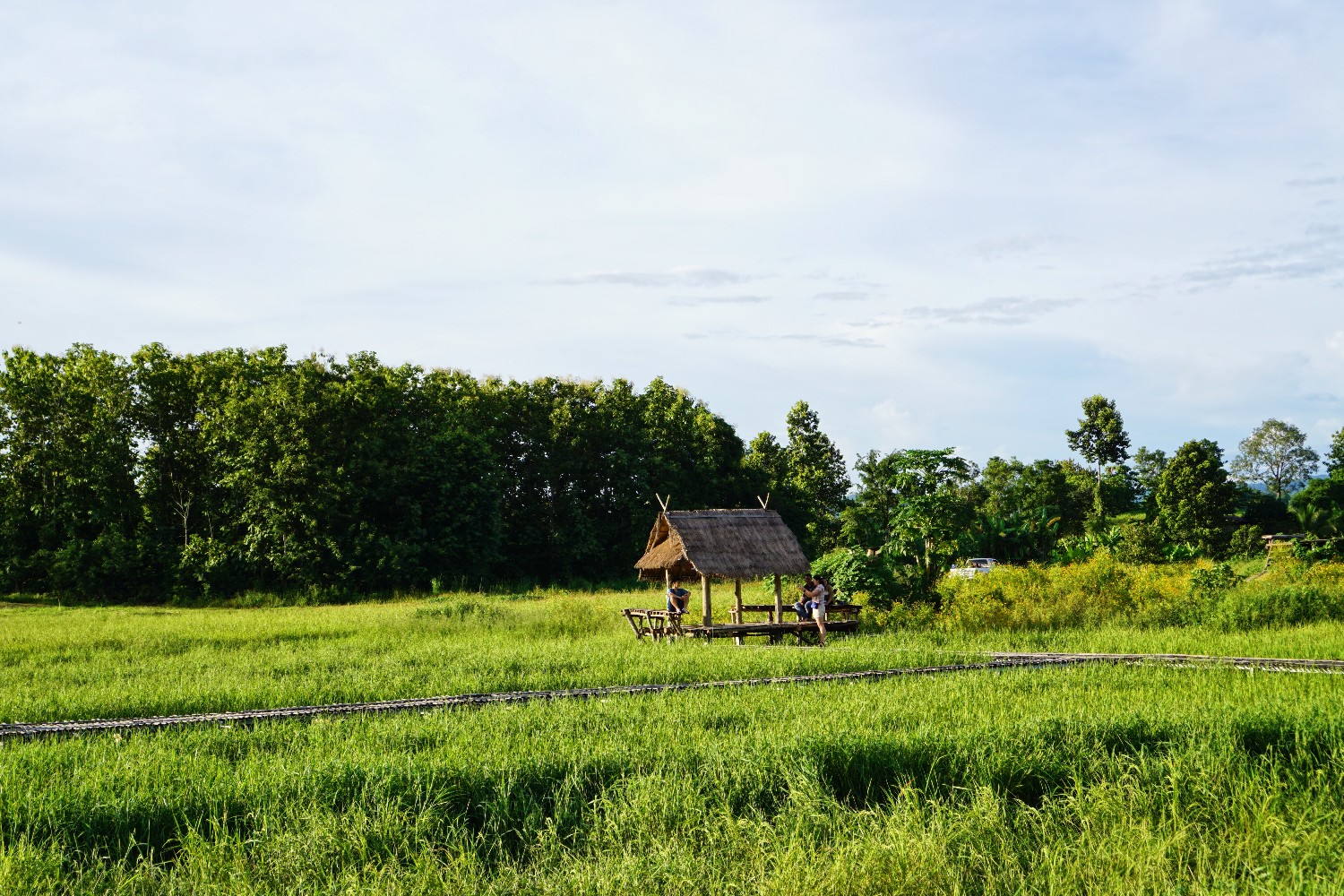
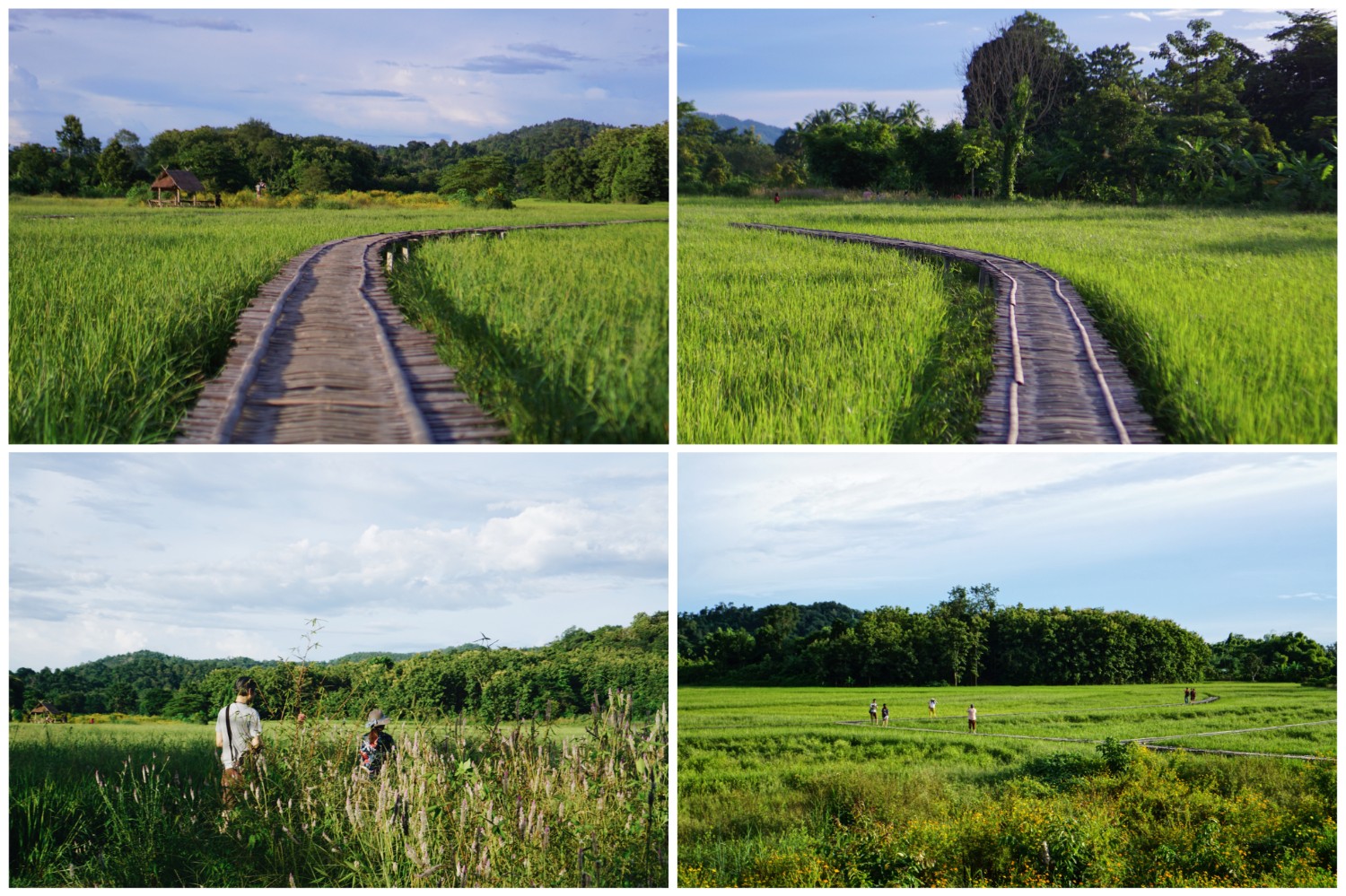

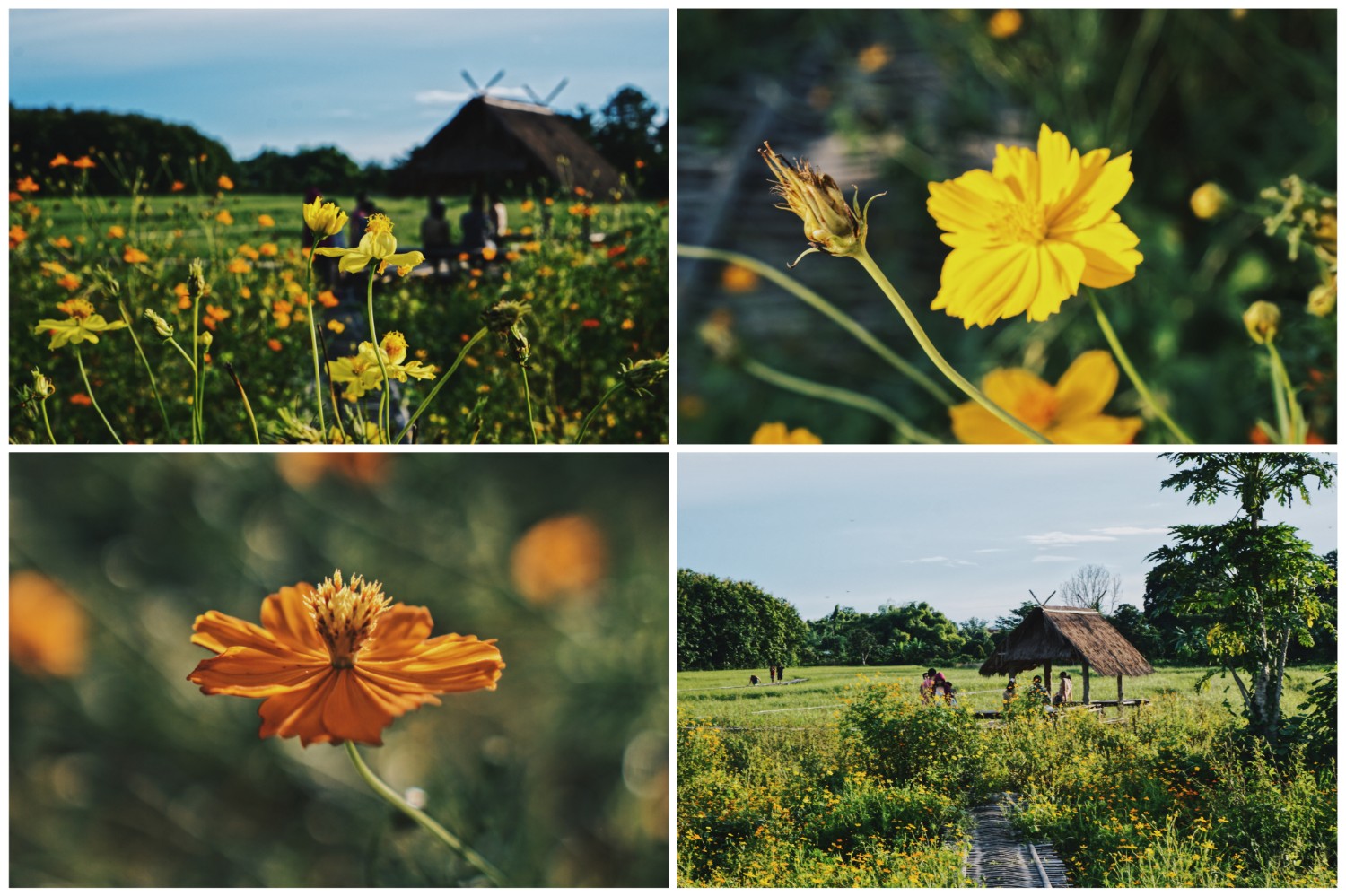
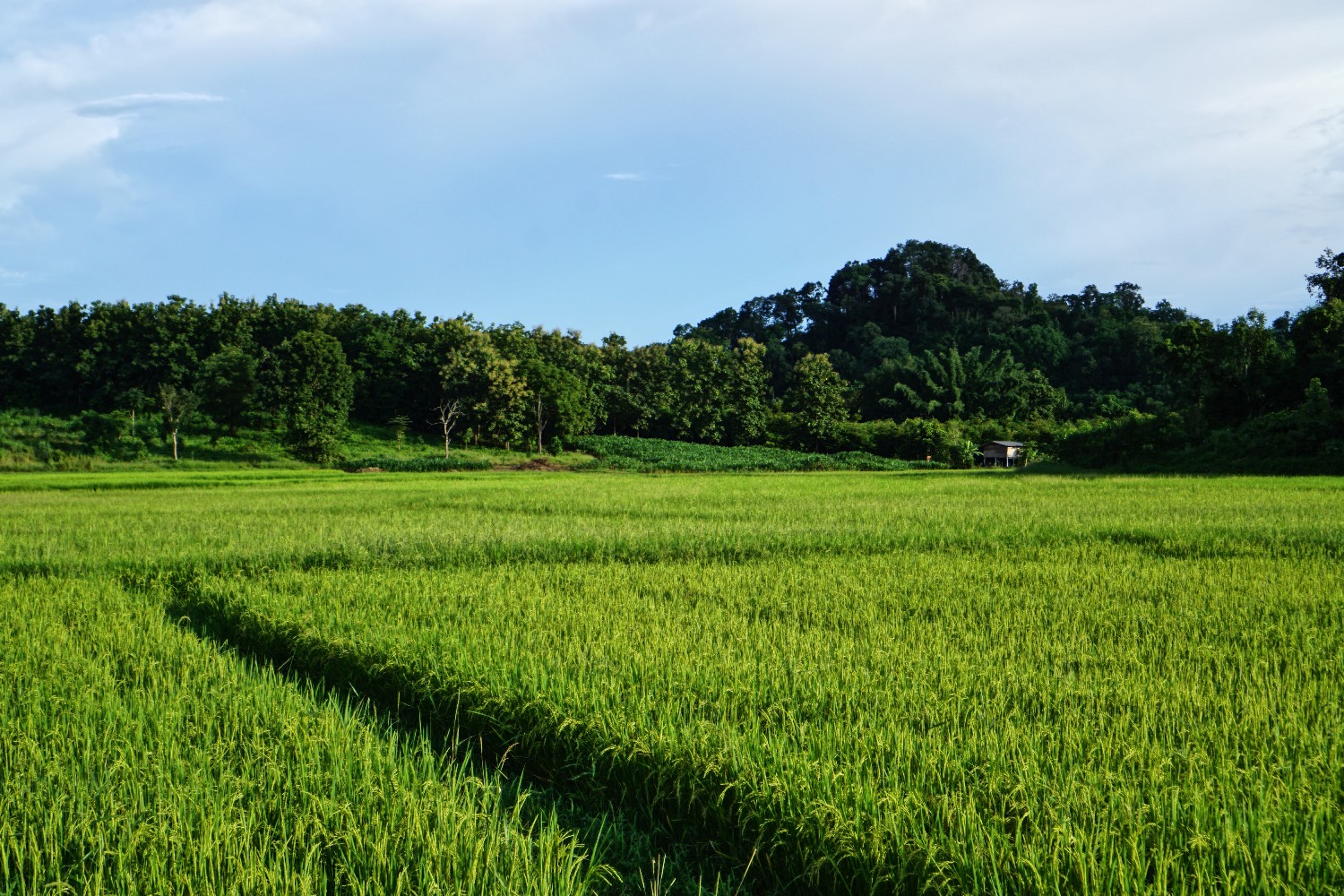
A fantastic dinner! I was so tired and sleepy when I arrived at the homestay, but my eyes widened with excitement when I saw the spread. Even though I was alone, the food prepared by Tum was plentiful and impressive. The use of bamboo cylinders instead of plates and the arrangement of various vegetables were visually appealing. After I had eaten for a while, Tum came in and asked if the food was good and how it tasted. She also said that she would be happy if I finished everything. Every dish in the khantoke was delicious, including the local-style laab kua, which had a mild flavor that made it easy to eat until I finished it all. The steamed fish with its delicious dipping sauce would be bigger if I came with a larger group. The stir-fried bamboo shoots were my favorite because I already love bamboo shoots, but I had never had them stir-fried with eggs before. It was so delicious that I finished the entire bamboo cylinder. Another dish tasted like tom kha gai but with either banana blossom or young jackfruit. I can't remember exactly, but Tum told me. The last dish, which you can only find here, was nam prik sok khai. When I first heard it, I thought, "Huh?" in my head, haha! But "sok" means to pound or crush lightly, which is how nam prik sok khai is made. It had a strong, spicy, sour, and salty flavor and was delicious with the pesticide-free blanched vegetables. I finished with seasonal fruits (if you come during durian season, it will be included in the khantoke as well). I ate until I couldn't get up, but I still didn't finish everything. It was almost 8 pm because there was so much food. Pong told me that they couldn't serve less because it wouldn't be "true to the picture." If the khantoke isn't plentiful and impressive, it wouldn't be beautiful. Whatever they post on the homestay's page, you get the real thing. It was definitely true to the picture! One meal was more than worth the 600 baht.

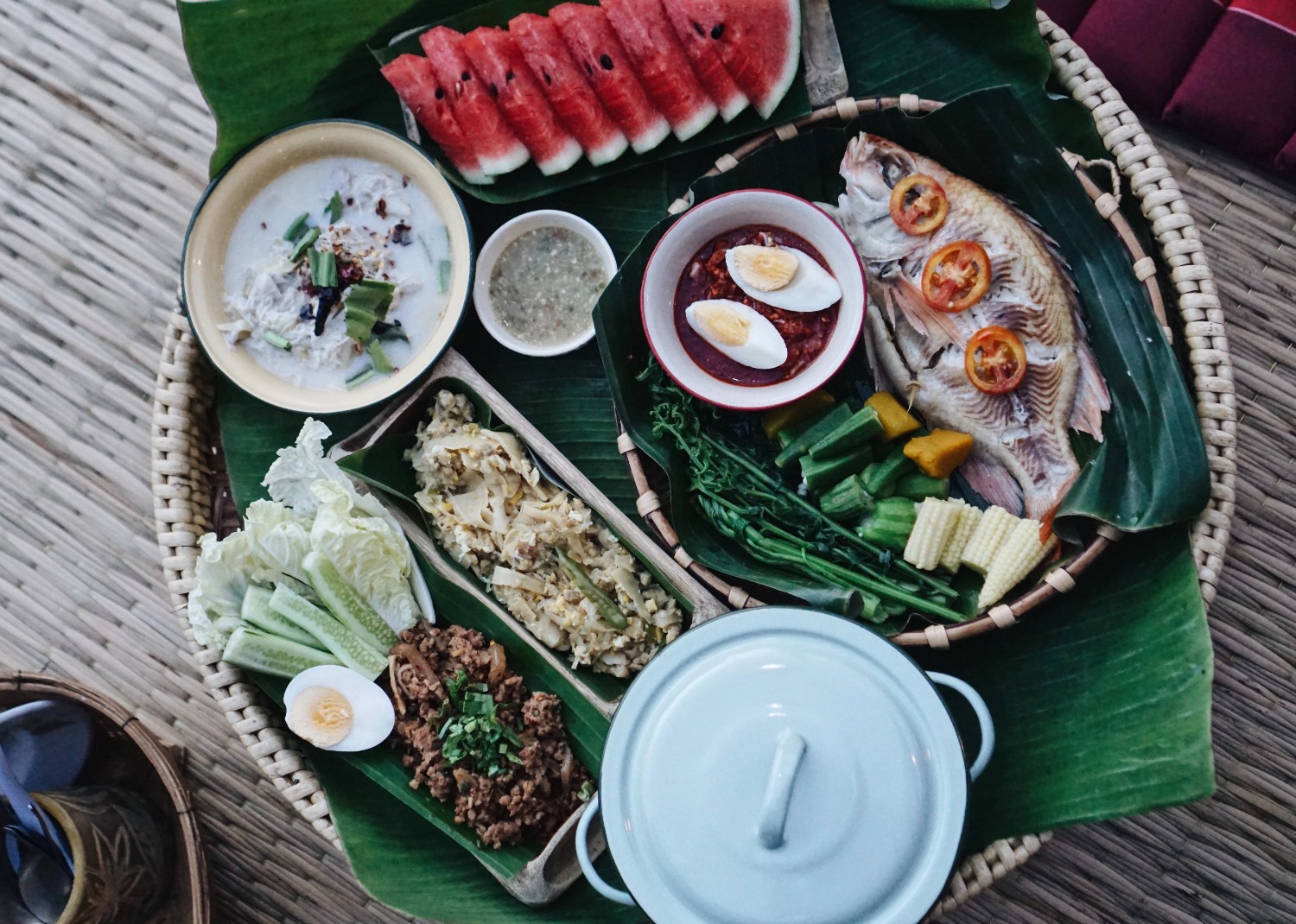
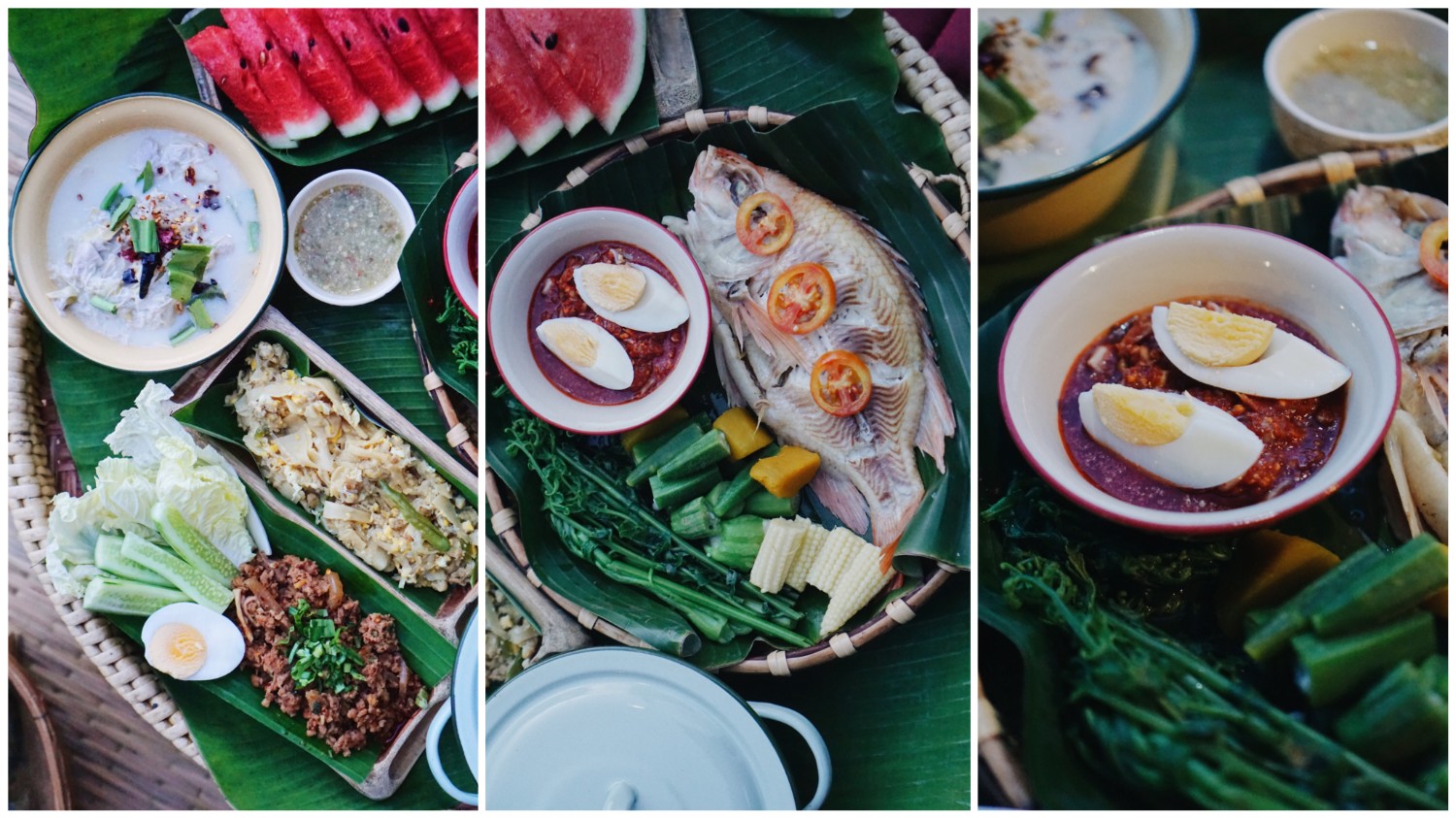
DAY 2: Witnessing the Sea of Mist at Huai Na Tawn Hai
The morning activities on the second day offer two options: participating in the morning alms offering (if there are religious events in the village, the monks may not be available for alms) or visiting the Huai Na Tawn Hai viewpoint to witness the sea of mist (weather permitting). If you choose to visit the viewpoint, inform your host during your stay. The cost for a guide and transportation to the starting point is 450 baht per house, with a maximum of 8 people. The host will provide complimentary coffee or Ovaltine in a bamboo tube and a flashlight. As I was traveling alone, I had to pay the full amount; there was no option to join a group from another house. Mr. Phong was my guide, and we departed at 4:00 AM. We drove to the starting point, 3.5 kilometers away, and then hiked for another 850 meters. The trail is quite steep, so those with health conditions should be cautious. There are wooden planks along the way for resting, but be sure to check with a flashlight before sitting down. Mr. Phong found a scorpion while checking with his flashlight. The weather was not cold, and I was sweating so much that my shirt was soaked. After about 25 minutes, I reached the top of Huai Na Tawn Hai. However, it was still dark, so I waited to see the sea of mist. It is advisable to bring mosquito repellent.

Above, there were instant noodles in bamboo cylinders and skewered bread for sale. The bread was 10 baht per slice, while the instant noodles in the carved bamboo cylinders were probably 20 baht. Today, we were very lucky to see the sea of fog. We waited for several rounds. At first, it seemed like it would come, but then the wind blew it away into a hazy mist. This happened several times. We waited until late morning and finally saw the sea of fog in the distance. Even just this made us happy. It was the first sea of fog we had seen this year. At around 7:00 AM, we asked Mr. Phong to take us down early because we had an appointment with Uncle Win, the motorcycle taxi driver, to pick us up at the center at around 8:15 AM. We had to make time for breakfast, showering, and packing.
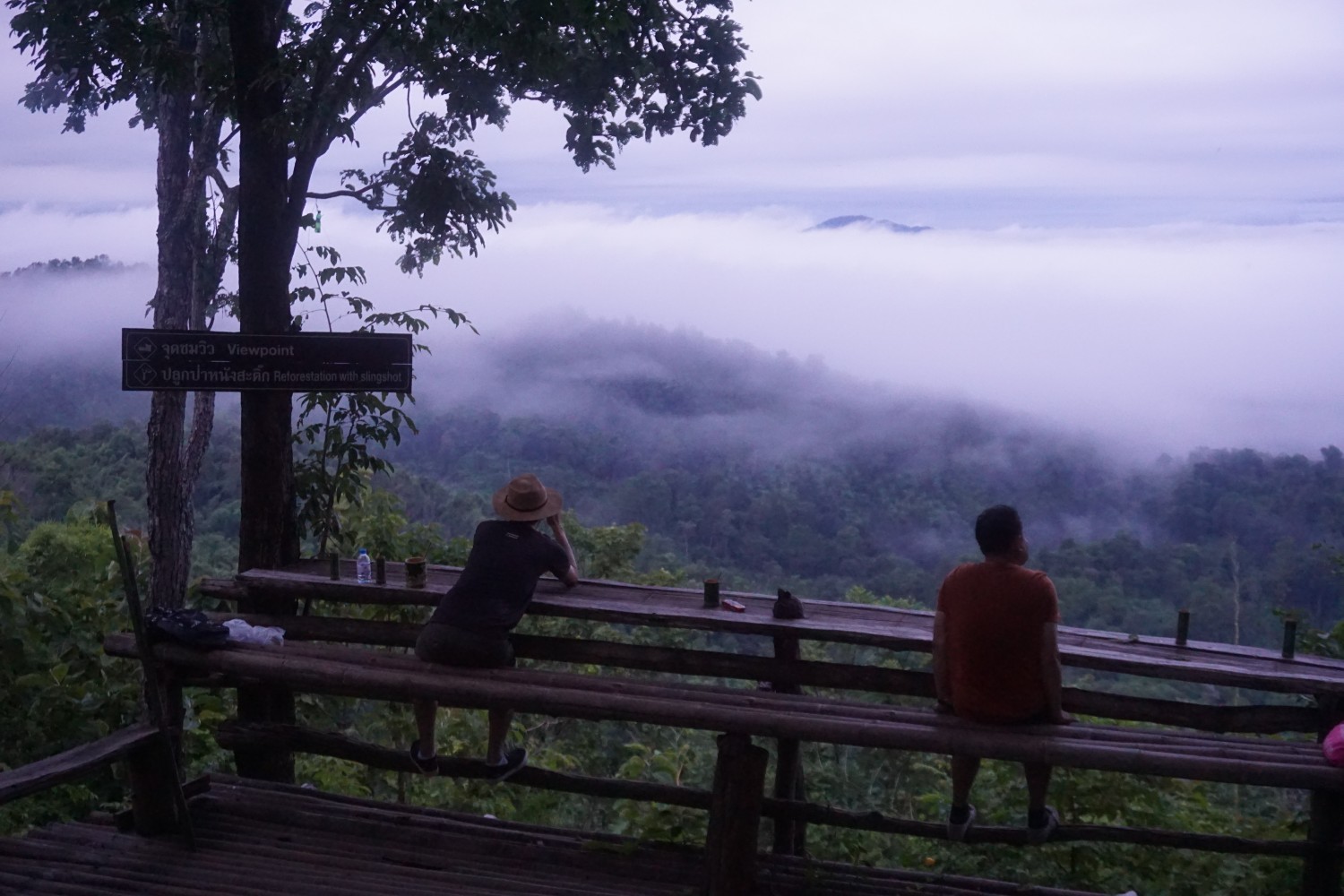
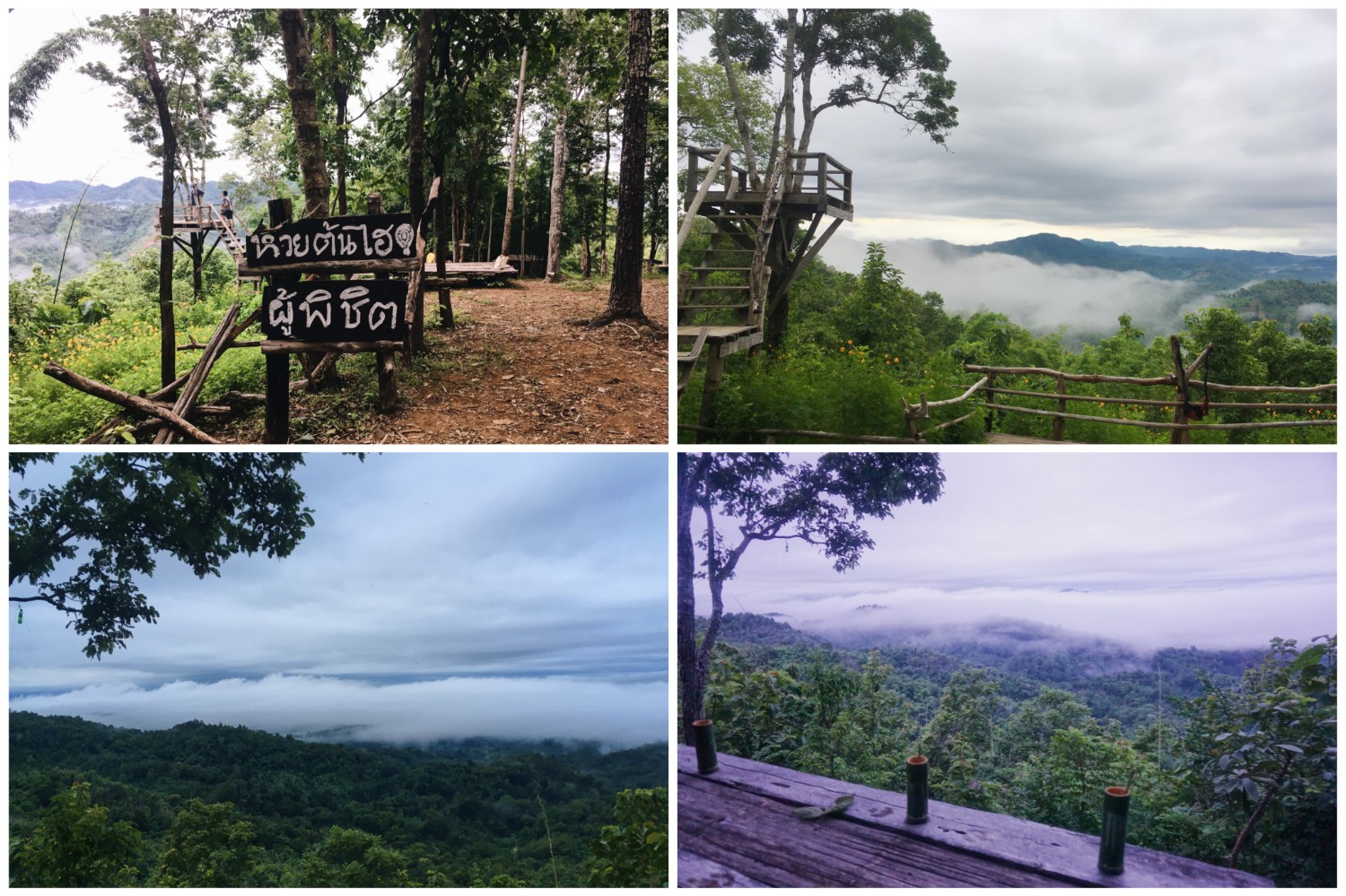
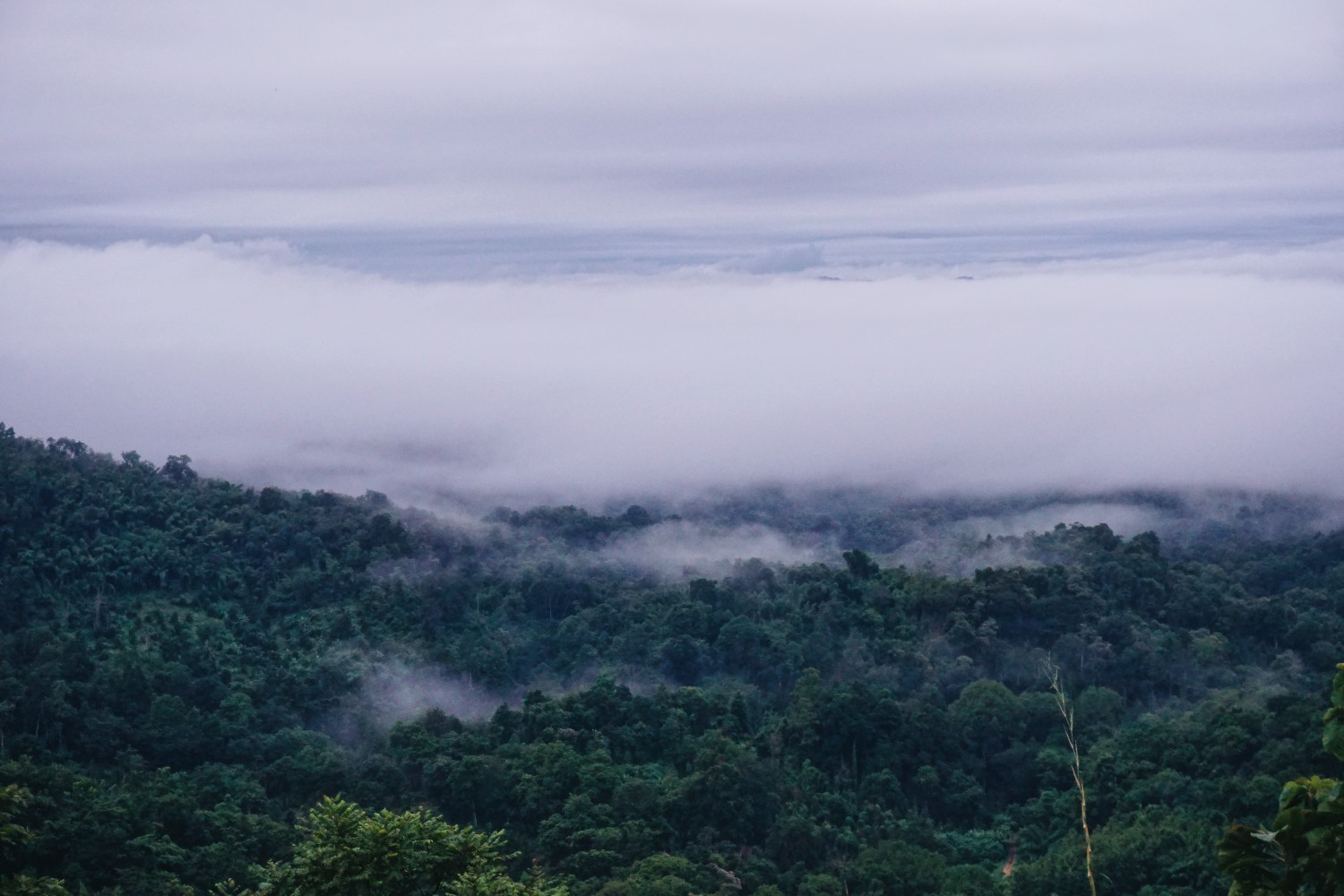
Here's a glimpse of the path, but be warned, it's much steeper in reality than it appears in the photo.

Another delightful breakfast. We were in a hurry, so we ate everything. Hehe. The focus was on the dishes rather than the rice. The menu included slightly salty fried pork (perfect with rice), fried pork sausage, clear soup with tofu and minced pork, stir-fried papaya with egg and soft-boiled egg, and the highlight was the "nam phrik ong" and "nam phrik num" with fresh vegetables. Both chili pastes were delicious. I usually don't like "nam phrik num" because I've had it before and it smelled green, but P'Tum's version didn't smell green and was easy to eat, even on its own. And the most unexpectedly delicious thing I've ever had was grilled eggplant. It wasn't bitter and had a fragrant grilled aroma. It was delicious with the chili paste. We finished with coconut jelly. The menu changes regularly, so friends who have been here and are planning a trip might not get the same dishes as us.
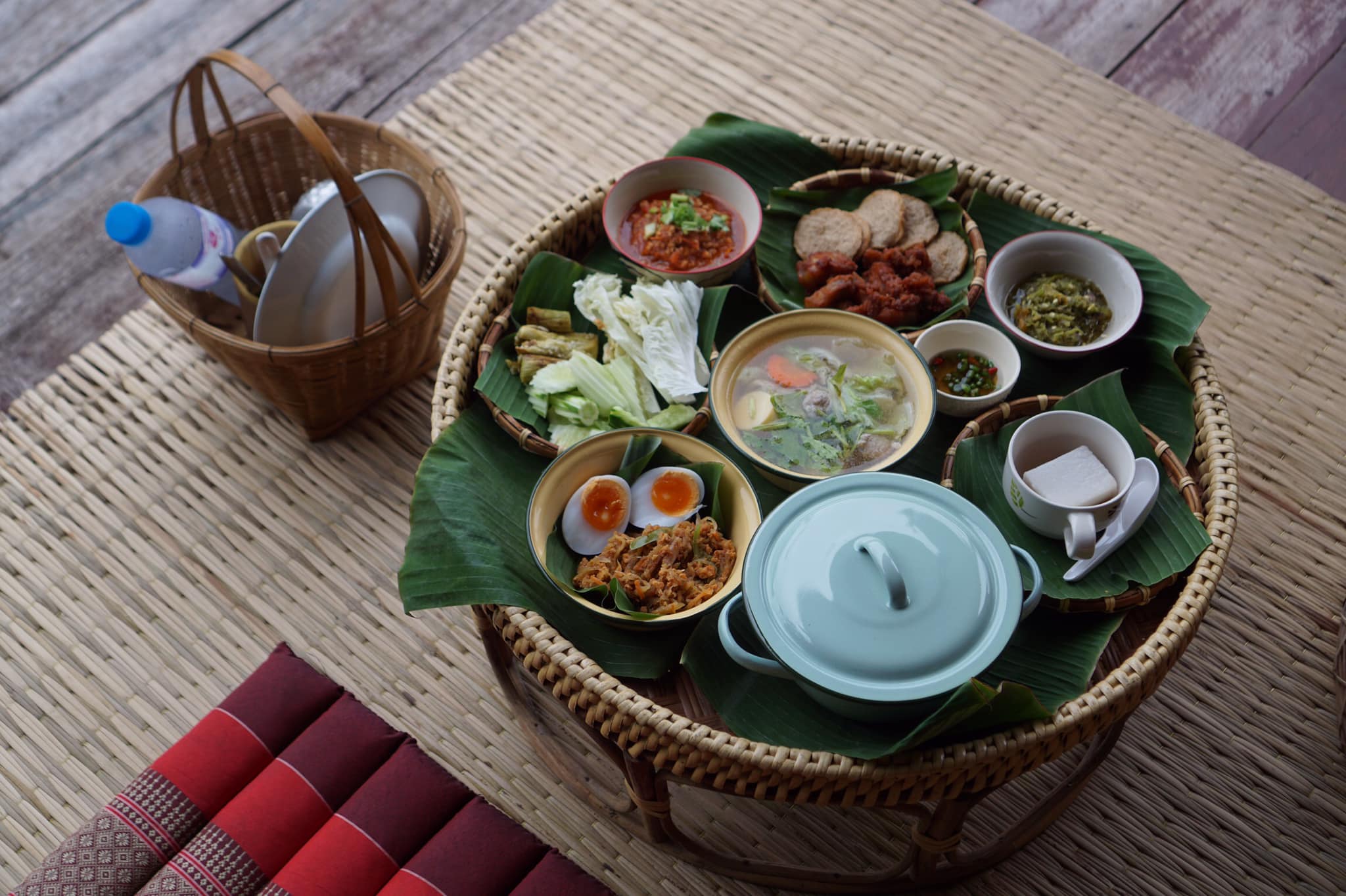

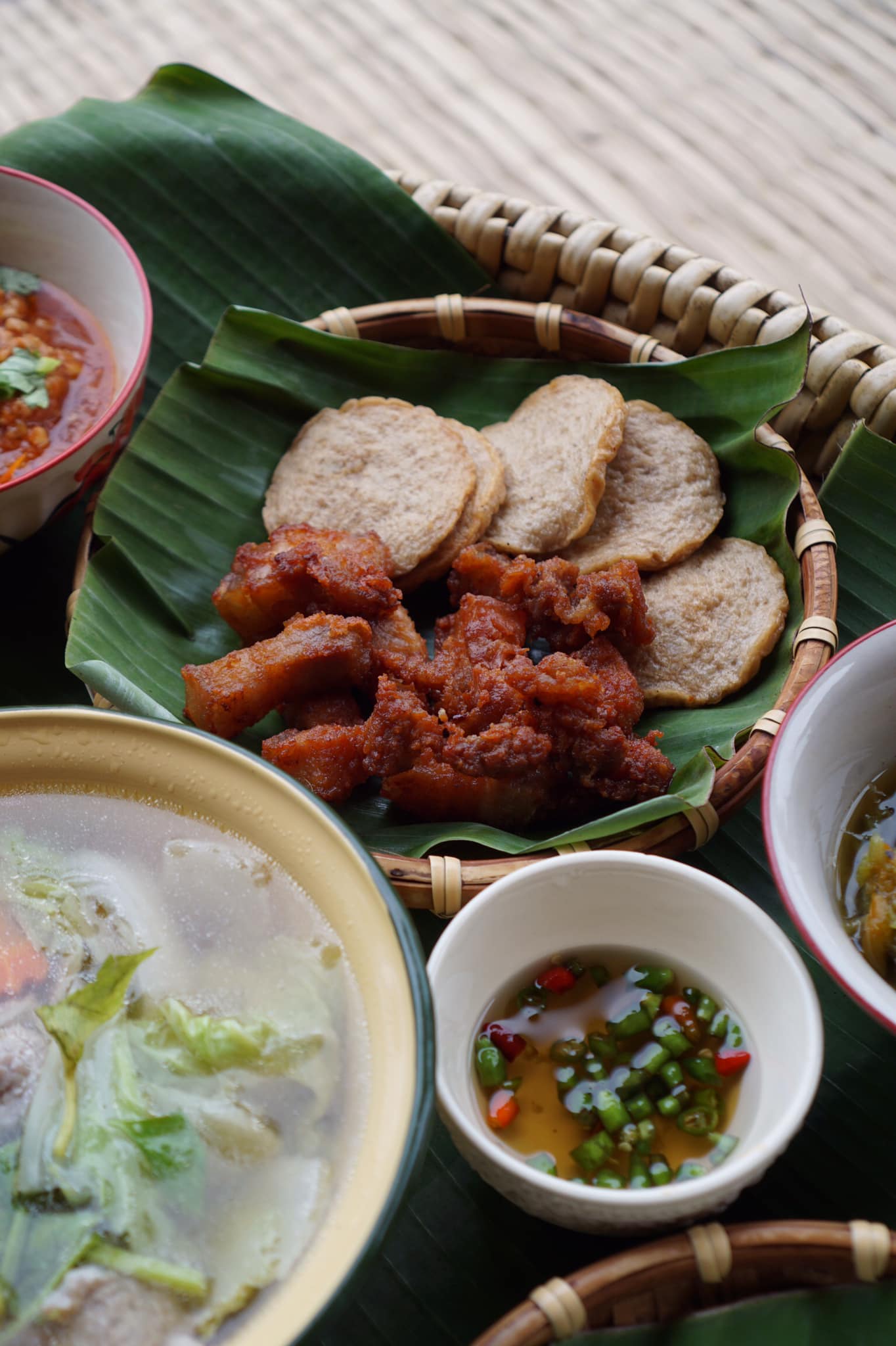
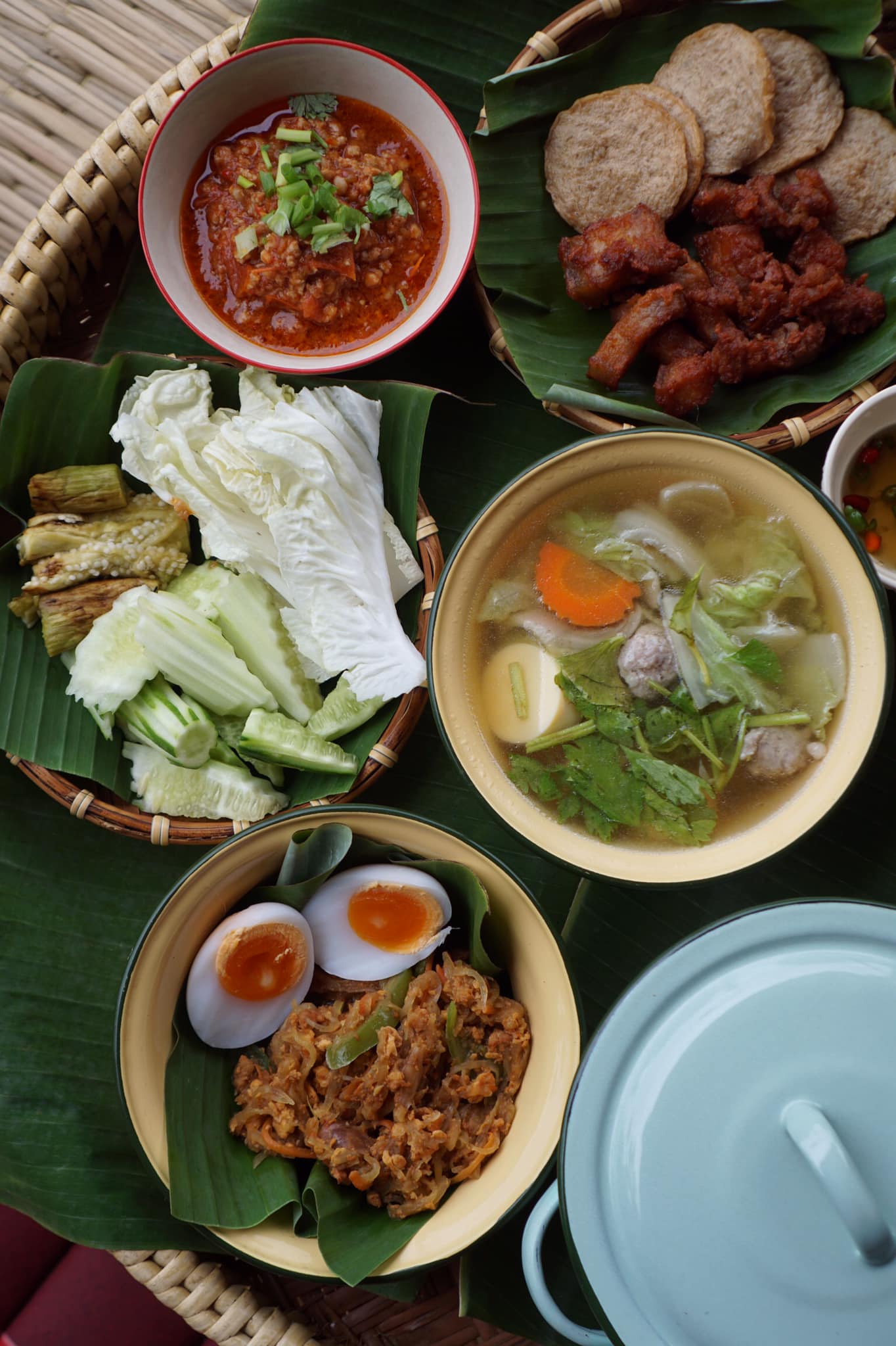
Journey to Sukhothai: A Solo Adventure
This journey to Sukhothai was a complete success, fulfilling all my expectations. I strive to travel solo at least once a year, as it presents challenges and broadens my horizons. Sukhothai proved to be an ideal destination for solo travel, even without a personal vehicle. It's easily accessible, safe, and offers a plethora of activities.
My first day began with an alms offering at the Saphan Boon Bridge, followed by a bicycle tour of the Sukhothai Historical Park. I then took a bus to Ban Na Ton Chan, where I explored the community by bike and enjoyed a delicious dinner and comfortable sleep. Waking up to a breathtaking sea of mist, I returned to Bangkok in the evening, leaving enough time to rest before work.
The highlight of the trip was the homestay experience at Ban Na Ton Chan. For just 600 baht, I enjoyed a night's stay with dinner and breakfast included. This price applies even for solo travelers, showcasing the community's organized approach to tourism. They distribute income effectively, allowing residents with comfortable homes and culinary skills to host guests. Local guides lead tours, and community-made products are available for purchase. Those who farm or garden contribute ingredients, while others use their vehicles for transportation. Each homestay boasts beautiful decor, and innovative tourism options like catering to groups who only come for lunch without an overnight stay are available.
Safety is prioritized, as all homestays meet required standards. The only downsides to solo travel are the occasional need to pay full price for certain things, the time spent waiting for connecting transportation, and the limitations of public transport.
I extend my gratitude to P'Tum and P'Phong for their delicious meals and warm hospitality throughout my stay. I hope to return to Ban Na Ton Chan soon.
Regarding the power bank I left on the BKS bus, I was able to retrieve it by meeting the driver at the Mo Chit bus terminal. My thanks go to the driver and the BKS coordinator for their assistance.
Expenses:
- Homestay (1 night with dinner and breakfast): 600 baht
- BKS bus (Bangkok - Sukhothai Historical Park): 337 baht (booked online, paid at 7-Eleven) + 20 baht = 357 baht
- Motorcycle taxi (BTS Mo Chit to Mo Chit bus terminal): 60 baht
- Personal items at 7-Eleven: 75 baht
- Alms offering set at the morning market: 105 baht
- Toilet: 3 baht
- Coffee, sticky rice, and deep-fried dough sticks: 28 baht
- Bicycle rental: 30 baht
- Historical park entrance fee (1 person + 1 bike): 30 baht
- Donation: 40 baht
- Soft drink: 15 baht
- Freshly brewed coffee: 40 baht
- Wat Si Chum entrance fee: 20 baht
- Minibus to Sukhothai bus terminal: 20 baht
- Bus to Si Satchanalai: 49 baht
- Motorcycle taxi roundtrip (Hat Sai and Na Ton Chan): 320 baht
- Khao Phip, Khao Pahn, and water: 95 baht
- Bicycle rental in the village: 30 baht
- Guide to the viewpoint: 450 baht
- Snacks for the young guide and Nang Paeng: 160 baht
- Bread for photos at the viewpoint: 10 baht
- Coffee at the Win Tour bus stop: 15 baht
- Win Tour bus (Hat Sai - Bangkok): 449 baht
- City bus: 16 baht
Total: 3,017 baht
Thank you for reading this far. I hope this will be helpful for your travel planning.
You can read other reviews from us at https://th.readme.me/id/PangJourney
Or follow us on our Facebook page
https://www.facebook.com/KeepGoingThailand/
แป้งเจอนี่เจอนั่น
Friday, November 8, 2024 4:06 PM










